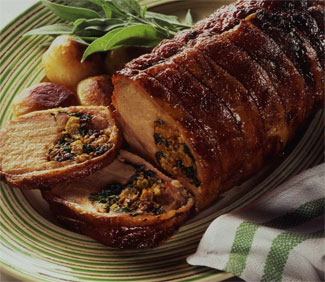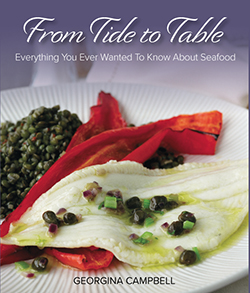Article IN SEASON
Oysters
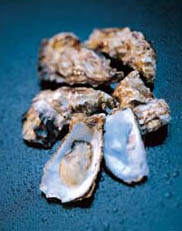
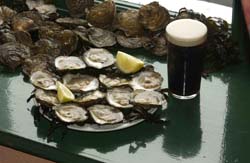 Of the many good things September brings, one of the most exciting is the new native oyster season. Very much associated with the west of Ireland, especially Galway, its arrival is celebrated every year by the Galway International Oyster Festival – the 55th festival (www.galwayoysterfest.com), takes place over 24-27th September 2009. The most eagerly anticipated (and hotly contested) competition is always the Guinness World Oyster Opening Championship, in which contestants race to open 30 oysters and present them correctly. The fastest Irish entry in 2008 (not for the first time), was Michael Moran of Morans on the Weir (aka Morans Oyster Cottage) at Kilcolgan, where they also have their own oyster beds – and Gerry Cahill of Morans Oyster Fisheries was placed 7th.
Of the many good things September brings, one of the most exciting is the new native oyster season. Very much associated with the west of Ireland, especially Galway, its arrival is celebrated every year by the Galway International Oyster Festival – the 55th festival (www.galwayoysterfest.com), takes place over 24-27th September 2009. The most eagerly anticipated (and hotly contested) competition is always the Guinness World Oyster Opening Championship, in which contestants race to open 30 oysters and present them correctly. The fastest Irish entry in 2008 (not for the first time), was Michael Moran of Morans on the Weir (aka Morans Oyster Cottage) at Kilcolgan, where they also have their own oyster beds – and Gerry Cahill of Morans Oyster Fisheries was placed 7th.  Although they may once have been so plentiful that they were the everyday food of the ordinary people, oysters have long been associated with luxury (decadence, even!) and Irish oysters are very highly regarded internationally. Indeed, some of the most famous restaurants in Europe feature oysters from both Galway (native) and Carlingford (gigas) on their menus – at The Seafood Restaurant, Rick Stein’s iconic fish restaurant in Padstow, for example, they sit easily alongside those from the River Fal in Cornwall, which are famously harvested only under sail, providing a unique and foolproof conservation measure. (Wouldn’t it be a good idea to adopt a similar scheme here for harvesting turf – if cut only by hand, the damage would automatically be minimal.)
Although they may once have been so plentiful that they were the everyday food of the ordinary people, oysters have long been associated with luxury (decadence, even!) and Irish oysters are very highly regarded internationally. Indeed, some of the most famous restaurants in Europe feature oysters from both Galway (native) and Carlingford (gigas) on their menus – at The Seafood Restaurant, Rick Stein’s iconic fish restaurant in Padstow, for example, they sit easily alongside those from the River Fal in Cornwall, which are famously harvested only under sail, providing a unique and foolproof conservation measure. (Wouldn’t it be a good idea to adopt a similar scheme here for harvesting turf – if cut only by hand, the damage would automatically be minimal.)  Of the two species of oyster grown in Ireland, the flat native Irish oyster (Ostrea edulis) grows naturally on tidal sea beds and is also cultivated in managed plots. About 35 years ago, due to a decline in native stocks, Gigas (Crassostrea gigas), the oval frilly-shelled Pacific oyster, was introduced and is now the main species in Ireland - cultivated by about 200 enterprises in 11 coastal counties. Like mussels, oysters are not fed by the growers but take their nourishment naturally from the sea in exactly the same way as wild oysters – a lengthy process that depends on the highest water quality for its success, and takes a lot of care and patience on the part of growers. Unlike the native Irish oyster, Gigas are available all year – but, like their smaller wild cousins, they are best in the colder months.
Of the two species of oyster grown in Ireland, the flat native Irish oyster (Ostrea edulis) grows naturally on tidal sea beds and is also cultivated in managed plots. About 35 years ago, due to a decline in native stocks, Gigas (Crassostrea gigas), the oval frilly-shelled Pacific oyster, was introduced and is now the main species in Ireland - cultivated by about 200 enterprises in 11 coastal counties. Like mussels, oysters are not fed by the growers but take their nourishment naturally from the sea in exactly the same way as wild oysters – a lengthy process that depends on the highest water quality for its success, and takes a lot of care and patience on the part of growers. Unlike the native Irish oyster, Gigas are available all year – but, like their smaller wild cousins, they are best in the colder months.RECIPES
Oysters Sashimi-Style
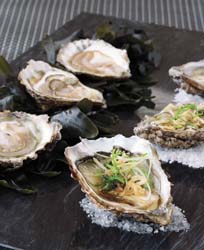 This recipe from Kevin Dundon of Dunbrody Country House Hotel and Cookery School, County Wexford, is typical of the kind of dish you might expect at the Harvest Room Restaurant, or the informal Dunbrody Seafood Bar & Terrace – and it’s a great way to introduce oysters to your guests.
This recipe from Kevin Dundon of Dunbrody Country House Hotel and Cookery School, County Wexford, is typical of the kind of dish you might expect at the Harvest Room Restaurant, or the informal Dunbrody Seafood Bar & Terrace – and it’s a great way to introduce oysters to your guests. Don’t be put off by the thought of opening the oysters; an oyster knife - a sturdy knife with a short blade - is a good investment if you like oysters and are likely to serve regularly.
Click for recipe
Oysters Bloody Mary
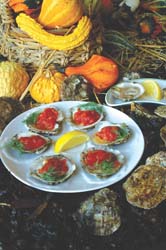 Bloody Mary is a classic accompaniment for oysters, so Aidan MacManus of The King Sitric Fish Restaurant in Howth, Co Dublin, uses the idea for a sauce. He uses native west coast oysters for this dish whenever possible, although rock oysters (Gigas) - which are farmed not far away in Carlingford Lough - can be used instead.
Bloody Mary is a classic accompaniment for oysters, so Aidan MacManus of The King Sitric Fish Restaurant in Howth, Co Dublin, uses the idea for a sauce. He uses native west coast oysters for this dish whenever possible, although rock oysters (Gigas) - which are farmed not far away in Carlingford Lough - can be used instead. When using rock oysters, select them as small as possible.
Click for recipe
Pumpkins & Squash
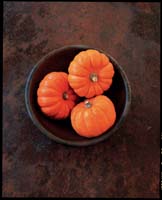
 No other food epitomises the plenty of autumn like the glorious orange pumpkin - although we may be inclined to underrate its many less flamboyant but very delicious cousins in the extended squash family.
No other food epitomises the plenty of autumn like the glorious orange pumpkin - although we may be inclined to underrate its many less flamboyant but very delicious cousins in the extended squash family.The pumpkin is synonymous with Hallowe’en, and the bigger the better - but, once they’ve been hollowed out, shaped into the traditional spooky face and filled with candles, thousands of families are left with a lot of lovely pumpkin flesh that’s looking for a use.
Look no further than Brian Glover’s beautiful little book, Cooking with Pumpkins and Squash (Ryland Peters & Small, stg£9.99); he explains the diversity of the fascinating cucurbitaceae family - it includes cucumbers, melons and gourds as well as the myriad varieties of squash, ranging from tiny finger-sized courgettes to ‘huge, heavyweight pumpkins that reach the weight of a grown man’.
Brian, a food writer and gardener with a passion for fresh, seasonal food, clearly delights in this versatile ingredient, seeking out the best cooking method for each one, suggesting the flavours that have the best affinity with squashes and pumpkins – and passing his knowledge on in accessible, must-do recipes that are the essence of autumn – a mood beautifully captured by Peter Cassidy’s evocative photography.
Images and recipes courtesy of Ryland Peters & Small, (£9.99 in UK) from COOKING WITH PUMPKINS AND SQUASH by Brian Glover with photography by Peter Cassidy (£9.99 in UK)
Roasted
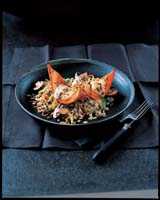 squash with Leek & Barley Pilaf
squash with Leek & Barley PilafSquash and leeks share a similar vegetable sweetness that makes them very good bedfellows. The comforting feather mattress here is the earthy nuttiness of barley, but you could also cook spelt grains (farro) in the same way. All it needs is a green salad in a mustardy soured cream dressing, with a few toasted walnuts tossed through.
Click for recipe
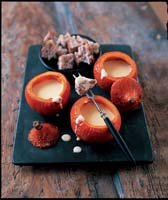 Pumpkin Fondue
Pumpkin FondueServing fondue in a baked pumpkin shell is not just about fun presentation – the sweet, tender squash is wonderful with the salty, sharp richness of the cheese. Either use a whole, large pumpkin for everyone to dip into or small individual squashes. Serve with cubes of crusty bread for dipping and spoons for scraping the baked squash from the shell. The cheese you use is up to you. I like a mixture of a Gruyere-like cheese (Emmental, Beaufort or Irish Coolea) with a softer cheese such as Taleggio or Fontina.
Click for recipe
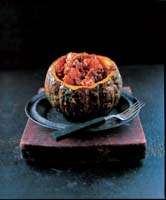 Beef Stew with Squash, Sweetcorn & Chilli
Beef Stew with Squash, Sweetcorn & ChilliSquash, corn and chilli form the holy trinity of southern States cooking. And here they are added to a beef stew that’s packed with spicy flavour and given added richness by the last-minute addition of dark chocolate. You could serve this in a hollowed-out pumpkin shell for real impact.
Click for recipe
Images and recipes courtesy of Ryland Peters & Small, (£9.99 in UK) from COOKING WITH PUMPKINS AND SQUASH by Brian Glover with photography by Peter Cassidy (£9.99 in UK)
Pheasant
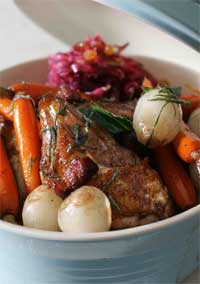
 Autumn and winter bring many treats to the kitchen and, for many people, wild game is one of the most exciting. What fun it used to be walking down past Sawyers in Chatham Street, when all the feathered and furred game was hung up on display, the beautiful pheasants with their tail feathers on and a kaleidoscope of colours gleaming in the winter sun – as good a reason for going in Dublin as there could be, yet all that is banned now.
Autumn and winter bring many treats to the kitchen and, for many people, wild game is one of the most exciting. What fun it used to be walking down past Sawyers in Chatham Street, when all the feathered and furred game was hung up on display, the beautiful pheasants with their tail feathers on and a kaleidoscope of colours gleaming in the winter sun – as good a reason for going in Dublin as there could be, yet all that is banned now. But that hasn’t quite spelt the end of wild game, which is supplied oven-ready in season to good specialist shops and supermarkets by, for example, the Wicklow company, Wild Irish Game.
However, while it may not be too hard for the home cook to get hold of a few pheasants for a dinner party (or, if you’re lucky, get a friend or relative who shoots to leave in the occasional brace), it may not be so easy for restaurants, where regular supplies are essential. In his new book, ‘Keeping It Simple’ Derry Clarke of l'Ecrivain Restaurant laments that “It’s becoming harder and harder to source wild pheasant, which is very reasonably priced when in season (October to January). While farmed pheasant is readily available, it is not as flavoursome as the wild bird.”
But, whether you use farmed or wild birds, the interesting ingredients and gentle cooking should ensure that this recipe from Keeping It Simple will be moist and have plenty of flavour; ideal for a dinner party, it might make also an interesting alternative for Christmas if numbers are too small for turkey (and will certainly be a lot easier to serve). A decent pheasant is like a small chicken and should serve two comfortably.
 Pheasant roasted with Smoked Bacon and Sage, with Red Cabbage Salad
Pheasant roasted with Smoked Bacon and Sage, with Red Cabbage Salad
Red cabbage is great with game. In this dish, the red cabbage is used in a salad for a lighter meal, but you could also serve it with slowly braised red cabbage.
Click for recipe
Chestnuts

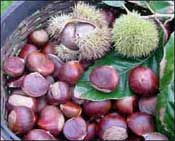 The image of “Chestnuts roasting on an open fire…” pretty much sums up the best and cosiest of winter activities, especially the sociability of the festive season.
The image of “Chestnuts roasting on an open fire…” pretty much sums up the best and cosiest of winter activities, especially the sociability of the festive season. Not to be confused with the unrelated and inedible horse chestnuts which grow prolifically in Ireland, the European sweet chestnut, Castanea sativa, is actually a cousin of the beech.
Despite their nut-like appearance and floury texture, chestnuts have a high water content and need to be treated as perishable fruits rather than hard nuts, ie kept cool in storage and used while quite fresh, before they lose too much moisture.
In Britain and Ireland chestnuts are associated particularly with the Christmas period and available for only a short time; once commonly roasted in the streets (and not so long ago – I can remember them for sale in Grafton Street…), roasting is still the best-known cooking method in these islands.
The skin is scored beforehand to prevent an explosion when the contents expand in heat; when cooked and cool enough to handle, the skin and inner husk is peeled away to reveal nutritious nutty flesh, which has a deliciously delicate, sweet flavour and is gluten- and cholesterol-free. More surprisingly, and unlike other nuts, chestnuts are quite high in vitamin C, especially when dried.
Chestnuts are an extremely versatile food and although in continental Europe, where they are widely available, they had fallen from favour to some extent in recent decades (possibly because of a past association with poverty), they are now making a comeback along with renewed interest in traditional cooking and natural foods.
They can be bought fresh, dried, ground, vacuum packed and canned (both whole and as a sweetened or natural purée); in Ireland, fresh chestnuts are available in autumn and canned ones (eg Clément Faugier or Epicure) all year; dried and ground product can also be found in some specialist food shops.
The uses of chestnuts in both sweet and savoury dishes are very varied and include many dishes made with chestnut flour, as well as stuffings made with chopped nuts (traditional for goose and turkey), whole chestnuts used to enliven vegetables dishes (eg Brussels sprouts) and, of course, the wonderful Christmas treat of marrons glacé – which dates back to the 16th century and takes many months to produce, using a candying method which is still very labour intensive.
Another old favourite is mont blanc, an irresistible dessert popular in France where (although it can of course be made from fresh chestnuts) it often consists only of canned sweetened chestnut purée and chilled crème fraîche - yet it is impossibly delicious.
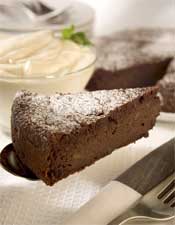 Chestnut and chocolate cake
Chestnut and chocolate cakeA rich, moist chocolate dessert cake – this could be the perfect alternative to Christmas Pudding for those who dislike dried fruit.
Click for recipe
Scallops
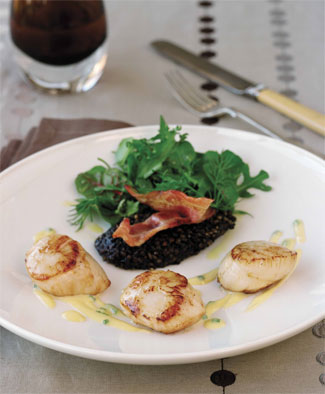
 What are they?
What are they? Scallops are bi-valve molluscs, easily recognisable by their pretty radially ribbed shells which (although this is out of fashion at the moment) can used for presentation; the shells are also useful for cooking and serving other small fish dishes, and there was a time when they were widely used as ash trays...They have a subtle, sweetish flavour and very dense pearly-white flesh.
Where do they come from?
Scallops are fished around the Irish coast especially in winter and spring. As itemised on some top restaurant menus, the most desirable (and most expensive) are ‘hand dived’, ie they are picked by hand by individual scuba divers, which is very ecologically correct as it is so selective and does not cause damage to the underwater environment. Only the best are selected and it is also slow work, hence the higher price.
Where can I get them?
They are easily available available from fishmongers, both in and out of the shell. ‘Queenies’ are the small scallops most widely available (often sold shelled and frozen), and the prime king scallops have a beautiful orange-red ‘coral’ (roe), which is at its brightest and best in winter and early spring, and should be left intact; it is widely regarded as a great delicacy although, sadly, modern Irish chefs do not always see it that way and often discard the coral entirely.
What can I do with them?
If buying scallops in the shell, choose those that are tightly closed and feel heavy for their size. To open, warm them a little until the shells open naturally, then remove the black part and gristly fibre.
Scallops are widely used in both first course and main course dishes but, because of their dense flesh, are best suited to starters and light salad dishes.
They have an affinity with a number of ingredients, including bacon, mushrooms and Jerusalem artichokes, and are best cooked very briefly (whole or sliced) in a hot pan with a little butter or oil; do not overcook as they quickly become rubbery and lose their fresh flavour and beautiful translucent appearance. They can also be sliced very thinly and eaten raw (in a mushroom salad, perhaps).
Traditional dishes like Coquille Saint Jacques (with mashed potato and cheese sauce) are currently out of favour, but they do have the advantage of offering a more balanced combination which offsets the natural heaviness of a large quantity of scallops, so perhaps should not be dismissed out of hand.
Recipe for Seared Scallops with Black Pudding and Crispy Bacon
Grainy Clonakilty black pudding from West Cork has become a favourite accompaniment for scallops in recent years, and is delicious served with bacon and classic beurre blanc sauce.
Click for recipe
Smoked Haddock
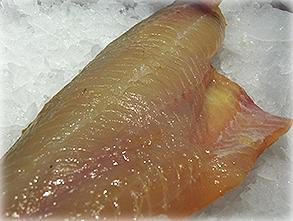
 A brilliant fish at any time, smoked haddock is especially welcome in the early months of the year, when storms may affect supplies of fresh fish. The essence of cold-weather comfort food, it’s at its best in dishes like creamy fish pies and steaming chowders, bubbling smokies and less usual breakfast dishes such as kedgeree.
A brilliant fish at any time, smoked haddock is especially welcome in the early months of the year, when storms may affect supplies of fresh fish. The essence of cold-weather comfort food, it’s at its best in dishes like creamy fish pies and steaming chowders, bubbling smokies and less usual breakfast dishes such as kedgeree.Mainly from the North Atlantic, melanogrammus aeglefinus is a fish of the cod family and is processed in numerous places, including Ireland. The traditional preservation methods are drying and smoking; smoked haddock is so popular in France that when ‘haddock’ is referred to it means smoked, not fresh, haddock.
Quality smoked haddock is undyed, and the benchmark for naturally smoked haddock is usually taken to be ‘Finnan haddies’, which were traditionally smoked over peat in the fishing village of Finnan, near Aberdeen; similar products are now widely available and produced by methods using varying amounts of traditionalism, although all are cleaned, split and brined before the smoking process.
Well known styles include ‘Glasgow pales’ which are removed from the smoke when they are still a very pale colour, and Arbroath smokies (sometimes also made with whiting), which are hot-smoked in pairs until the skins are copper-brown, but the flesh is still very pale.
Like its cousin smoked cod, smoked haddock is widely available from fishmongers and the wet fish counters in supermarkets. Look for a natural, undyed smoke – it is easy to tell as the flesh is quite pale in comparison with the more usual bright orange dyed ‘smoked’ fish.
Smoked white fish, especially haddock, is one of the most useful and versatile winter seafoods – an ideal ingredient mixed off with other fish and shellfish in mixed seafood dishes like chowders, pies, ragoûts and cassolettes, and also good on its own served with, for example, cabbage and a creamy mustard sauce.
It teams beautifully with eggs and, together with rice and hard-boiled eggs, it’s one of the key ingredients in the traditional breakfast dish kedgeree – and lightly poached smoked haddock is seriously more-ish served with poached eggs on toast. It also makes a delicious starter – in, for example, ‘smokies’, which are made with tomato concassé, smoked haddock and melting cheese, served hot…
For further ideas and recipes, see the consumer section of the Bord Iascaigh Mhara website
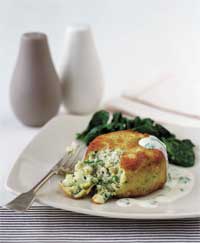 RECIPE for Smoked Haddock Fish Cakes
RECIPE for Smoked Haddock Fish CakesYou could use a mixture of fish for this recipe, or you could just use one variety, and increase the quantity. Don’t over-process the fish cake mixture, as it’s nice to see chunks of fish when you cut the fish cake open. If you are going to make a parsley sauce, reserve the poaching liquid from the fish and use instead of some of the milk.
Click for recipe
Beef

 With St Patrick’s Day the highlight of this often chilly month, there’s nothing to beat one of our really traditional dishes, such as a warming bowl of Irish Stew, a plate of bacon and cabbage or a beef and Guinness casserole.
With St Patrick’s Day the highlight of this often chilly month, there’s nothing to beat one of our really traditional dishes, such as a warming bowl of Irish Stew, a plate of bacon and cabbage or a beef and Guinness casserole. The Irish midlands, especially Co Westmeath, are renowned for the quality of beef raised in the area – and sold by butchers such as C R Tormeys of Mullingar (& Tullamore), who attract customers from a wide area; although they sell a wide range of excellent Irish-produced meats and poultry, including midlands lamb and pork and chicken from the west of Ireland, they are known especially for their pasture-raised, dry-aged heifer beef (under 24 months), and rightly promote it as a healthy, tender and flavoursome food, rich in protein, iron, zinc and B vitamins.
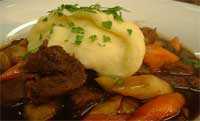 Beef and Guinness Stew
Beef and Guinness StewThis recipe features in Irish Country House Cooking (Epicure Press €25). It is the Wineport Lodge take on traditional Beef & Guinness casserole – the prune juice and orange are not essential, but they add an extra richness to the flavour.
If you like the idea of cooking with rare breed meat such as Long Horn and your butcher doesn’t stock it, order online from www.simplysourced.net; their slow cooking Long Horn beef boxes begin at €30.
Click for recipe
Rhubarb

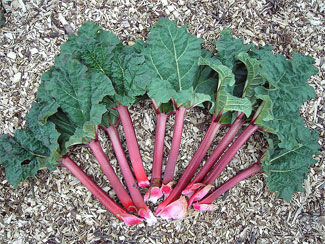 What is it?
What is it? Although usually used in sweet dishes, rhubarb is not a fruit but classed as a vegetable. It grows easily in Ireland and is still a familiar feature in gardens all over the country. It dies down in winter and now, as it begins to re-emerge for the new season (later than usual this year, due to the prolonged cold weather over the winter), the new stalks will be at their pinkest and most tender.
To get the most of this early crop, rhubarb crowns can be forced. To do this, the crowns are protected with newspaper or straw then covered - ideally with beautiful clay pots made especially for the purpose, but anything like large upturned boxes or bins will do; the stems then shoot up much earlier than usual and are exceptionally pink and sweet.
For an even earlier crop the crowns can be dug up in the late autumn, re-planted in large pots (or simply in black plastic bags) and brought in to a shed or greenhouse, then covered to exclude light.
Where can I get it?
Although the timing of all fresh produce is hard to predict this year as spring is on average a month later than usual, forced rhubarb is usually easy to find in early spring when the bright pink stems are to be seen on the shelves of greengrocers and supermarkets, and they should also be available from stalls at farmers’ markets.
Early varieties of ‘regular’ rhubarb are usually available from February-March until late summer too.
What can I do with it?
Forced rhubarb can be cooked in any of the ways used for mature rhubarb later in the season but the pink new season stems are so pretty that it is best to choose cooking methods that show them off to advantage. The early ‘fruit’ is not as bitter as the later crop so less sugar is needed in cooking, and it has an affinity with orange juice, which will add natural sugar.
To use as a compote, cook it very gently (eg in a slow cooker) so that it doesn’t break up, with water and/or orange juice and a little ordinary sugar (the sweetness can be adjusted at the end); show it off in a glass bowl and serve with crème fraiche.
It also looks very pretty in traditional pies and crumbles, or used as a sauce - with oily fish such as mackerel, for example.
RECIPE:
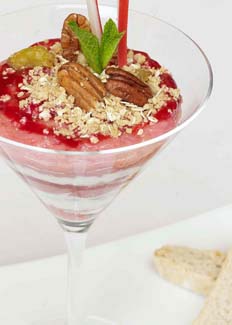 Rhubarb Fool with Yoghurt & Granola
Rhubarb Fool with Yoghurt & GranolaThis simple seasonal recipe was created for the 2009 Eat Smart Week by Derry Clarke of the renowned Dublin restaurant, L'Ecrivain - which underwent a major refurb in April 2010.
Click for recipe
Eggs
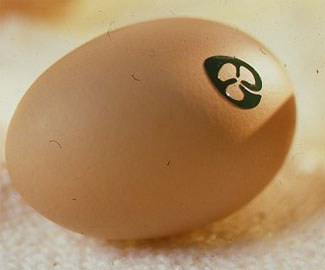
 Eggs are available all year, but their natural season is spring and this is a good time to remind ourselves to make the most of them, and to look at how this most versatile of foods works with other seasonal ingredients.
Eggs are available all year, but their natural season is spring and this is a good time to remind ourselves to make the most of them, and to look at how this most versatile of foods works with other seasonal ingredients. The ultimate natural convenience food, eggs are perfectly packaged and easily stored, and they provide a reasonably priced source of protein so the basics of an easy, quick and nourishing meal are always to hand.
Eggs are high in protein and vitamins A, B, D and E and provide a good source of iron, zinc, selenium and phosphorus – but they have had a bad press in recent years, in relation to cholesterol.
However, consultant nutritionist Paula Mee says that, “Many people will be surprised to learn that two thirds of the fat found in eggs is the healthy unsaturated kind. The main fat found in eggs is monounsaturated which has the capacity to lower LDL cholesterol (the bad type) and raise HDL cholesterol (the protective type). So those on a cholesterol lowering diet can still enjoy 4-6 eggs a week.”
Then, assuming that you’re not one of the growing number of back garden hen keepers with a supply of your own, there is the question of which eggs to buy, as they are not all the same.
Many people prefer to know that the eggs they use have come from happy hens – and anyone who has compared organic, free-range eggs with ordinary intensively produced eggs will know the difference in natural colour, texture and taste (although artificial colouring can be added to battery eggs unfortunately, which is misleading).
Less well known is the fact that the cooking qualities are also different, with free range eggs giving better volume and texture than battery eggs, as well as superior flavour.
It is always wise to choose Quality Assured eggs if possible - Ireland is one of only four EU countries (the other three are Scandinavian) which have an EU approved salmonella plan. This places Ireland in the world premier league in terms of salmonella prevention and control.
Under the plan all egg farms are tested and monitored by the Department of Agriculture and Food. But, contrary to popular perception, buying eggs produced under the Bord Bia Quality Assurance Scheme does not mean that they have to come from very big producers – there are Approved organic and/or free range producers in the scheme, some of which will be smaller producers; names to look out for include:
Ballon Free Range Eggs (059 915 9177) Co Carlow,
Castle Free Range Eggs (071 985 1280) at Ballyshannon, Co Donegal;
Claremorris Free Range Eggs (094 936 2652), Co Mayo;
Connolly's Organic Eggs (047 87859) at Emyvale, Co Monaghan;
Galway Free Range Eggs (091 798 370) Claregalway, Co Galway;
O'Reilly's Free Range Eggs (049 433 6277) at Ballinagh, Co Cavan;
Valley View Free Range Eggs (023 884 1173) at Bandon, Co Cork.
So, choose the type of egg you want, but look out for the Bord Bia Quality Assurance logo on egg packaging - each egg carries the logo, best before date, house code and packing centre code.
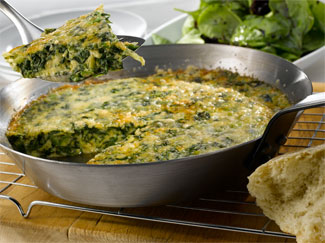 GREEN FRITTATA WITH SPINACH SALAD
GREEN FRITTATA WITH SPINACH SALADEggs mix well with a wide range of foods and, for a very quick, well-balanced and healthy meal, you can’t beat a combination of eggs with leafy green vegetables.
This frittata makes the best and quickest meal you can imagine - the greens included can be varied to suit what’s available, and it’s great for any time of the day.
Serves 4
Click for recipe
Strawberries
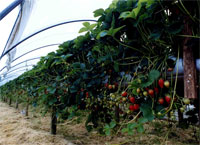
 Irish strawberries are now available through much of the year thanks to the fact that Keelings (www.keelings.com), in particular, have invested so heavily in glasshouses, extending the season from April to December instead of just a few weeks in summer. And surprisingly good they are too, full of flavour even in the off-season, and a very welcome alternative to imports.
Irish strawberries are now available through much of the year thanks to the fact that Keelings (www.keelings.com), in particular, have invested so heavily in glasshouses, extending the season from April to December instead of just a few weeks in summer. And surprisingly good they are too, full of flavour even in the off-season, and a very welcome alternative to imports.
But there’s nothing to beat the beautiful berries in their natural season, and it’s lovely to see them on sale at roadsides all around the East and South-East.
The sunny South-East – and Wexford in particular – is the place to be when it comes to strawberry growing, and all Ireland has been celebrating their little treasures recently at the annual Wexford Strawberry Fair Festival, which takes place each year at the Riverside Park Hotel, Enniscorthy.
This year’s festival celebrated the 50th year of the Strawberry Fair - “Gathering Strawberry Queens from over the last 50 years”!
Early in the strawberry season simplest is best, and it’s wonderful to luxuriate in the sunny flavour of the luscious big berries, perhaps served with a hint of caster sugar and cream or good vanilla ice cream. Or try a sprinkling of orange juice and a light grinding of black pepper.
As the season goes on and the berries get smaller, chop them up and mix roughly with broken meringue and cream or yogurt.
RECIPE:
 Serves 4
Serves 4
450g Irish strawberries
2 tablespoons redcurrant jelly
1 x 500g carton of fromage frais
Wash and hull the strawberries, reserving two to decorate the glasses.
Put the redcurrant jam in a pan with 2 teaspoons of water and heat gently, stirring until the jam has dissolved.
Bring to the boil, stir in the remainder of the strawberries, then remove from the heat and allow to cool.
Layer this mixture with the fromage frais in individual glasses, finishing with fromage frais.
Decorate with the reserved strawberries, sliced in half, and serve.
Shoreline Vegetables
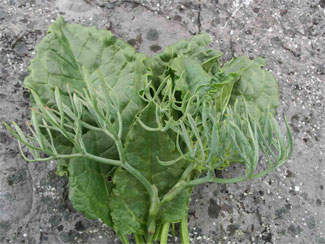
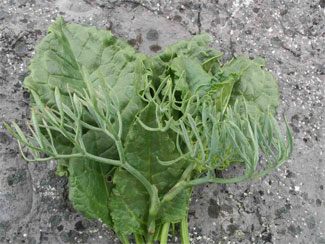 You don’t have to be walking in wild windswept places to find good things along the shoreline at this time of year – shoreline plants will grow anywhere they can get a hold in salty areas between the sea and the land proper, so there are plenty of foraging opportunities on summer walks along the edge.
You don’t have to be walking in wild windswept places to find good things along the shoreline at this time of year – shoreline plants will grow anywhere they can get a hold in salty areas between the sea and the land proper, so there are plenty of foraging opportunities on summer walks along the edge.The range gradually changes through the season but there is overlap between the times when the common varieties are available and no shortage of edible finds right through the summer.
Two of the most widely used for culinary purposes are Sea Spinach – also known as Sea Beet – which is easily identifiable because it has shiny green leaves with fleshy stems and looks quite similar to garden spinach, and Samphire, a plant with finely branched tubular stems.
There is no argument about sea spinach, which is a fleshier, more strongly flavoured and salt-tanged version of the familiar vegetable, which is to be found on the dry shore beyond the tide or on sea walls, and is not too challenging in the kitchen.
Pick the leaves young, while tender, trim and wash well then use them whole or with the chard-like stems removed. They make a balanced accompaniment to bland, soft foods, such as eggs, that benefit from the salty tang and robust texture, and can be cooked or used fresh in salads when young and tender.
Sea spinach first shows in spring; Samphire follows later in the summer – and, with two main types (rock samphire, and marsh samphire) having, apparently, many hard to identify cousins, it is the source of much confusion.
Connoisseurs claim that rock samphire (crithmum maritimum, a relative of fennel and a plant once cultivated in gardens) is superior to the more common marsh samphire (salicornia europaea, a member of the beet family also known as ‘glasswort’). For practical purposes when foraging, it makes little difference as pickling has been the traditional treatment for both, and they can also be cooked in the same way to eat fresh, or even used raw in salads.
That great cookery writer, the late Jane Grigson, suggested using samphire as a summer delicacy to be enjoyed like asparagus, ie boiled or steamed until just tender then served with melted butter or hollandaise sauce. Now there’s style.
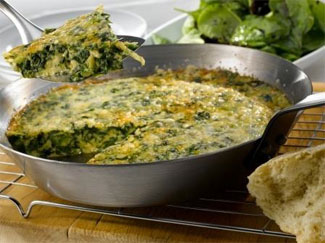 RECIPE: GREEN FRITTATA WITH SEA SPINACH SALAD
RECIPE: GREEN FRITTATA WITH SEA SPINACH SALADA quick and easy holiday meal that could be made with cultivated spinach or sea spinach, as available, or a mixture – remembering that the flavour and texture of sea spinach is more robust than the usual kind; taste it raw to familiarise yourself with the flavour. If uncertain about using sea spinach instead of a familiar vegetable, experiment with a single serving before making a family sized batch!
If you’re not sure about it, try using less and mix it off with more familiar vegetables – or use it only in the frittata, or in the salad rather than both. Wash sea spinach leaves carefully, and trim before use. Salt should not be needed as the sea spinach is naturally salty.
Click for recipe
Nectarines & Peaches
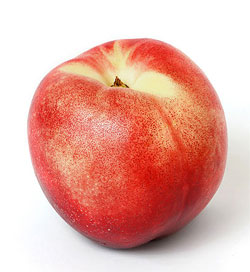
 What Are They? Nectarines are a smooth-skinned variety of peach, the fruit of a hardy deciduous tree.
What Are They? Nectarines are a smooth-skinned variety of peach, the fruit of a hardy deciduous tree. Where Do They Come From? Peaches are native to China, but they are widely grown in other areas, including Europe; even in Britain and Ireland they can be grown under glass or in polytunnels – or as fan-trained trees on warm south or south-west facing walls. Nectarines are slightly less hardy than peaches and need sheltered sites for successful cultivation out of doors.
Where Can I Get Them? European peaches and nectarines, mainly from Italy, are in season now and easily available in greengrocers and supermarkets. You may even be lucky enough to get Irish-grown fruit at farmers markets or small greengrocers where local growers may supply small quantities. Tasting the flavour of top fruit freshly picked off the trees is a memorable experience.
What Can I Do With Them? Peaches and nectarines are both delicious eaten fresh as a whole fruit when fully ripe, and can be used in fruit salads etc – but dip any cut fruit into water acidulated with lemon juice to keep it fresh looking, as it browns quickly when exposed to the air. Peaches and nectarines are excellent cooked (simply poach in a slow cooker for tender results without the fruit breaking up) and they make lovely ices, smoothies and sauces for sweet or savoury dishes.
RECIPE:
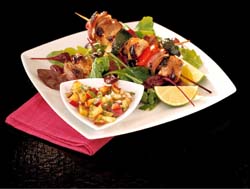 Pork Kebabs with Nectarine and Honey Salsa
Pork Kebabs with Nectarine and Honey SalsaAny fruity salsa is delicious with pork, and using summer fruit gives it a lighter seasonal feel. Nectarines have the edge for this dish as they have a thinner, smoother skin, but peaches could be used instead if more convenient.
Serves 4.
Click for recipe
Autumn Beef
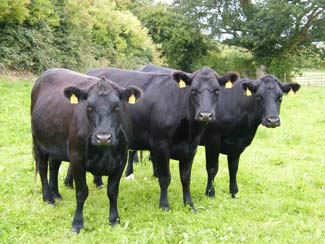
.jpg) At this time of year, chefs and beef connoisseurs begin to get excited about the new autumn beef which is just coming in from local farmers. Beef may be available all year – and many consumers are unaware of it as a seasonal food, in the way that lamb is – but those in the know keenly anticipate the meaty treats which will only be available for a couple of months during the autumn.
At this time of year, chefs and beef connoisseurs begin to get excited about the new autumn beef which is just coming in from local farmers. Beef may be available all year – and many consumers are unaware of it as a seasonal food, in the way that lamb is – but those in the know keenly anticipate the meaty treats which will only be available for a couple of months during the autumn. In north Dublin, for example, Howth butcher Ray Collier stocks the local Baily beef – finished each summer on a nearby farm – and it features on the menu at The King Sitric Fish Restaurant, where proprietor-chef Aidan MacManus takes great pride in offering a Baily Beef Tasting Menu for just a couple of weeks in the autumn, in addition to his usual wide range of seafood.
It comes from the Bellingham family farm at “The Cliffs” up at Baily, on the Howth peninsula, and supply is very limited “only about 12 or 16 cattle per year - the cattle graze free-range for the final summer of their lives, and thanks to the complex mix of grasses and plants, achieve wonderful condition and weight.”
In the same area, this year, beef from Lambay island is to be found for a limited period. Aqua Restaurant, on Howth’s West Pier, offers it on their menu for the month of September - and you can see the island from your restaurant table.
And there is a similar sense of excitement with speciality producers all around the country – down in Dungarvan, Paul Flynn, proprietor-chef of The Tannery, says “Once September comes I reintroduce my standing order from Michael McGrath in Lismore”, Paul loves this famous traditional butcher’s corned beef: “the stuff of legends”.
Co Kildare is real beef country and at Peter and Jenny Young’s organic farm near Athy, the Castlefarm Aberdeen Angus heifers have spent the summer fattening on a diet of organic grass and clover and are now ready to become autumn beef.
On a weekly basis during September and October, Jenny Young brings an animal to their local abattoir. “Our beef is hung for 21 days to maximize on flavour and tenderness. Each animal is then divided into freezer boxes and customers share the animal - each box contains a bit of everything; some steaks, some roasts, stewing beef and mince. Normally each beef box contains about 6 bags of mince, so I give out a beef burger recipe.
This is such a simple recipe but makes the point that if you use good quality meat, home-made burgers need very little else. The important thing is to use fresh, good quality mince. Homemade burgers are cheap, nutritious and so easy to make.”
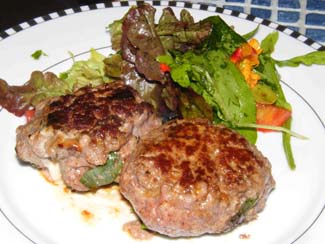 RECIPE:
RECIPE: Castlefarm Home-made Organic Angus Beef Burgers
Click for recipe
Irish Apples
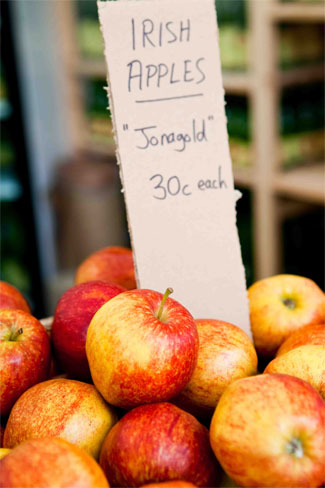
 Apples have been grown in Ireland for at least 3000 years. Indeed, St. Patrick is said to have planted a number of apple trees in Ireland, including one at Ceangoba, a settlement close to where Armagh is now situated.
Apples have been grown in Ireland for at least 3000 years. Indeed, St. Patrick is said to have planted a number of apple trees in Ireland, including one at Ceangoba, a settlement close to where Armagh is now situated. Early monastic records tell us that the monks were given apples with their meals, especially at festival times. The Brehon laws (originating between 2000 and 1000BC) stipulated that anyone cutting down an apple tree would be subject to a severe penalty; namely a fine of five cows, and even removing a limb or branch would warrant a fine of some sort.
Eating apples, cooking apples and cider apples are grown in Ireland and a lot of research has been undertaken to find varieties suited to Irish growing conditions. Nowadays the variety most widely planted in Ireland is the popular cooking apple, Bramley’s Seedling, (Bramley for short) which is mainly grown in Armagh, Dublin, Louth and Meath.
The South-East is known for its cider apples, notably counties Tipperary, Kilkenny, Waterford, while eating apples are mostly grown in the south-eastern counties (Waterford, Kilkenny, Tipperary, Carlow) and Co Dublin.
Different varieties are planted to mature in succession and will be found on sale at farmers’ markets, in farm shops and from some retail outlets from late summer to early spring.
Details of apple farms and farm shops are given within their growing areas in Ireland for Food Lovers, where you will also find information on speciality food stores and farmers markets; see also www.bordbia.ie for the current list of active farmer’ markets.
Although Irish apples are a delicious and versatile seasonal product with far more variety and character than many of their imported rivals, they are under-appreciated and not always easy to find as heavily branded imports dominate the main retail outlets.
A group of Irish apple growers who are trying to change this situation have banded together as Celtic Orchards; they are committed to grouping resources, abilities and enthusiasm, and selling the very best apples we can grow in Ireland.
This initiative is beginning to have an impact and, together with growing consumer interest in local foods and a wider product range – including speciality items like single vintage and sparkling juices, and a mulled apple juice (from Highbank Organic Orchards , in Co Kilkenny) - the future for Irish apples is beginning to look a lot brighter.
The three main ingredients in this recipe have been in common use in Irish kitchens for centuries and it still makes a delicious meal. Free range Irish pork production is increasing but it is slow to filter through to mainstream retail sales; a few specialist butchers stock it, but – like Irish apples - it’s more likely to be found through farm shops, farmers’ markets and online farm sales.
Serves 6-8
Click for recipe
Dried Fruits

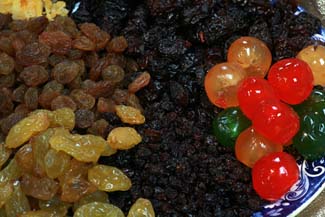 Dried fruits are available all year round but, for truly memorable Christmas cakes and puddings, the experts agree that using top quality new-season ingredients makes all the difference.
Dried fruits are available all year round but, for truly memorable Christmas cakes and puddings, the experts agree that using top quality new-season ingredients makes all the difference. Good mid-range ingredients are easily available from grocers and supermarkets of course, but there are certain shops that specialise in offering premium quality dried fruit carefully sourced from the best growing regions, and there is no mistaking the difference.
Three of Ireland’s most discerning suppliers, renowned for their outstanding baking ingredients, are: Peter & Mary Ward at Country Choice, Nenagh, Co Tipperary; Jim Tynan at The Kitchen & Foodhall Portlaoise, Co Laois; and the Cronin family at The Gourmet Shop, Rathgar, Dublin 6.
All carry a great range of speciality seasonal products and would be an excellent choice for gift hampers too.
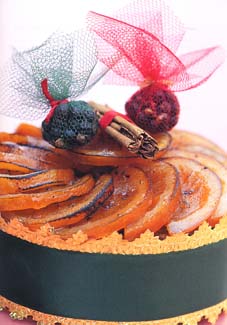 Fresh Orange Fruit Cake - an interesting, fresher-flavoured alternative to the usual rich fruit cake, this cake owes its individuality to the quality of its ingredients, including unrefined sugar, and it can be decorated prettily with glacé orange slices (available from Country Choice), or whole glacé fruit.
Fresh Orange Fruit Cake - an interesting, fresher-flavoured alternative to the usual rich fruit cake, this cake owes its individuality to the quality of its ingredients, including unrefined sugar, and it can be decorated prettily with glacé orange slices (available from Country Choice), or whole glacé fruit. Makes an 8in/20cm cake, serving 10-12.
Click for recipe
Abalone
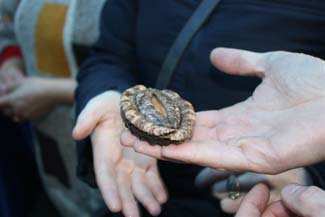
 Abalone are a highly prized shellfish delicacy, now scarce in most countries where they were once plentiful. Known as much for their beautiful iridescent shells as for the delicately flavoured meat, this exotic shellfish is not something one might expect to find in the rugged surroundings of the West of Ireland and, except for flurry of interest at this time of year when they are in demand for the Chinese New Year celebrations in Ireland, most of the production is exported.
Abalone are a highly prized shellfish delicacy, now scarce in most countries where they were once plentiful. Known as much for their beautiful iridescent shells as for the delicately flavoured meat, this exotic shellfish is not something one might expect to find in the rugged surroundings of the West of Ireland and, except for flurry of interest at this time of year when they are in demand for the Chinese New Year celebrations in Ireland, most of the production is exported. (Now in its fourth year, the Dublin Chinese New Year Festival celebrates Sino-Irish relations by showcasing Chinese culture and heritage – in which food plays an important part. The 2011 activities take part at various locations during the first fortnight of February; see www.visitdublin.com/events). Connemara Abalone is sometimes showcased in local restaurants such as the Matz at the g, at the stylish g hotel in Galway city.
About 80 different abalone species are native to the warm temperate waters off Japan, China, California, Mexico, South Africa, Australia, New Zealand, and France, but wild abalone fisheries in most of those countries are now either closed or severely restricted. Demand for abalone remains strong, however, so in order to supply the market, they must be farmed.
Connemara Abalone was started in 2002 by Cindy O'Brien. As a California native with a degree in Marine Biology from Cal. State University, Long Beach, Cindy has long been familiar with abalone and their aquaculture.
 Having moved to Ireland in 1996 with her Irish husband and young children, Cindy saw the pristine waters (and abundant seaweed) off Connemara as an ideal environment in which to raise abalone. Moreover, two species of abalone had already been introduced to Ireland by BIM and NUIG's Cama Research Lab., so both technical and financial support was readily available from Irish government agencies (Údarás na Gaeltachta, BIM, Bord Bia), and greatly appreciated.
Having moved to Ireland in 1996 with her Irish husband and young children, Cindy saw the pristine waters (and abundant seaweed) off Connemara as an ideal environment in which to raise abalone. Moreover, two species of abalone had already been introduced to Ireland by BIM and NUIG's Cama Research Lab., so both technical and financial support was readily available from Irish government agencies (Údarás na Gaeltachta, BIM, Bord Bia), and greatly appreciated.Technically, abalone are single-shelled gastropods (a group that includes clams, scallops) that feed on seaweeds. Apart from their shell, they are almost pure protein. In fact they are the most efficient way known to nature of converting red or brown algae into white protein. They are also rich in Omega-3 and other minerals (typical Omega-3 content is 500mg per 100g of raw abalone).
It takes approximately 4 years for abalone larvae to reach market size of 7-8cm length. Connemara Abalone has its own hatchery at the farm, so it can spawn and raise abalone from larvae right up to adult size; for the final three years or more their diet is abundant locally and free – fresh seaweed. At the end of this process they are shipped from their tanks to market, where they must live up to their reputation as the "truffles of the sea".
The texture of a raw abalone is quite firm, but once cooked (for just 30-40 seconds in most recipes) it can be cut like butter and has a sweet, nutty flavour.
Abalone can be served with creamy or spicy sauces, or just drizzled with lemon or lime. They are quite filling so suggested serving size is 2-3 abalone for an appetizer, and 5 to 6 for a main course. There are over 100 different recipes and methods for cooking abalone; see www.abalone.ie for more easy-to-follow recipes.
Connemara Abalone, Aille, Barna, Co Galway. Visitors welcome by arrangement. For further information: call +353 (0)91 591307, email info@abalone.ie, or see www.abalone.ie for ordering and shipping details (normally by overnight courier to your door).
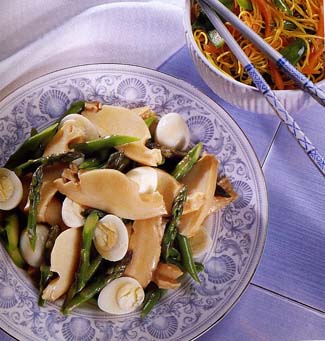 RECIPE : ABALONE WITH OYSTER SAUCE
RECIPE : ABALONE WITH OYSTER SAUCEYou can steam, sauté, bake, poach, boil, or barbecue abalone, or eat them raw like oysters. To prepare for cooking, use a spoon to "shuck" the meat from the shell; relax the meat with the back of a wooden spoon or mallet, and cook by your chosen method.
This simple stir-fried dish is adapted from a recipe in The Chinese Kitchen by Deh-Ta Hsiung; this well known expert on Chinese cooking is based in England and visited Ireland on behalf of Egon Ronay Guides and, more recently, to assess Chinese restaurants for GC Guides. The Oyster sauce lends an extra dimension to the flavours.
Click for recipe
Cabbage
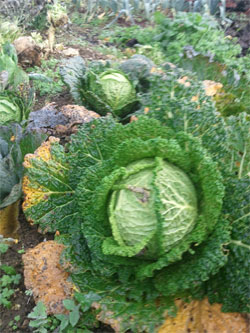
 Irish vegetables have been seriously undervalued during the boom years, and none more so than the staple crops that have stood by us so well down through the centuries – everyday foods like carrots, leeks and cabbage.
Irish vegetables have been seriously undervalued during the boom years, and none more so than the staple crops that have stood by us so well down through the centuries – everyday foods like carrots, leeks and cabbage. They suit the climate and our traditional dishes, and are available locally and inexpensively over a long season; yet we so often favour ‘exotic’ imports over these simple but nourishing and versatile foods.
Take the humble cabbage (Brassica oleracea), for example. This leafy green/purple member of the mustard family is grown in so many varieties that there is a choice of ‘styles’ available throughout the year – ranging from tightly packed heads (green/yellow, red, crinkly) to loose-leafed kinds including ‘spring greens’ and numerous cousins such as brussels sprouts and sprouting broccoli.
The brassica family is known to have many important health benefits (mineral rich, green leafy vegetables are linked to everything from boosting the immune system – including preventing cancer - to improving memory) yet too many of us seem reluctant to ‘eat our greens’.
Until recent decades Spring cabbage was a widely welcomed crop, being the first leafy green vegetable available after a long winter dominated by root vegetables and the hard ‘keeping’ cabbages. And the fresh new season leaves are still a treat, even if the range of other vegetables, whether imported or grown under protection, has undermined its special position in the cook’s calendar.
Cooked lightly to retain the fresh colour and flavour, spring cabbage is a very versatile side vegetable and goes well with any roast or grilled meat, most hearty casserole dishes, some smoked fish, and vegetarian dishes such as omelettes or cheese & vegetable bakes too.
RECIPE:
Smoked Fish with Mustard and Cabbage
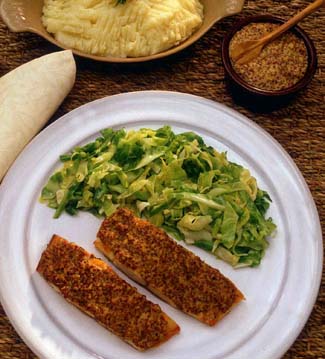 A simple, nourishing midweek meal.
A simple, nourishing midweek meal.Serves 4
Click for recipe
Watercress
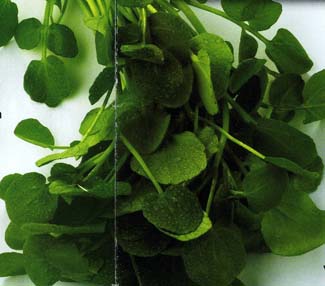
 Watercress (Nasturtium officinale) is a fast-growing semi-aquatic perennial plant and one of the oldest known leaf vegetables consumed by human beings. Watercress belongs to the cabbage (brassica) family, and is related to garden (land) cress and mustard — which, like the nasturtium flowers that grow so freely in our gardens all summer, are know for their peppery flavour.
Watercress (Nasturtium officinale) is a fast-growing semi-aquatic perennial plant and one of the oldest known leaf vegetables consumed by human beings. Watercress belongs to the cabbage (brassica) family, and is related to garden (land) cress and mustard — which, like the nasturtium flowers that grow so freely in our gardens all summer, are know for their peppery flavour.Watercress is growing strongly in streams all over Ireland at this time of year and, providing it is clear running water with no effluent running into it from grazing animals (which introduces serious risks, including liver fluke parasite), it is safe to pick. Best picked in spring and autumn, the darker leaves have best flavour. Wash well, trim, and shake dry before use.
Although hailed as one of the most potent of today’s ‘superfoods’, there is nothing new about watercress.
As Darina Allen points out in her invaluable book, Forgotten Skills of Cooking (Kyle Cathie), watercress “…formed part of the diet of hermits and holy men, who valued its special properties, which we now know include significant amounts of iron, calcium, folic acid, vitamins A and C.
 Watercress is brilliant for detox – the mustard oils boost and regulate the liver’s enzymes. Its beta carotene and vitamin A are good for healthy skin and eyes, and watercress is naturally low in calories and fat. Gram for gram, watercress has more iron than spinach, more vitamin C than oranges and more calcium than full cream milk…”
Watercress is brilliant for detox – the mustard oils boost and regulate the liver’s enzymes. Its beta carotene and vitamin A are good for healthy skin and eyes, and watercress is naturally low in calories and fat. Gram for gram, watercress has more iron than spinach, more vitamin C than oranges and more calcium than full cream milk…”Legend has it that it was watercress that enabled St Brendan to live the ripe old age of 180! And Hippocrates, the father of medicine, chose the location of his first hospital so he could use only the freshest watercress to treat his patients.
And it looks as if Hippocrates was on to something big: evidence is growing to support claims that this peppery little salad leaf is an important player in the field of cancer prevention. Research carried out by Professor Rowland from the University of Ulster, Coleraine, and published in the American Journal of Clinical Nutrition (February 2007), suggests that eating watercress daily can significantly reduce DNA damage to blood cells, which is considered to be an important trigger in the development of cancer – and that a daily portion of watercress also increased the ability of those cells to resist further DNA damage caused by free radicals.
An earlier study in America, by a Professor Stephen Hecht, even showed that eating watercress neutralised a cancer-causing chemical found in the blood of smokers. For more information on health benefits and everything to do with this remarkable plant, visit the dedicated website, www.watercress.co.uk
If all the health benefits aren’t enough, perhaps fashion appeal will do the trick – chefs are going mad for it these days, and ‘the new rocket’ is adding a fresh piquancy to all sorts of dishes.
Shepherds Pie with Watercress Champ
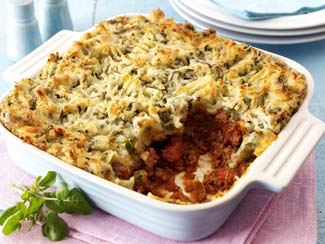 Comfort food at its best, this recipe is from chef Antony Worrall Thompson, who is “… a huge fan of watercress; its distinctive mustardy flavour suits a variety of different dishes, from meat, fish and stir fries to soups and salads.” This pie should be made with lamb, he says, hence the reference to shepherds, but traditionally it was normally made with the leftovers of the Sunday joint whatever that happened to be. “I often serve a variation on the classic using cauliflower cheese instead of mashed potato which is lower in carbohydrate. However, there’s really no comparison for the real thing - just serve a big dollop and enjoy!”
Comfort food at its best, this recipe is from chef Antony Worrall Thompson, who is “… a huge fan of watercress; its distinctive mustardy flavour suits a variety of different dishes, from meat, fish and stir fries to soups and salads.” This pie should be made with lamb, he says, hence the reference to shepherds, but traditionally it was normally made with the leftovers of the Sunday joint whatever that happened to be. “I often serve a variation on the classic using cauliflower cheese instead of mashed potato which is lower in carbohydrate. However, there’s really no comparison for the real thing - just serve a big dollop and enjoy!”Click for recipe
Asparagus

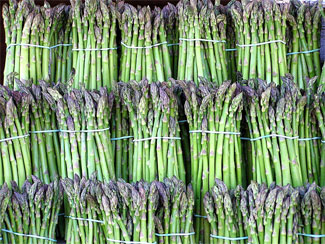 Imported asparagus may be available all year round but there is nothing to beat the treat of having locally grown asparagus in its short spring season, which traditionally begins on 23rd April and ends on Midsummer Day.
Imported asparagus may be available all year round but there is nothing to beat the treat of having locally grown asparagus in its short spring season, which traditionally begins on 23rd April and ends on Midsummer Day. This feathery-foliaged herbaceous perennial grows to about 1 metre/3ft tall and takes several years to develop enough of the precious stems to allow harvesting; stems are picked when young and tender, before the buds begin to open as they soon become woody after that.
Asparagus is native to maritime areas and likes sandy soils which are quite salty (which acts as a natural weed suppressant). It requires space and the beds need to be left undisturbed for a number of years, so it is better suited to dedicated kitchen gardens than mixed domestic gardens, but the recent popularity of allotments (and interest in local foods and their production) has seen renewed interest and it is now being grown more widely again, with tomatoes as a companion plant. Although not often seen in shops yet, it is worth looking out for Irish grown asparagus at farmers’ markets.
Although its delicate flavour and seasonality makes it highly desirable in the kitchen, asparagus is much more than just a pretty vegetable. It has long been recognised for its medicinal qualities and is a good source of dietary fibre, protein and many vitamins, minerals, trace elements; low in calories and sodium, it has diuretic properties and is high in antioxidants.
So perhaps it is not surprising that the second century physician Galen is credited as describing asparagus as "cleansing and healing".
Green asparagus is widely grown and eaten, and white (blanched) asparagus is also very popular in northern Europe, where ‘asparagus menus’ are a speciality in restaurants in asparagus-growing areas.
Premium quality asparagus is best eaten steamed or semi-boiled (ie standing in a tall pan, with the lower stems in water and the tender upper section in steam), and served very simply as a starter with hollandaise, vinaigrette, melted butter or olive oil, Parmesan cheese or mayonnaise.
When plentiful and inexpensive, it makes a useful side vegetable and is a versatile ingredient for a wide range of dishes, from salads (used raw or cooked) and stir-fries to omelettes, risottos and barbecues.
RECIPE: Grilled Supreme of Chicken with Sweet Potato and Asparagus
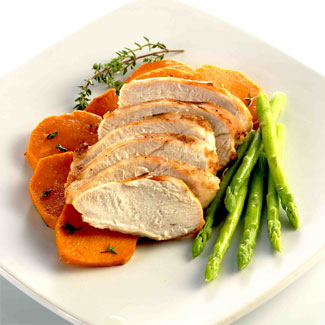 This dish was devised for a recent Happy Heart Eat Out campaign by Michael O’Meara, Oscars Bistro, Upper Dominick Street, Galway.
This dish was devised for a recent Happy Heart Eat Out campaign by Michael O’Meara, Oscars Bistro, Upper Dominick Street, Galway.Serves 4
Click for recipe
Gooseberries

 Of all our Irish fruit the gooseberry has the earliest natural season and is ideally suited to our climate - yet it seems to be inexplicably underused. Admittedly the bushes tend to be thorny and the most commonly grown green varieties need a lot of sweetening to make them palatable, but it’s a very versatile fruit and this harbinger of summer is delicious in many traditional puddings, cold sweets and preserves – in fact, it is interchangeable with rhubarb, in any of the treats that we enjoy when made with that equally easily grown and prepared, but much more popular, early ‘fruit’.
Of all our Irish fruit the gooseberry has the earliest natural season and is ideally suited to our climate - yet it seems to be inexplicably underused. Admittedly the bushes tend to be thorny and the most commonly grown green varieties need a lot of sweetening to make them palatable, but it’s a very versatile fruit and this harbinger of summer is delicious in many traditional puddings, cold sweets and preserves – in fact, it is interchangeable with rhubarb, in any of the treats that we enjoy when made with that equally easily grown and prepared, but much more popular, early ‘fruit’. The gooseberry (Ribes uva-crispa, syn. R. grossularia) is a species of Ribes, native to Europe, northwestern Africa and southwestern Asia. The spiny bushes are grown, on both a commercial and domestic basis, for their fruit which is most often green and hard – but there are delicious dessert varieties available too, which glory in colourful names such as ‘old rough red’ and ‘hairy amber’.
If you have gooseberries in the garden, they tend to be very prolific and it is worth making the effort to use them in a variety of ways so they won't be taken for granted.
They freeze very well - just top and tail them and store in freezer bags to use in pies and tarts or for sauces during the winter. Being a naturally 'free-flow' product, they are extremely convenient to use from the freezer.
They are delicious simply stewed and served with cream or ice cream (and, perhaps, some almond biscuits or fingers of shortbread) or used in pies, crumbles and layer cakes. And, as gooseberries need a lot of sweetening whatever you do with them, they're absolutely ideal for preserving.
They have much greater versatility than they are normally given credit for, especially as they have the added virtue of combining well with other fruits and flavourings to produce interesting and unusual combinations – gooseberry and elderflower is a classic.
RECIPE: Gooseberry and Elderflower Fool
The first gooseberries are ready for picking at just about the time when the elder is flowering in hedges throughout the country and this makes a natural partnership, the elder flowers giving an exotic flavour reminiscent of muscat grapes to the familiar green berries. (But elderflowers are not all the same - the right one for the kitchen smells pleasantly perfumed and, needless to say, should be picked well away from busy roads.) Don't leave the flowers in with the gooseberries for more than a few minutes, or they will overpower the fruit. And it's worth remembering that a lot of the flavour in gooseberries is in the skin, so they should be crushed (or liquidised) rather than sieved if you don’t want to use them whole.
Click for recipe
Carrots

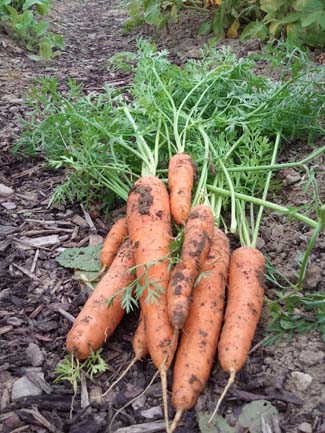 A domesticated form of the wild carrot Daucus carota, an umbelliferous plant which is native to Europe and southwestern Asia, this everyday root vegetable is usually orange - although purple, red, white, and yellow varieties exist and are currently more widely grown, due to demand from chefs.
A domesticated form of the wild carrot Daucus carota, an umbelliferous plant which is native to Europe and southwestern Asia, this everyday root vegetable is usually orange - although purple, red, white, and yellow varieties exist and are currently more widely grown, due to demand from chefs. Carrots are rich in dietary fibre, antioxidants, and minerals and their typical orange colour comes from beta-carotene, which is metabolised into vitamin A in humans and is important for good vision, including night vision.
Carrots are good for the skin and can apparently boost your UV protection if consumed on a regular basis; it is claimed that beta-carotene can help to protect your skin from excessive ultra-violet (UV) radiation and sunburn.
On the other hand, eating a vast amount of carrots can make the skin turn orange although the condition, while strange, is not thought to be dangerous.
 From the gardener’s point of view carrots can be difficult to grow because they attract the dread carrot fly, but they could be useful companion plants as intercropping them with tomatoes is thought to increase tomato production – and, in common with other umbelliferous plants, the flowers attract predatory wasps which kill many garden pests.
From the gardener’s point of view carrots can be difficult to grow because they attract the dread carrot fly, but they could be useful companion plants as intercropping them with tomatoes is thought to increase tomato production – and, in common with other umbelliferous plants, the flowers attract predatory wasps which kill many garden pests.Although carrot leaves are also edible, all we usually eat is the taproot, which is enjoyably sweet and crunchy to eat raw; even when cooked, carrots are usually tastier when served with some ‘bite’ left, although this is not a universal rule as a soft melting texture can also be an asset to some slow-cooked dishes, allowing the natural sweetness to be fully released.
This natural sweetness also adds to their versatility as they can be used in baking (eg in the ever-popular carrot cake) and sweet dishes (eg the Indian carrot dessert Gaajar Kaa Halwaa).
Although thought of mainly as a winter vegetable – with sales peaking at Christmas - the new carrot season begins in July and, whether raw or cooked, young carrots are ideal for salads and barbecues.
It’s hard to imagine a French neighbourhood restaurant without carottes rapées on the menu but we tend to overlook their versatility as a summer vegetable.
Perfect for munching as a snack, or among a selection of crudités for dipping, it’s worth thinking about complementary flavours: carrots can be lifted into a new league if paired with, for example, citrus fruits – in a salad dressing or a roasting glaze - which bring out the sweetness, as does a glaze of honey and balsamic vinegar. Or try a partnership with herbs, notably French tarragon, which adds an unexpected layer of sophistication, or mint which contributes freshness.
More unusually, carrots can be used in combination with sea vegetables – a popular Irish example is Prannie Rhatigan’s Carrot & Sea Spaghetti Salad, from her book Irish Seaweed Kitchen.
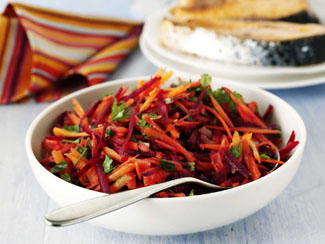
RECIPE: Carrot and Beetroot Salad
Colourful and crunchy, this easy salad is rich in carotenoids, which are great for summer skin, with an anti-oxidant effect. Serve it at as a starter or side dish with fish or grilled meats, and at barbecues.
Click for recipe
Blueberries
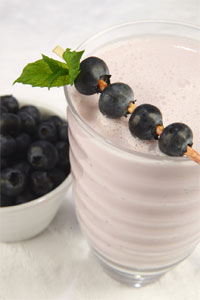
 Now widely recognised as a ‘superfood’, blueberries are bigger cousins of the native Irish bilberry or fraughan and thrive in similar peaty habitats.
Now widely recognised as a ‘superfood’, blueberries are bigger cousins of the native Irish bilberry or fraughan and thrive in similar peaty habitats. Grown on cutaway bogland in County Offaly, Irish blueberries are in season in August and September, when they are available in shops.
Along with many other Irish fruit and vegetables, including strawberries and rasberries, they’re distributed by Keelings , who guarantee that customers will get berries that are picked when they are ripe – and, of course, seeking them out will support the local economy too.
You can also buy fresh Irish blueberries at Farmleigh Food Market and from the farm shop at Derryvilla, Portarlington, where other blueberry products are available too.
Virtually fat and cholesterol free, low in calories, high in vitamins A and C, while high in dietary fibre and in calcium, they require very little sweetening - and have more antioxidants than most other fruits and vegetables.
All this, and much more, can be said of their health-giving properties but, aside from all that, they’re absolutely delicious – and can be eaten raw or cooked in many dishes including desserts, bakes and drinks such as the quick and easy smoothie below.
Blueberries freeze well and are very versatile to use from frozen. Although most of the blueberries in shops are imported (check the label), remember to buy local when they’re in season in Ireland!
RECIPE: Blueberry Smoothie
175ml / 6fl oz natural Irish apple juice, eg Llewellyn, Karmine or Crinnaughton
120ml / 4fl oz natural Irish yoghurt, eg Glenisk, Killowen or Glenilen
1 banana, peeled and roughly chopped
170g / 6oz Irish blueberries
Place all the ingredients into a blender and blend until smooth.
To serve, pour into glasses.
Mussels
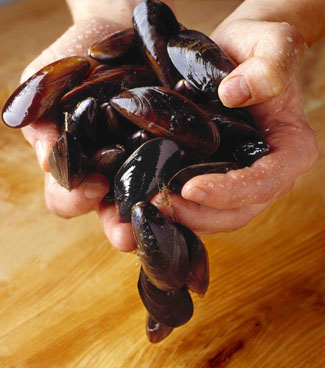
 The most abundant, widespread and versatile of Irish shellfish, the common or blue mussel (Mytilus edulis – or an diúilicín in Irish), is to be seen on virtually every rock, pier and rope in the sea around Ireland.
The most abundant, widespread and versatile of Irish shellfish, the common or blue mussel (Mytilus edulis – or an diúilicín in Irish), is to be seen on virtually every rock, pier and rope in the sea around Ireland. A double-shelled mollusc with an inky blue-black curved shell, it is a native shellfish and has been eaten in Ireland since ancient times – and, thanks to Molly Malone, is associated with Ireland throughout the world.
Mussels are lazy creatures by nature, attaching themselves in clusters to whatever comes their way with byuss (numerous threads produced by the mussel itself), then they just stay there and filter in the food-rich seawater. Although many methods are used in modern mussel cultivation, the basic principle of growing mussels is simple - give them something to attach themselves to in food-rich water.
They grow wild, in or near estuaries and bays, and use a filter system to feed on plankton, taking in up to 45 litres of seawater a day to nourish themselves. Depending on the type of plankton they feed on, their flesh is white or yellow in tone.
Mussels feature in many seafood festivals around the Irish coast, with the most prominent of these (and the most fun) currently The Connemara Mussel Festival, held since 2006 in Renvyle, Co Galway each May bank holiday and ‘headquartered at Paddy Coyne’s pub’ at Tullycross.
 Food writer Máirín úí Chomáin, author of a number of books including Irish Oyster Cuisine, has been a judge at the Connemara Oyster Festival since its inception, and has now written a book inspired by the festival, Irish Mussel Cuisine (€15 from Connemara at Clifden bookshop, Kylemore Abbey, The Twelve Bakery shop in Barna, Avoca shop Letterfrack and Lough Inagh Lodge Hotel; also online from www.connemaramusselfestival.com).
Food writer Máirín úí Chomáin, author of a number of books including Irish Oyster Cuisine, has been a judge at the Connemara Oyster Festival since its inception, and has now written a book inspired by the festival, Irish Mussel Cuisine (€15 from Connemara at Clifden bookshop, Kylemore Abbey, The Twelve Bakery shop in Barna, Avoca shop Letterfrack and Lough Inagh Lodge Hotel; also online from www.connemaramusselfestival.com). The book is a combination of memoir, practical information (she did spend many years teaching cookery after all) and compilation of Márín’s own favourite mussel recipes and those of local chefs and national contributors, including some of the country’s best known chefs.
It celebrates the fun and community involvement of the festival, the versatility of this beautiful mollusc, and Máirín úí Chomáin’s warm personality and love of the stunning area that she was born and raised in.
This delightful, informative and useful book will certainly encourage cooks to make better use of this plentiful food, and many of us will eat all the better for it.
 RECIPE: Spicy mussel cakes
RECIPE: Spicy mussel cakesCrab cakes are a favourite dish all over Ireland, so why not something equally delicious with other local seafood, such as mussels? Here John O'Toole, Head Chef at the McEvilly family’s lovely Cashel House Hotel at Cashel, Co. Galway shares a simple but unusual dish that he has created using local mussels.
SERVES 8
Click for recipe
Bramley Apples
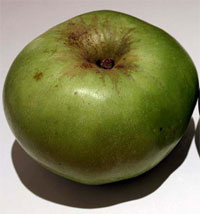
 The Bramley’s Seedling is one of Ireland’s latest fruit crops, harvested at the end of October, and its special qualities have made it the most popular cooking apple in Britain and Ireland. From the grower’s viewpoint, it is disease and pest tolerant, producing a good crop of large apples in most years.
The Bramley’s Seedling is one of Ireland’s latest fruit crops, harvested at the end of October, and its special qualities have made it the most popular cooking apple in Britain and Ireland. From the grower’s viewpoint, it is disease and pest tolerant, producing a good crop of large apples in most years. The apples are hard, have good flavour and keep well so they can be sold over a long period. Cooks find the large size convenient for preparation and their natural sharpness is a great quality, balancing the sweetness of pastry and any added sugar, and the fruit acids help break down the apple during cooking so that it ‘falls’ to produce a unique fluffy purée.
A relatively modern apple dating from the 19th century, it is widely grown but is most strongly associated with Armagh, ‘The Orchard County’, which has a history of apple growing that goes back ‘forever’; St Patrick, the early monasteries, William of Orange are among the many with historical references linking apples – and cider – to the area, and there are many folk customs associated with apples, especially at Hallowe’en.
 Nowadays most of the commercial crop is prepared for apple sauce and bakery, and the rest is retailed whole or juiced. Interestingly, however, although they are grown specifically for cooking and they are quite sharp, the Bramley’s flavour is delicious and anyone without a very sweet tooth is likely to enjoy them raw too, especially after some time in storage when the natural sugars have developed and mellowed the flavour.
Nowadays most of the commercial crop is prepared for apple sauce and bakery, and the rest is retailed whole or juiced. Interestingly, however, although they are grown specifically for cooking and they are quite sharp, the Bramley’s flavour is delicious and anyone without a very sweet tooth is likely to enjoy them raw too, especially after some time in storage when the natural sugars have developed and mellowed the flavour. Armagh Bramley Apples are among a very small number of Irish products to have applied to the European Commission for PGI (Protected Geographical Indication) status.
The Loughgall Manor Estate and Country Park (Main Street, Loughgall, Armagh BT61 8HZ; +44(0)28 3889 2900; between Portadown and Armagh via the B77), is in the heart of the apple growing area. It has a walled garden containing a fascinating Heritage Orchard with a collection of 130 native Irish apple varieties established by The Armagh Orchard Trust (+44 (0)28 3889 2312); and the research centre, Agrifood & Biosciences Institute (AFBI) is also on the property (+44 (0)28 3889 2344; www.afbini.gov.uk).
Aside from their historical importance, old varieties are of interest because they flourished before chemical treatment for pests and diseases was the norm, so they tend to have natural resistance to diseases such as scab – and their flowering habits make them less vulnerable to late frosts, providing quality fruit over longer harvesting periods.
The original tree was planted over 200 years ago, and trees dating from around that time still stand in commercial orchards in Ireland today - so, next time you enjoy a juicy Bramley apple pie or a big baked Bramley apple, it may be interesting to reflect that the apple could have come from a tree over a century old.
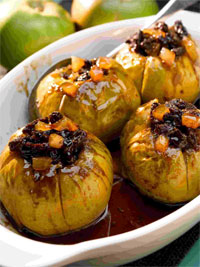 RECIPE: Ginger Baked Bramleys
RECIPE: Ginger Baked BramleysA variation on one of the simplest and best apple puddings, this Bord Bia version of the classic baked apple can be on the table in half an hour (or less) and has a gentle ginger flavour. You can stuff them with any combination of dried fruits that takes your fancy, and it’s a good way to use up any mincemeat left over after Christmas. Ideally, cook them at the same time as your main course or some other dish, to get best use of the oven heat.
Click for recipe
Smoked Salmon
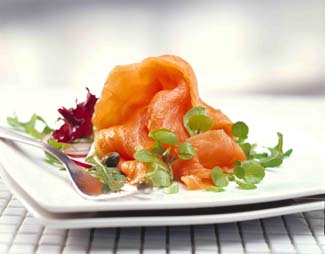
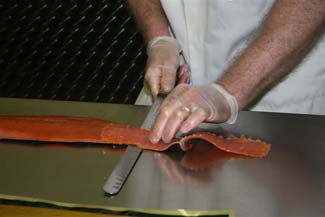 Smoking is a popular preserving process for oily fish, with salmon being a particular delicacy made from sides of salmon (fillets) that are dry-cured or brined and then hot or cold smoked, typically over oak chips.
Smoking is a popular preserving process for oily fish, with salmon being a particular delicacy made from sides of salmon (fillets) that are dry-cured or brined and then hot or cold smoked, typically over oak chips. Cold smoking is more usual and does not cook the fish, so it has a fine texture. The smoker’s art determines the texture and flavour, which can be strong or mild, depending on the individual style favoured by the smoker, who may also introduce various other flavours in the curing and smoking process – hence the fact that many ‘house’ recipes are a closely guarded secret.
Smoked salmon is an all-year product but is now almost as traditional a part of Christmas as the turkey and the ham, and we are fortunate to have a large number of excellent salmon smokers in Ireland.
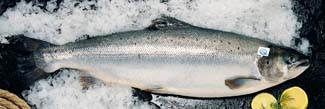 Both wild and farmed salmon are used for smoking, with prices varying according the quality and availability. Supplies of wild salmon have been limited in recent years, and smoked wild salmon is scarce; however, thanks to unique conditions, which include siting pens in fast-moving seawater in exposed sites, low fish density and good diet, Irish farmed salmon generally has a good reputation internationally.
Both wild and farmed salmon are used for smoking, with prices varying according the quality and availability. Supplies of wild salmon have been limited in recent years, and smoked wild salmon is scarce; however, thanks to unique conditions, which include siting pens in fast-moving seawater in exposed sites, low fish density and good diet, Irish farmed salmon generally has a good reputation internationally. Very high quality organic farmed Irish salmon is available, mainly farmed off the west and north coasts in clean, strongly tidal waters. One of the largest and most respected producers is Clare Island Organic Salmon, which is sited in Clew Bay, six kilometers off the Mayo coast, and supplies many of the top smokeries throughout Ireland, including the Burren Smokehouse, Co Clare; Ummera Smokehouse in West Cork and Connemara Smokehouse in Co Galway, all of which can be visited in person and also offer online sales.
 RECIPE: Smoked Salmon Platter – a very simple recipe, courtesy of BIM.
RECIPE: Smoked Salmon Platter – a very simple recipe, courtesy of BIM. Like other simple dishes, its success depends on the quality of the ingredients, so buy the best quality smoked salmon you can afford.
Serves 2
Ingredients:
• 6- 8 slices smoked Irish salmon
• 2 handfuls of salad garnish
• 2 wedges of lemon
• A few capers
Method
Simply arrange the slices of smoked salmon in an attractive manner on the platter, and garnish with a few salad leaves, lemon wedges and capers.
Traditionally served with slices of brown Irish soda bread.
Seville Oranges
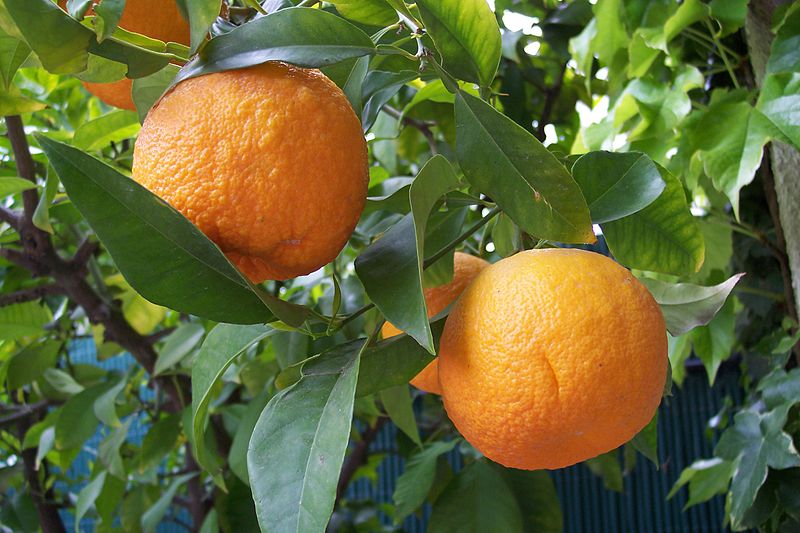
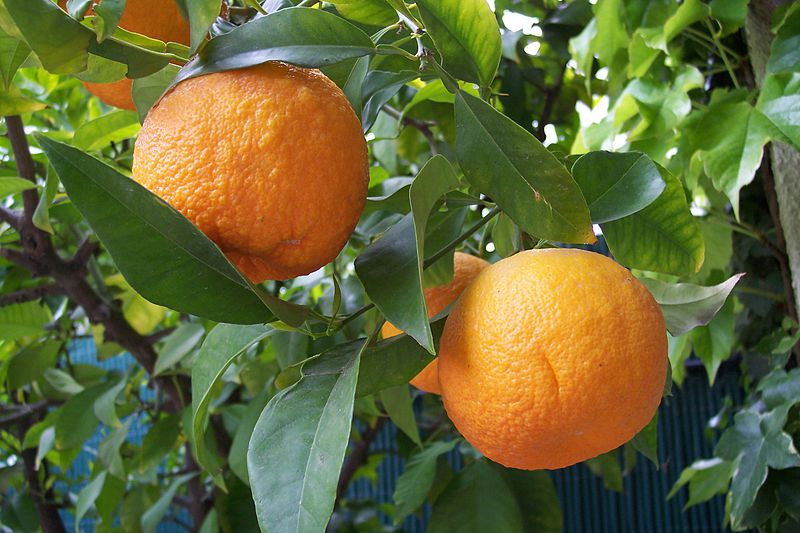 As the New Year brings thoughts of restraint and good resolutions to eat more healthily, it is a happy coincidence that – although now available all year round – vitamin-packed citrus fruits are in their peak season in January and February, allowing us the opportunity to indulge with a clear conscience.
As the New Year brings thoughts of restraint and good resolutions to eat more healthily, it is a happy coincidence that – although now available all year round – vitamin-packed citrus fruits are in their peak season in January and February, allowing us the opportunity to indulge with a clear conscience.
A high proportion of the world’s citrus production is processed, mostly into frozen concentrated juice, but there is nothing to beat the flavour and texture of fresh fruit in the peak of its season – memorable if you have ever had the pleasure of enjoying fruit straight from the tree, even an ornamental tree grown in a tub at home in Ireland.
Unlike their juicy sweet-fleshed relations, which are so delicious used fresh and for juicing, bitter oranges are used mainly in cooking, and for their essential oil, which is used for its scent and flavour. Variously known as the Seville orange (named after a major growing area), sour orange, bigarade orange, and marmalade orange, it is the fruit of a citrus tree, Citrus × aurantium.
Bitter oranges – for marmalade and, perhaps, sauces and accompaniments including variations on the traditional orange sauce ‘bigarade,’ for serving with duck – are in season for just a few short weeks, and it is well worth getting some even if you are busy, as they freeze down well for use later in the year. (A 3 lb/1.5 kg batch is perfect for marmalade; see Eunice Power’s column for her favourite marmalade recipe).
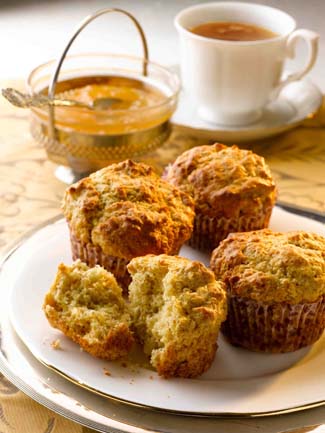 RECIPE: MARMALADE MUFFINS
RECIPE: MARMALADE MUFFINS
The trick to fluffy muffins is to fold the wet and dry ingredients together as briefly as possible until just combined; don’t worry if the mixture still looks a little lumpy. These muffins are best served on the day they are made. If you don’t fancy using marmalade try making them with lemon curd instead.
Click for recipe
Purple Sprouting Broccoli
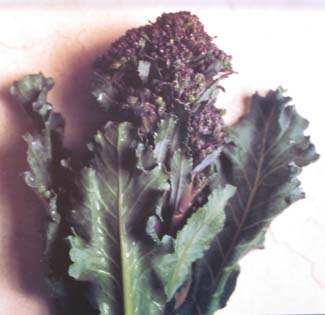
.jpg) Sprouting broccoli is one of my favourite vegetables and it’s a great crop to grow yourself because, strangely, it’s very rarely to be seen in the shops in Ireland.
Sprouting broccoli is one of my favourite vegetables and it’s a great crop to grow yourself because, strangely, it’s very rarely to be seen in the shops in Ireland. A brassica (member of the cabbage family), it is grown for its clusters of flower heads, which are harvested before the flowers open and used as a vegetable in a similar way to asparagus. It is closely related to cauliflower and, interestingly, in Cornwall (where my father grew cauliflower for the early market and sent it up to Covent Garden on the night train) the early cauliflower is called broccoli.
In a small garden it can seem a long time to wait for the crop – usually sown in spring to harvest the following winter – but it is rewarding as its ‘cut and come again’ nature means you have it to pick over along period. It’s not wasteful either as, although the pre-flowering heads are a delicacy and the main reason for growing it, the leaves can be eaten like cabbage too.
As the RHS (Royal Horticultural Society) point out on their brilliant website, “Broccoli has had a resurgence in popularity - for its high vitamin content and anti-cancer agents. It is a fast-growing and easy-to-grow crop, producing bluish-green heads that are harvested in the summer or autumn, depending on the time it is sown. The sprouting types – white or purple sprouting - are hardy and overwintered for harvest in spring, filling the gap between sprouts and spring cabbage.”
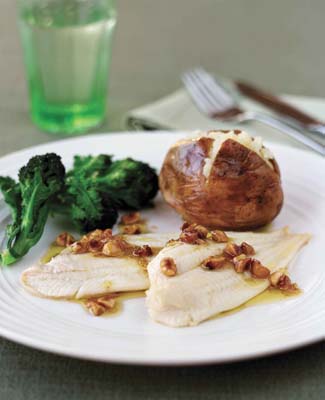 Sole with Lemon & Hazelnut Sauce and Purple Sprouting Broccoli
Sole with Lemon & Hazelnut Sauce and Purple Sprouting Broccoli This recipe is the classic pairing of sole and Bénédictine liqueur, which is a brandy or cognac based herbal beverage produced in France. You can other flat fish fillets - plaice, brill or black sole - and sprouting broccoli is an ideal accompaniment in all cases.
It is a treat of a dish, from the wonderful book, From Tide To Table, that we published in partnership with BIM - and which won both a Gourmand World Cookbook Award and the Food Book of the Year at the 2009 Listowel Food Fair.
Click for recipe
Buttered Purple Sprouting Broccoli
This is a great way to ensure that broccoli is perfect every time. It can be cooked and refreshed a few hours in advance, which guarantees no more over-cooked lifeless specimens. Purple sprouting broccoli is in season in late winter and early spring, and a much more interesting vegetable than the ubiquitous calabrese.
Click for recipe
Cultured Mushrooms
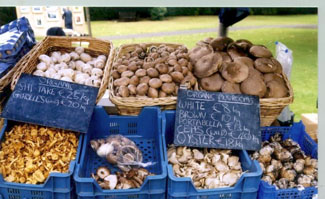
 As the winter vegetables near the end of their season and the new season outdoor crops are far from maturity, food grown under protection comes into focus. And what more reliable or useful allies could we have in the kitchen than mushrooms, in all their variety.
As the winter vegetables near the end of their season and the new season outdoor crops are far from maturity, food grown under protection comes into focus. And what more reliable or useful allies could we have in the kitchen than mushrooms, in all their variety. Mushrooms are an important crop in Ireland, as they can be grown successfully almost anywhere under controlled conditions all year round, without dependence on good soil or predictable weather.
The edible fungi psalliota competris is widely grown on a commercial scale, and grows rapidly once given the right conditions. The three most popular mushrooms - button, cup and flat - are different stages of development of one mushroom type.
Other cultivated mushrooms include Portobello (big and beefy), Chestnut Mushrooms (immature Portobello mushrooms, good flavour), Oyster Mushrooms (named for their unusual colour, with a very mild flavour; originally wild but now cultivated) and Shiitake mushrooms (originally wild Chinese mushrooms, now widely cultivated).
Mushrooms of all the various types are widely available at farmers' markets and from all greengrocers and supermarkets, all year round.
They are among every cook’s most versatile ingredients and can be used raw or cooked in a huge variety of ways; a staple of the traditional Irish breakfast, they’re also delicious on toast, stuffed, in pies and made into soups.
Big breakfast mushrooms make a delicious quick lunch when topped with chopped garlic a dab of butter, seasoning and sliced black pudding – just bake or microwave and serve on toast.
Buy mushrooms as fresh as you can, put in a paper bag to avoid condensation, and store them in the fridge for up to four days. (If you keep them longer they may be past their best, but it is interesting to see that they continue growing in the cool, dark conditions!).
To prepare, wipe with a damp cloth and trim as required – avoid peeling if possible. Grill, fry, roast (with garlic butter perhaps), or use in a wide range of dishes.
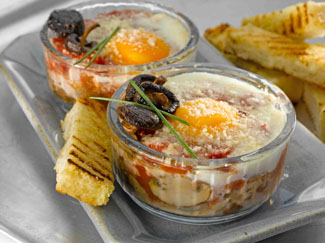 RECIPE: Baked Eggs with Smoked Ham and Mushrooms
RECIPE: Baked Eggs with Smoked Ham and Mushrooms Smoked ham and eggs make good partners – this tasty baked brunch or snack can be on the table in 15 minutes. Un-smoked ham may of course be used if preferred.
Serves 4
Click for recipe
Sorrel
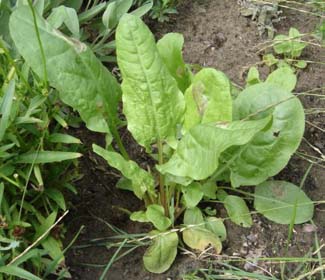
 Sorrel is a rich green acidic-tasting salad herb or green vegetable that looks and behaves rather like a cross between a dock and a smallish pointed-leaved type of spinach.
Sorrel is a rich green acidic-tasting salad herb or green vegetable that looks and behaves rather like a cross between a dock and a smallish pointed-leaved type of spinach. It grows abundantly in the wild in Ireland, and the tender young leaves are coming up everywhere in sun-dappled woodland and verges at this time of year (spring).
You can forage for wild sorrel, of course, or you might even find it on sale from good greengrocers, specialist organic suppliers or farmers' markets. However, when you see sorrel for sale it is much more likely to be the cultivated variety, which you could also grow yourself; seeds are available from garden centres and this is a good time to sow them.
It is a perennial and comes up each spring; it can be harvested at any time when the leaves are growing strongly then you cut it back when it flowers, before it goes to seed.
Sorrel is highly-prized by chefs for its refreshing acidic tang. It can be cooked in virtually all the ways suitable for spinach or lettuce and at this time of year, when the leaves are tender, they can be used raw in salads, or chopped into egg sandwiches or fillings - the classic dish 'green eggs' is made by mashing the yolks hard-boiled eggs with a purée of sorrel cooked gently in butter and cream cheese, seasoning and piling the mixture back into the egg whites before serving with a crisp green salad; like spinach, it has an affiliation with nutmeg which is often used when seasoning sorrel.
It can be used as a filling for omelettes, goes well with fish or poultry (in stuffings or sauces) and also makes a lovely spring soup, perhaps with other green leaves like lettuce, spinach and watercress - or other wild leaves like young dandelions or nettles.
 Thanks to its acidity and lemony tang, it works especially well with oily fish such as trout and salmon – making it a perfect ingredient for a mixed leaf garnish to serve with smoked salmon, for example.
Thanks to its acidity and lemony tang, it works especially well with oily fish such as trout and salmon – making it a perfect ingredient for a mixed leaf garnish to serve with smoked salmon, for example.
Aubergine
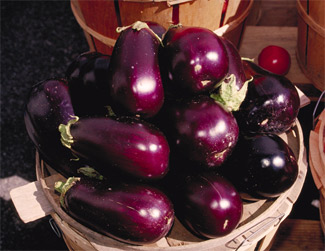
 The aubergine (also known as eggplant) is related to the potato and tomato. Native to India, this exotic looking fruit with its beautiful glossy deep purple skin and fleshy texture, is a popular import but it has never been commercially grown in Ireland – until now.
The aubergine (also known as eggplant) is related to the potato and tomato. Native to India, this exotic looking fruit with its beautiful glossy deep purple skin and fleshy texture, is a popular import but it has never been commercially grown in Ireland – until now. This year - in March 2012 to be exact – the north Dublin producers Keelings harvested their first crop of Irish aubergines.
Planted in December in their state-of-the-art glasshouses in St Margaret’s, Co. Dublin, the harvesting season runs from March through to the end of October.
This is great news for Irish shoppers as Irish aubergines are 2 days fresher than those coming in from Holland - so, not only are we saving food miles and supporting Irish jobs by buying Irish, but we’re guaranteed fresher produce too.
Two varieties are being grown in the Keelings glasshouses and the company – which employs over 1,400 people in Ireland and about 2,000 people across the group - estimates that they will be picking 4 tonnes of Irish aubergines a week. Definitely an item to remember on the shopping list this season.
Popular in many cultures, both flesh and skin of the aubergine are edible and, as the flesh is very absorbent, it is well suited to long slow cooking and develops a rich flavour when cooked in dishes like ratatouille and moussaka. The raw fruit is traditionally salted, rinsed and drained to offset any possible bitter taste, but modern varieties are unlikely to need any special treatment.
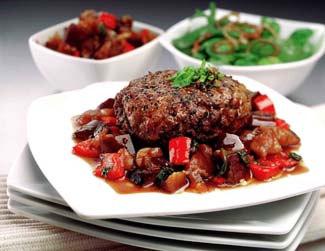 RECIPE: Beef Burgers with Sweet & Sour Aubergine
RECIPE: Beef Burgers with Sweet & Sour Aubergine This dressed up burger recipe with a juicy sauce is inexpensive yet suitable for any occasion. Irish grown red peppers from Keelings are also available and you might try using one of the growing number of Irish rapeseed oils, eg Derrycamma, from Co Louth, Dongeal Rapeseed Oil from farms in Donegal and Northern Ireland, and Second Nature/Happy Heart from Co Kilkenny.
Serves 4
Burgers:
450g/ 1 lb lean minced Irish beef
1 onion, finely chopped, sautéed in a little oil
1-2 cloves garlic, chopped
1 tablespoon basil, chopped
Salt & black pepper
Sweet & Sour Aubergine Sauce:
30ml/2 tablespoons oil
2-3 shallots or 1 onion, chopped
1 aubergine, diced
1 red pepper, deseeded, diced
15ml/1 tablespoon soy sauce
15ml/1 tablespoon balsamic vinegar
15ml/1 tablespoon lemon juice
125ml /4 fl oz tomato juice
5ml/1 teaspoon sugar
Handful of basil, chopped
Combine the burger ingredients and shape into 4 burgers.
Grill or barbecue for 8-10 minutes, until fully cooked.
Meanwhile, make up the aubergine sauce.
Heat the oil, sauté the shallots, aubergine and pepper until just soft.
Add the soy, balsamic vinegar, lemon juice, tomato juice, sugar and basil. Simmer for 4-5 minutes.
Taste for seasoning.
Serve with rice or baked potatoes and a seasonal green vegetable or side salad.
Broad Beans
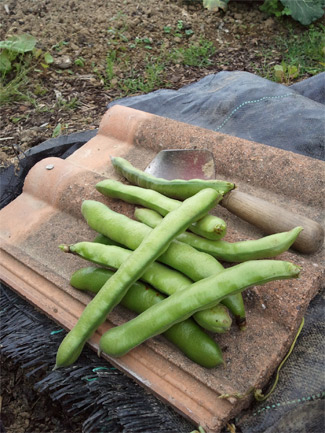
 Harbingers of summer, broad beans are among the earliest crops to be harvested in Britain and Ireland, and all the more welcome for that. Also known by different names in other cultures (notably fava bean and field bean), Vicia faba has been cultivated since the ancient civilisations and is still a staple crop in many countries today.
Harbingers of summer, broad beans are among the earliest crops to be harvested in Britain and Ireland, and all the more welcome for that. Also known by different names in other cultures (notably fava bean and field bean), Vicia faba has been cultivated since the ancient civilisations and is still a staple crop in many countries today. It is a great garden crop as it is so hardy that the seeds can be sown in autumn and safely over-wintered (even in our recent hard winters), allowing growth to begins without delay in early spring. The plants grow quite tall, giving good returns for a small space; the stems are sturdy and, although they crop best if given support, that is easily done (eg growing through large gauge netting) and dwarf varieties are also available.
The edible seeds are encased in a leathery green velvet-lined pod, and are best eaten when young and tender. They look more attractive if skinned to reveal the bright green inner bean (parboil briefly to loosen the skins); this is usual practice in restaurant dishes, but not necessary at home unless the beans are large and the skin has toughened.
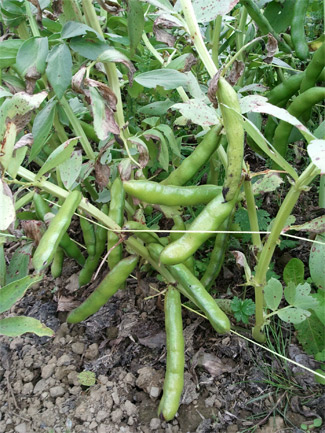 Like most of the pea and bean family, broad beans are very nutritious – they are high in protein, carbohydrate and dietary fibre along with calcium, iron and numerous trace elements - and versatile. Widely used in Mediterranean cooking (see the recipe for hummus in Michael Kelly’s GIY column), they are also an important food in many other regions, including Africa, some parts of India, Iran and China; they are used both fresh and dried.
Like most of the pea and bean family, broad beans are very nutritious – they are high in protein, carbohydrate and dietary fibre along with calcium, iron and numerous trace elements - and versatile. Widely used in Mediterranean cooking (see the recipe for hummus in Michael Kelly’s GIY column), they are also an important food in many other regions, including Africa, some parts of India, Iran and China; they are used both fresh and dried. Here, favourite uses include enjoying them as an early season side dish with spring lamb, for example, and raw or cooked in salads. Their mild flavour means that broad beans combine well with many other ingredients and they have special affinity with some of the fresh herbs which are in season at the same time, notably parsley, mint, chervil and coriander.
RECIPE:
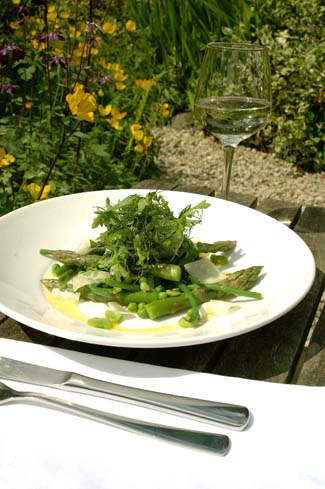 Newforge House Spring Green Vegetable & Garden Herb Salad with Gabriel Shavings
Newforge House Spring Green Vegetable & Garden Herb Salad with Gabriel ShavingsThis recipe comes from Newforge House, John and Louise Mathers’ delightful Georgian country house at Magherlin, Co Armagh, which is in a peaceful rural setting a short distance south-west of Belfast. It features in Irish Country House Cooking, a collection of recipes from the lovely properties in Ireland’s Blue Book.
John is the chef and he says “In May our small vegetable patch springs to life again with the arrival of asparagus. The combination of all the wonderful fresh herbs and green vegetables with salty Gabriel (Ireland’s equivalent of Parmesan) is fantastic.”
The asparagus season continues until late June (midsummer day traditionally marks the time when cutting should end) and, although it is currently only grown in private gardens, it grows well in Ireland and there is potential for its commercial development.
Alternative local ingredients to consider for this refreshing salad are natural cider vinegar (from craft producers such as Llewellyn’s Co Dublin; The Apple Farm, Co Tipperary; or Armagh Cider Company) to replace the wine vinegar; and rapeseed oil (Derrycamma, Co Louth; Happy Heart/Second Nature, Co Kilkenny; or Donegal Rapeseed Oil for example).
Also, Glebe Brethan is a newer unpasteurised thermophilic cheese, made in a similar way to the longstanding West Cork favourite, Gabriel.
Serves 4
4 shallots, peeled & finely sliced
white wine vinegar (enough to cover the sliced shallots)
12 asparagus spears, trimmed
4oz/100g fine beans, topped & tailed
4oz/100g fresh or frozen peas
4oz/100g broad beans
4 small handfuls of washed and dried garden herbs, e.g. mint, chervil, chives, dill, basil, tarragon & rocket
15ml/1 tablespoon Dijon mustard
salt & freshly ground pepper
9 tablespoons /135ml extra virgin olive oil
1½ oz/ 40g Gabriel cheese, or Parmesan
Cover the shallots with white wine vinegar and leave aside to soak for 10-15 minutes.
Meanwhile, blanch each of the vegetables in salted boiling water until each is just al dente.
Drain immediately and plunge into iced water to refresh the vegetables and retain their bright green colour. Drain the vegetables well when cooled, and skin the broad beans (if you wish).
Remove the shallots from the vinegar and place in a large bowl with the vegetables.
In a separate bowl mix 3 tablespoons of the shallot-infused vinegar with the mustard. Season with a pinch of salt and freshly ground pepper. Then whisk in the extra virgin olive oil until the dressing emulsifies. Taste and adjust the seasoning as required.
Dress the vegetable and shallot mixture with 6 tablespoons of the vinaigrette, season and toss. Then divide the dressed vegetables between four plates and scatter with Gabriel Cheese shavings.
In a bowl dress the herb salad with 1 tablespoon of vinaigrette and season with a pinch of salt. Place a small handful of the dressed herbs on top of each plate of vegetables.
Finally drizzle each plate with any remaining vinaigrette and serve immediately.
Sea Vegetables
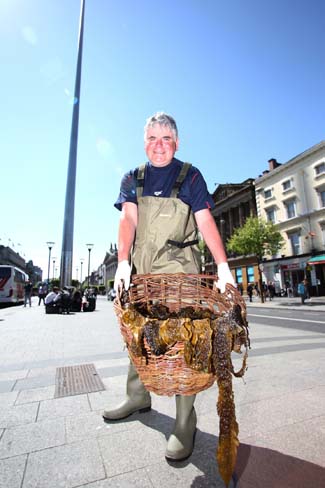
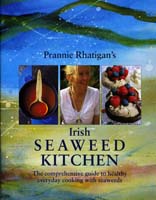 “Seaweed has always been an important part of life for Ireland’s coastal communities, for use on the land and in the home,” says Sligo GP and Slow Food member Prannie Rhatigan in her book Irish Seaweed Kitchen (www.prannie.com).
“Seaweed has always been an important part of life for Ireland’s coastal communities, for use on the land and in the home,” says Sligo GP and Slow Food member Prannie Rhatigan in her book Irish Seaweed Kitchen (www.prannie.com).“Today, the shoreline is mysterious to many of us - but it’s as familiar as the back garden to families living along the coast or on islands, who have grown up with the rhythm of the tides and the briney harvest that is revealed every twelve hours.” She describes seaweed as “... a living treasure by the shore, more valuable by far than any golden coins that may lie buried beside it in the sand” and, thanks to her book, many people taking holidays around Ireland’s coastline will enjoy discovering that treasure for themselves. Fifteen varieties of red, brown and green seaweed feature, all with (considerable) health benefits as well as culinary uses. Some may already be familiar - carrageen (carraigín), for example, is still widely used as a setting agent, and dillisk (duileasc) has many current uses. Prannie recommends starting with easy to use seaweeds in simple recipes, and a full list of Irish seaweed suppliers is in her book, also web addresses for buying online.
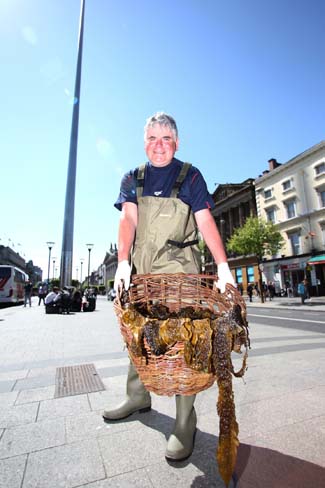 Seaweeds are easily found in shops and online, and you will see them on menus in the region too – including restaurants on the islands, which also feature produce grown on small holdings and in gardens, wherever shelter can be found.
Seaweeds are easily found in shops and online, and you will see them on menus in the region too – including restaurants on the islands, which also feature produce grown on small holdings and in gardens, wherever shelter can be found.Irish suppliers of sustainably harvested seaweeds include Shane Forsythe’s Cleggan Seaweed Company (www.clegganseaweed.com), in Co Galway, which produces a range of sea pickles as well smartly packaged dried seaweeds. On the Aran Islands, edible seaweeds are harvested commercially by Mairtin Concannon of the small company Blath na Mara (+353 (0)99 61411), on Inis Mor; various seaweeds - including dillisk (Palmaria palmata), kombu (Laminaria digitata) and carrageen (Chondrus crispus) - are harvested by hand and dried for use as sea vegetables.
At Burtonport, Co. Donegal, Manus McGonagle’s company Quality Sea Veg (www.qualityseaveg.ie) offers a range of hand-harvested & air-dried seaweed products.
 Manus, who has harvested seaweed on the Donegal coast since he was a child, recently received the highly respected recognition of a 2012 EirGrid/Euro-Toques Food Award – and, at the same ceremony, Euro-Toques also gave a Special Acknowledgement to Dr. Prannie Rhatigan, for her contribution to reviving the culinary use of seaweed in Ireland and a Special Award For Outstanding Contribution to Irish Food to Gerry Galvin; “former chef & restaurant owner, food writer, poet, novelist”, he was a founder of Euro-toques Ireland, along with Myrtle Allen of Ballymaloe House, and previously the organisation’s Commissioner-General (President).
Manus, who has harvested seaweed on the Donegal coast since he was a child, recently received the highly respected recognition of a 2012 EirGrid/Euro-Toques Food Award – and, at the same ceremony, Euro-Toques also gave a Special Acknowledgement to Dr. Prannie Rhatigan, for her contribution to reviving the culinary use of seaweed in Ireland and a Special Award For Outstanding Contribution to Irish Food to Gerry Galvin; “former chef & restaurant owner, food writer, poet, novelist”, he was a founder of Euro-toques Ireland, along with Myrtle Allen of Ballymaloe House, and previously the organisation’s Commissioner-General (President). 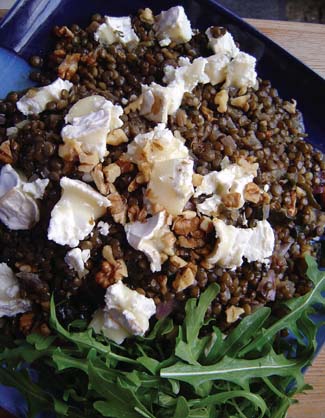 RECIPE: Puy lentils and Alaria with goats’ cheese salad
RECIPE: Puy lentils and Alaria with goats’ cheese saladThe combination of oils and spices in the salad dressing given in this recipe from Irish Seaweed Kitchen perfectly complements the robust flavour of goats' cheese, while the Alaria gives the puy lentils a real flavour lift. Puy lentils are ideal for salads because of their unique peppery flavour and the fact they hold their shape during cooking. They are identified by the area of cultivation where they are grown, in the Le Puy region of France.
Take time to really savour the first mouthful.
You might try using a locally produced oil instead of olive oil in this recipe, eg Donegal Rapeseed Oil, which is widely available. GC
Serves 4
Seaweed used: Alaria
225g (8oz) puy lentils
1 red onion chopped finely
olive oil, for frying
1 bay leaf
1/2 tablespoon thyme, destalked and finely chopped
l5cm (6 inch) piece Alaria (about 5g) snipped into 0.5 - 1cm (1/4-1/2 inch) pieces
5ml (1 pint 10fl oz) stock
DRESSING
1 garlic clove, crushed
1 level teaspoon mustard powder
2 tablespoons lemon juice
2 tablespoons walnut oil
3 tablespoons olive oil
85g (3oz) walnuts
1 tablespoon mixed sea vegetables, chopped
1 large handful rocket leaves
115g (4oz) firm white goats' cheese, crumbled
1 Rinse the lentils under cold running water, place in
saucepan, cover with cold water and bring to the
boil. Simmer for 5 minutes. Drain and rinse well, to
remove indigestible starches. Set aside.
2 In a large heavy based saucepan saute the onion in olive oil over moderate heat until softened.
3 Add the par-cooked lentils, bay leaf, thyme and Alaria and stir briefly.
4 Pour in the stock, cover and simmer for 40 minutes until cooked. Drain any remaining liquid and keep warm.
To prepare dressing and assemble the salad
1 In a large bowl combine the garlic, mustard, lemon juice and oils. Toss the hot lentils in the dressing.
2 Add half of the walnuts, half of the sea vegetables and the rocket, and toss well.
3 Sprinkle cheese over the top and toss again. Scatter the remaining mixed sea vegetables and
walnuts over the salad. Serve warm.
COOK'S TIP
For an extra vegetable boost add more lightly dressed salad leaves and mop up the salad dressing in some crusty bread.
Sweetcorn
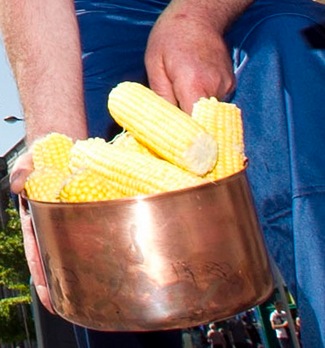
 Sweetcorn (Zea mays convar. saccharata var. rugosa; also known as Indian corn, sugar corn, and pole corn) is a variety of maize with a high sugar content and antioxidant health benefits. Picked when immature, while the kernels are still milky, it is mainly used in Europe as a vegetable rather than a grain, although ‘yellow meal’ maize flour was widely used for bread making in the famine years and the tradition has endured to this day in some parts.
Sweetcorn (Zea mays convar. saccharata var. rugosa; also known as Indian corn, sugar corn, and pole corn) is a variety of maize with a high sugar content and antioxidant health benefits. Picked when immature, while the kernels are still milky, it is mainly used in Europe as a vegetable rather than a grain, although ‘yellow meal’ maize flour was widely used for bread making in the famine years and the tradition has endured to this day in some parts.
Mainly associated with warmer climates, it is not exactly a traditional crop in Ireland, but new varieties have made it a popular choice to grow in gardens and allotments in recent years - and this is the best time of year to taste the difference between the locally grown product and imported sweetcorn sold as ‘fresh’.
A Co Longford farmer, David Burns of Richmount Farm at Carrickboy, specialises in growing sweetcorn for the restaurant market and it is worth keeping an eye out for his name among suppliers listed on menus in good restaurants: tasting his fresh sweetcorn could change your view of this usually imported product.
 Formerly a dairy farmer, he began growing maize for fodder – something he continues to do for other farmers, although he is no longer dairy farming, and his fodder crop even feeds the gorillas and elephants at Dublin Zoo.
Formerly a dairy farmer, he began growing maize for fodder – something he continues to do for other farmers, although he is no longer dairy farming, and his fodder crop even feeds the gorillas and elephants at Dublin Zoo.
About a decade or so ago, he decided to try growing sweet corn too. It grew well and was well received, but selling it into a supermarket chain proved to be a “very bad experience”, so he and his wide Martina began selling at farmers’ markets around Dublin, assisted by chef Gary O’Hanlon of Viewmount House, Co Longford, who made a sweetcorn soup for them to sell - and, along with leading Dublin chef Ross Lewis of Chapter One Restaurant - championed David Burns for a Euro-Toques Award that he received earlier this year, “for taking the brave step of diversifying his farm activity and taking his produce direct to market, and for supplying chefs with a fresh seasonal Irish ingredient in peak condition.”
There’s now a waiting list of chefs interested in buying Richmount Farm corn during its short 6-8 week season in September-October, and David expects all of the 2012 crop will go to restaurants – who pay 3 times the price the supermarket was paying. His USP is that he picks the corn in the afternoon and delivers it to the chef that evening. “With sweetcorn”, he says, “Freshness is everything”.
Fresh sweetcorn is probably best enjoyed when cooked very simply – try it just boiled on the cob and served with a knob of country butter – but it is a versatile ingredients in many dishes, including the popular soup.
Sweetcorn Soup
This simple recipe comes from the Scottish chef, Nick Nairn.
Ingredients
2 tbsp olive oil
50g/1¾oz unsalted butter
1 garlic clove, finely chopped
1 onion, finely sliced
150g/5½oz potato, cut into small cubes
200g/7oz sweetcorn
600ml/20fl oz hot vegetable stock
50ml/2fl oz double cream
salt and freshly ground black pepper
1 tsp fresh chives, finely chopped
Heat the olive oil with the butter in a frying pan over a medium heat. Once the butter has melted add the garlic, onion and potato and sauté for five minutes, until softened.
Add the sweetcorn and continue to cook for two more minutes.
Add the stock, bring to the boil, then reduce the heat to simmer for five minutes, until the potato has cooked through.
Stir in the cream and season, to taste, with salt and freshly ground black pepper, then pour into a food processor and blend until smooth.
To serve, pour into a warm bowl and garnish a sprinkle of chives.
Hill Lamb
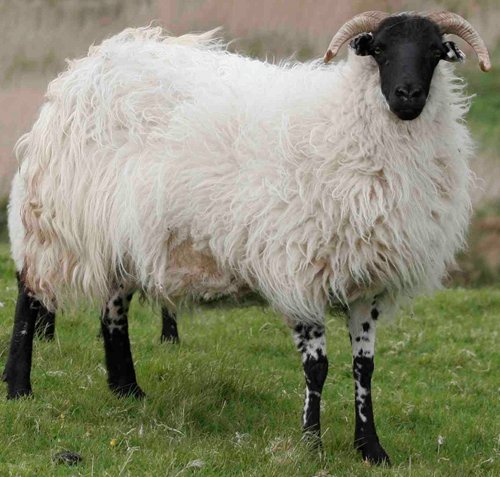
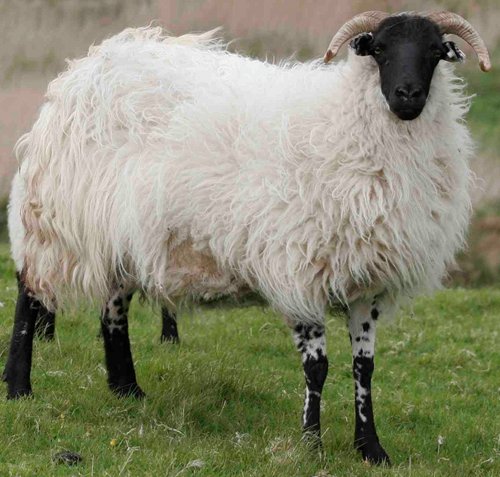 Coming from areas such as Connemara, Kerry and West Waterford, where a rugged terrain with heathers, wild herbs and grasses produces a distinctive texture and herbal flavour, Irish hill lamb is smaller and leaner than its lowland cousins and its season is much later, running from late summer to early winter. During the last decade it has become recognised as a delicacy – and one with added health benefits at that - and is increasingly seen under regional branding.
Coming from areas such as Connemara, Kerry and West Waterford, where a rugged terrain with heathers, wild herbs and grasses produces a distinctive texture and herbal flavour, Irish hill lamb is smaller and leaner than its lowland cousins and its season is much later, running from late summer to early winter. During the last decade it has become recognised as a delicacy – and one with added health benefits at that - and is increasingly seen under regional branding.
In West Galway, the Connemara Hill Lamb group (connemarahilllamb.ie) was established 1999 to protect and promote this unique product of the area, and successfully achieved the European Protected Geographical Indication (PGI) status in 2007. Others especially worth seeking out include Comeragh Mountain Lamb (comeraghmountainlamb.ie); and Ring of Kerry Quality Lamb (www.ringofkerryqualitylamb.ie).
The best restaurants are keen to showcase this special local food and, although retail availability varies, local butchers are always an ideal place to shop. Some Connemara Hill Lamb products are available through speciality butchers such as the fabled McGeoughs of Oughterard (connemarafinefoods.ie), renowned for their superb air-dried and smoked meats, but fresh meat is not yet offered online by the producer group.
In Waterford, Fáilte Ireland food champion Colin Jephson, of Ardkeen Quality Food Store (www.ardkeen.com), is a keen supporter of Comeragh Mountain Lamb, which is also available online from the producer group (comeraghmountainlamb.ie), as is Ring of Kerry Quality Lamb (ringofkerryqualitylamb.ie).
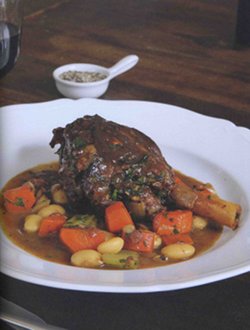 RECIPE: Braised Lamb Shanks With Garlic, Rosemary And Butterbeans
RECIPE: Braised Lamb Shanks With Garlic, Rosemary And Butterbeans
Although hill lamb is not specifically called for in this dish it would be a delicious choice. The recipe, from Paul Flynn of The Tannery restaurant in Dungarvan, Co Waterford, features in Martin&Paul’s Surf’n’Turf (Quadrille), which is based on the RTE series of the same name.
Gorgeous comfort food and ideal for the time of year, it perfectly illustrates Paul’s wonderfully down to earth way with food. Paul likes to serve it with celeriac mashed potatoes, to mop up the juices.
Serves 4
2 carrots
2 celery sticks
1 leek
2 small onions
plain flour, to dust
sea salt
freshly ground black pepper
4 lamb shanks
2 tbsp duck fat or olive oil,
plus a little more
4 garlic cloves
2 good sprigs of flat-leaf parsley, plus ½ bunch, chopped, to serve
1 bay leaf
1/2 bottle red wine
400ml chicken stock or water
400g can butterbeans, drained and rinsed
Preheat the oven to 160ºC/325ºF/gas mark 3.
Cut the carrots, celery, leek and onions into relatively even 2cm chunks.
Put some flour in a broad, shallow dish, and season it well with salt and pepper. Turn the shanks in the seasoned flour to coat, then pat off the excess.
Heat the duck fat or oil in a casserole over a medium heat, then fry the lamb, turning, until golden and crispy. Remove from the casserole and set aside.
Drain off the excess fat and add some fresh oil. Add the carrots, celery, leek, onions, garlic, sprigs of parsley and bay leaf and cook over a high heat until the vegetables are browned.
Deglaze the casserole by adding the red wine, scraping the residue on the bottom of the pan and stirring well. Add the stock or water, place the shanks on top of the vegetables, cover and cook in the oven for 2½ hours.
When the lamb is cooked, skim the fat from the top of the sauce, add the butterbeans and chopped parsley, and season to taste. Place over a medium heat until just heated through, then serve.
Red Cabbage
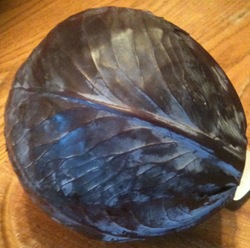
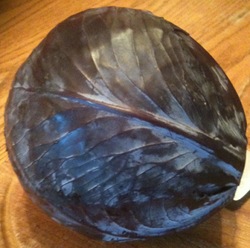 Red cabbage (Brassica oleracea var. capitata f. rubra) is by far the most the most useful leaf vegetable you could have in the house over Christmas: when stored in a cool place it will hold almost indefinitely until you need it; it’s equally good eaten raw or cooked and, unlike any of its cousins, this versatile drumhead brassica not only holds well in a salad but also freezes extremely successfully when cooked - and reheats without ill effect, allowing you the convenience of having a delicious ‘green’ side dish that can be prepared well ahead and will be ready to go for any size of gathering.
Red cabbage (Brassica oleracea var. capitata f. rubra) is by far the most the most useful leaf vegetable you could have in the house over Christmas: when stored in a cool place it will hold almost indefinitely until you need it; it’s equally good eaten raw or cooked and, unlike any of its cousins, this versatile drumhead brassica not only holds well in a salad but also freezes extremely successfully when cooked - and reheats without ill effect, allowing you the convenience of having a delicious ‘green’ side dish that can be prepared well ahead and will be ready to go for any size of gathering.
It can also be pickled or fermented, using preservation methods which have recently become fashionable in restaurant kitchens along with growing interest in all things northern European, although – unlike its green and white leaved relatives – there is really no need to do this as red cabbage is such a good keeper in its natural state.
The fine specimen shown here was grown at Termonfeckin, Co Louth by Gerry Finnegan, a member of the new Oriel Food Group, an association of fine food producers from the ancient lands of Oriel in the north-east of Ireland. This group – which includes producers as diverse as Aruna Sauces (Ardee) and the raw-milk Bellingham Blue Cheese (Castlebellingham) – was among the most interesting finds at this year’s Food & Wine Christmas Show.
I bought this handsome vegetable, which weighed in at almost 2kg, for the princely sum of €2 – and they say that Irish food is expensive! We’ll get many a meal out of it in the coming weeks, both hot (in my favourite winter side dish, Red Cabbage with Apple) and cold, in robust salads such as the one below.
And here’s an interesting little aside on red cabbage that, as Michael Caine used to say, not a lot of people know: like hydrangea flowers, which vary from pink to blue depending on the soil pH, an acidic soil produces magnificently deep purple-red leaves, but they will be greener if grown on an alkaline soil.
Red cabbage changes colour in cooking too, turning a dark violet blue unless cooked with acidic ingredients such as vinegar and/or fruit which allow it to retain its attractive red colour; happily this also provides a complementary flavour combination
 Red Cabbage & Apple Slaw
Red Cabbage & Apple Slaw
An infinitely adaptable recipe for use throughout the winter. The hard vegetables will hold well, so avoid including the softer-leaved ingredients if you want to keep the salad for use over a day or two. A combination of red cabbage and a green or white drumhead variety will keep well. Thinned mayonnaise also makes a good quick dressing, just add a little milk or single cream and blend to the desired consistency. A crusty, robustly-textured bread, such as sour dough, is good with this kind of salad.
Serves about 4-6
About 225g/8oz red cabbage (1/4 of a large cabbage), cored & finely sliced
2 large carrots, peeled and coarsely grated
1 apple, preferably red and left skin-on, quartered and cored
25g/1oz fresh walnuts or pecans, halved
A few handfuls of crisp winter salad leaves, eg curly endive, radicchio, lambs lettuce (optional)
For the dressing:
4 tbsp natural yogurt
Juice of 1 small lemon, and finely grated zest to taste
1/2 tsp caster sugar
Sea salt & freshly ground black pepper to taste
Place the finely shredded red cabbage in a large bowl with the coarsely grated carrot in a large bowl. Slice in the apple, add a tablespoonful of the lemon juice and toss to mix. Add the walnuts or pecans, and salad leaves (if using). Toss together.
Whisk all the dressing ingredients together, including seasoning to taste. Drizzle the dressing over the salad, toss well and serve.
Lemons
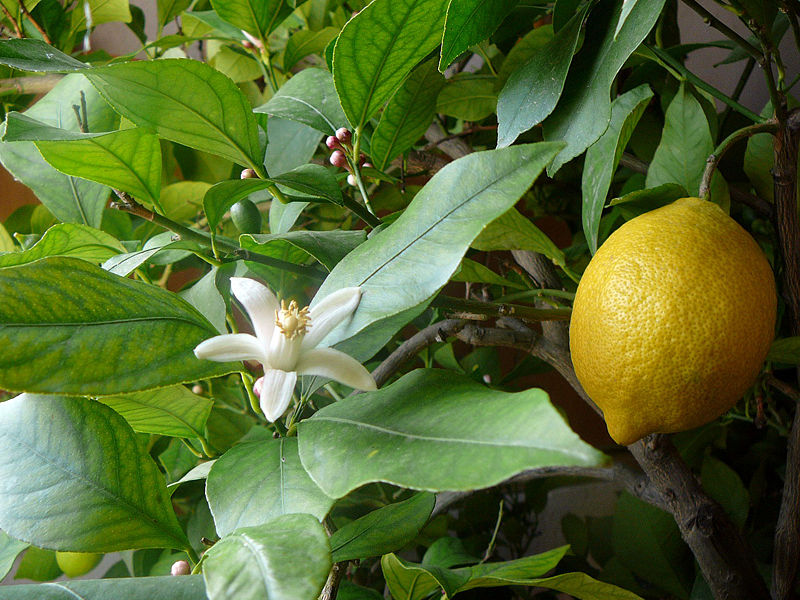

Lemons can also be grown here with care, in pots as they not reliably hardy. Anyone who has ever tasted fresh lemons will want to do so again, so this could be a rewarding challenge for the New Year and much more fun than dieting. The “compact and easy 'La Valette' ” variety was recently recommended in the ever-reliable Daily Telegraph gardening supplement.
The juice, pulp, peel and zest, are all used in a wide range of foods; lemon juice is about 5% to 6% citric acid, which not only gives it a distinctive sour taste but also broadens its range of uses - as, for example, water acidulated with lemon juice prevents the oxidisation (browning) of foods such as apples that have been prepared before cooking.
The high vitamin C content and refreshing acidity of lemon makes it especially welcome in drinks; it’s useful in marinades, both for flavouring and to tenderise meats; in dressings (or on its own, eg the traditional squeeze of juice with fish or pancakes); and in preserves (notably marmalade); as well as simply a pleasing flavouring that lifts any number of sweet and savoury dishes.
Candied lemon peel is an essential ingredient in baking, while preserved (pickled) lemons, which are particularly associated with North African and Indian cuisines, are becoming popular in Europe.
Aside from cooking, lemons - like vinegar - have many household uses; eg as a cleaning agent (notably as a metal cleaner - half a lemon dipped in salt or baking powder/bread soda was traditionally used to shine up copper cookware), stain remover (bleach), disinfectant, deodoriser and even as a natural insecticide.
All round, this little ray of sunshine is indispensable and every home should have one - or more.
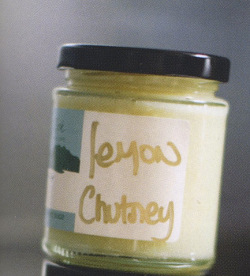 RECIPE Lemon chutney
RECIPE Lemon chutney
The most useful recipes in chefs’ cookbooks are often the sauces and accompaniments - all those interesting small extras that can lift a simple dish.
This simple lemon chutney from a ‘Dips & Dressings’ chapter in Gary Stafford’s book Lyons Café, The Recipes is a good example: “…perfect served with fish in place of lemon wedges, it’s an essential larder ingredient that can be made with little fuss. Stores well in the fridge and also freezes well. Try freezing in ice cube trays before transferring to zip-lock bags to keep in freezer until needed.”
1 lemon (unwaxed/organic if possible)
1 litre water
250g sugar
Bring the water to the boil, add the sugar and the whole lemon and cover with a wet cloth so it acts as a damp lid over the pan.
Gently simmer for 1 hour. Remove the lemon and blend to a purée in a food processor, adding just a little cooking liquid so that the mixture remains firm.
Clams
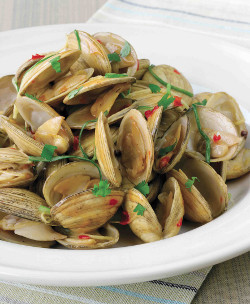
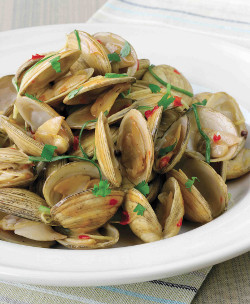 With pretty coloured shells, Palourde clams, tapes semidecussatus, are also known as ‘carpetshell’ or ‘Manila’ clams, and were introduced to Ireland in the early 1980s. Since then palourde clams have been farmed here in places with the required sandy beaches, notably in Co Sligo and Kerry. Although there is a wild native Irish relative (the ‘White Palourde’), the farmed variety is the one most often see in Irish fish shops.
With pretty coloured shells, Palourde clams, tapes semidecussatus, are also known as ‘carpetshell’ or ‘Manila’ clams, and were introduced to Ireland in the early 1980s. Since then palourde clams have been farmed here in places with the required sandy beaches, notably in Co Sligo and Kerry. Although there is a wild native Irish relative (the ‘White Palourde’), the farmed variety is the one most often see in Irish fish shops.
Brothers Paul and Michael O'Sullivan, of the Kerry producer Caragh Clams Ltd (www.caraghclams.com), explain the production process: “The Manila Clam seed is purchased from certified Irish hatcheries and placed in nursery frames specially designed for clams until they are ready for planting in the sand. The growth cycle for the clams is approximately 3 years. After receiving an order, our harvest team removes the clams from Rossbeigh Creek, Glenbeigh, and they are delivered to our grading machine where the clams are graded and checked for quality. We also have facilities for purification if required. They are sized by the number per kilo - small clams: 65-80/kg; medium clams: 55-65/kg; large clams: 40-55/kg.”
Palourde clams are mainly produced for export, but have recently become popular in Irish restaurants. They are now available on the Irish market all year although, like other shellfish, they are probably at their best in the colder months. They are quick and easy to cook.
RECIPE: Wok-Fried Clams with Spring Onions, Chilli & Ginger Butter
This recipe is from From Tide To Table (Epicure Press) and was contributed by Martin ‘Mad About Fish’ Shanahan of the renowned Fishy Fishy Café in Kinsale, County Cork. He suggests using 'carpetshell’ clams ('palourdes’) as they are so tender and sweet. This is a very popular way of cooking clams in the restaurant and it really does them justice.
1 kg/21/2lb fresh clams, washed
60g/21/4oz butter
2 tbsp sweet chilli sauce
2 tbsp shredded fresh root ginger
2 spring onions, finely chopped
2 tbsp chopped fresh coriander plus extra to garnish
SERVES 4
Rinse the clams quickly in cold running water. Place in a pan with a tight fitting lid and steam for 2 minutes until opened; discard any that do not open.
Heat a wok or large frying pan until almost smoking. Add the butter, sweet chilli sauce, ginger, spring onions and coriander, and use a spoon to mix together quickly.
Tip the steamed clams into the wok, and toss a couple of times, so that all the sauce coats the clams. Transfer to warmed bowls, garnish with a little more coriander and serve at once.
VARIATION
You could make the same dish with mussels, steaming initially for 2-3 minutes.
Rhubarb
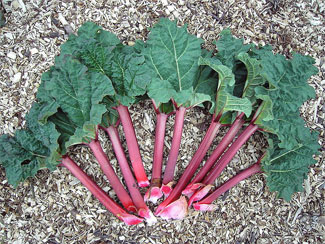
 What is it?
What is it?
Although usually used in sweet dishes, rhubarb is not a fruit but classed as a vegetable. It grows easily in Ireland and is still a familiar feature in gardens all over the country. It dies down in winter and now, as it begins to re-emerge for the new season (later than usual this year, due to the prolonged cold weather over the winter), the new stalks will be at their pinkest and most tender.
To get the most of this early crop, rhubarb crowns can be forced. To do this, the crowns are protected with newspaper or straw then covered - ideally with beautiful clay pots made especially for the purpose, but anything like large upturned boxes or bins will do; the stems then shoot up much earlier than usual and are exceptionally pink and sweet.
For an even earlier crop the crowns can be dug up in the late autumn, re-planted in large pots (or simply in black plastic bags) and brought in to a shed or greenhouse, then covered to exclude light.
Where can I get it?
Although the timing of all fresh produce is hard to predict this year as spring is on average a month later than usual, forced rhubarb is usually easy to find in early spring when the bright pink stems are to be seen on the shelves of greengrocers and supermarkets, and they should also be available from stalls at farmers’ markets.
Early varieties of ‘regular’ rhubarb are usually available from February-March until late summer too.
What can I do with it?
Forced rhubarb can be cooked in any of the ways used for mature rhubarb later in the season but the pink new season stems are so pretty that it is best to choose cooking methods that show them off to advantage. The early ‘fruit’ is not as bitter as the later crop so less sugar is needed in cooking, and it has an affinity with orange juice, which will add natural sugar.
To use as a compote, cook it very gently (eg in a slow cooker) so that it doesn’t break up, with water and/or orange juice and a little ordinary sugar (the sweetness can be adjusted at the end); show it off in a glass bowl and serve with crème fraiche.
It also looks very pretty in traditional pies and crumbles, or used as a sauce - with oily fish such as mackerel, for example.
RECIPE: Rhubarb Fool with Yoghurt & Granola
This simply delicious (and healthy) seasonal recipe was created by Derry Clarke of L'Ecrivain Restaurant.
Serves 4.
Ingredients:
50g sugar
100ml water
¼ cinnamon stick
1 star anise
150g peeled & diced rhubarb
200g natural yoghurt
1tsp organic honey
Method:
1. In a heavy based saucepan, make a light stock syrup with the sugar & water. Bring to the boil & infuse the cinnamon stick & star anise.
2. Add rhubarb & poach for 6-8 mins on a low heat until tender. Remove when cooked. Strain the cooking liquid and set aside.
3. Mix yoghurt with 1tbsp of the cold liquid, to sweeten.
4. Place the oats, flaked almonds & granola mix on a baking tray, drizzle with the honey & toast until golden brown
5. To serve, layer the granola, yoghurt and rhubarb in martini glasses, and then finish with a spoon of the rhubarb over the top. Decorate with a sprinkling of crunchy granola and a few pecans if you like.
Wild Primrose & Wild Sweet Violet

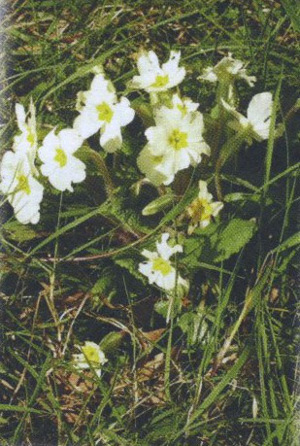 Wild herbs and edible flowers are a great addition to any kitchen and Biddy White Lennon and Evan Doyle devote a chapter of ‘Wild Food’ to these charmingly pretty and colourful foods.
Wild herbs and edible flowers are a great addition to any kitchen and Biddy White Lennon and Evan Doyle devote a chapter of ‘Wild Food’ to these charmingly pretty and colourful foods.
Wild Primrose (Primula vulgaris *Irish sabhaircin) and Wild Sweet Violet & (Viola odorata * Irish sail-chuach chumhra) are low-growing, common and easily found in woodland, hedgerows, and banks in spring and summer time. Violet leaves are almost evergreen while the primrose dies back after flowering.
A feature of both is that during their season the more you pick the more flowers grow. The leaves and flowers of both are edible and have a wonderful perfume. Use fresh to add colour and flavour to salads, desserts and drinks. There is along tradition of crystallising them for decorating cakes.
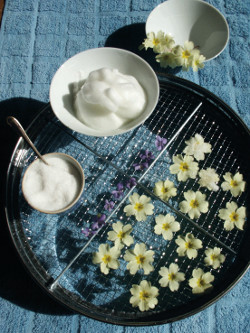 CRYSTALLISED PRIMROSES OR VIOLETS
CRYSTALLISED PRIMROSES OR VIOLETS
A labour of love, this recipe is for those with patience and steady hands. The result makes stunning decorations for cakes, desserts such as ice cream, syllabub, fruit salads and fruit tarts. You may wish to keep small children away as they are so delicious they eat them as fast as you make them.
A small basket of either flower, or both
2 egg whites
Caster sugar as needed
A small flat-shaped paint brush
A pair of tweezers
A wire rack for drying the flowers
Discard any flowers that are bruised or misshapen. Take each flower and remove all the stem and any green material at the base. Make sure the flowers are completely dry. Beat the egg white until frothy. Set up a production line. Flowers, egg white and sugar.
Grip the base of each flower and ‘paint’ each flower on both sides with the frothy egg white. Dip the brush into the caster sugar and paint each flower, making sure the surface of the flower is fully coated with sugar. You may use a sugar shaker or a teaspoon to sugar any part of the flower that has been missed in the dipping process.
Carefully place each flower base-side downwards on the wire rack. Dry in a warm place. If the air is high in humidity, place them in an oven set to the lowest possible temperature with the oven door slightly open.
Store the dried flowers, interleaved with tissue paper or waxed paper, in a box or wide-necked jar. Store in a dark dry place.
Eggs

 Eggs are synonymous with spring and they’re Nature’s convenience food - perfectly packaged and always accessible. They’re also highly nutritious (a concentrated source of protein with a wide range of vitamins and minerals), great value and the most versatile food imaginable.
Eggs are synonymous with spring and they’re Nature’s convenience food - perfectly packaged and always accessible. They’re also highly nutritious (a concentrated source of protein with a wide range of vitamins and minerals), great value and the most versatile food imaginable.
Chef Neven Maguire of MacNean House & Restaurant rustled up this handy post workout feed for the former Munster, Ireland and Lions legend, David Wallace, when he visited the Bord Bia Quality Kitchen to discuss how retiring from rugby has impacted on his eating habits. (Revealed: he now eats three meals a day like everyone else - instead of seven!)
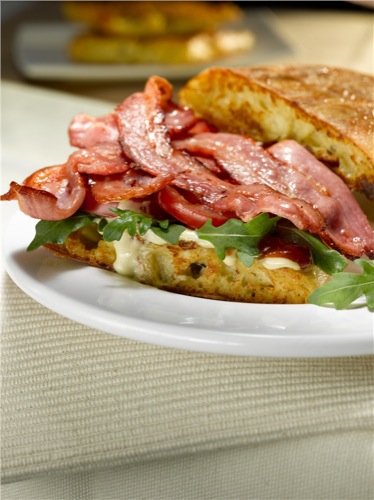 Eggy Bread BLT
Eggy Bread BLT
This high protein brunch dish could be the ultimate bacon sandwich. It’s a good idea to cook the bases of the ciabatta first so that you can start assembling the sandwiches whilst the tops are cooking. (Cooking Time: 15 minutes)
Serves: 4
Ingredients
4 eggs
2 tablesp. milk
Freshly ground black pepper
1 large ciabatta loaf
About 2 tablesp. olive oil
12 smoked streaky bacon rashers (Quality Approved), rinds removed
1 tablesp. good quality mustard
2 tablesp. of reduced fat mayonnaise
2 tablesp. tomato ketchup
25g rocket leaves
4 small vine tomatoes, finely sliced
Method
Crack the eggs into a shallow dish, add the milk, season and mix well to combine. Cut the ciabatta loaf into four even-sized pieces and then cut each one open so that you have eight separate pieces. Place each piece of the bread, cut-side down in the egg mixture. Leave to soak for a minute before turning over.
Heat a large frying pan and add half of the oil, then add the soaked bases of ciabatta, cut- side down. Cook over a medium to low heat -2 minutes until golden brown, then turn over and cook for another two minutes.
Meanwhile, preheat the grill. Arrange the bacon on a grill rack and cook for a couple of minutes on each side until really crispy. Keep warm.
Remove the ciabatta bases from the frying pan and keep warm. Add the remaining oil and then add the tops of the ciabatta. Cook as described above.
Mix together the mustard and the mayonnaise in a small bowl. Just before serving, spread half the mustard mayonnaise over the bases, next add a little ketchup, the rocket leaves, a layer of tomato slices and season with the black pepper.
Top with the bacon. Finish by spreading the remaining mustard mayonnaise on to the top half of the eggy bread.
In Season - Plums
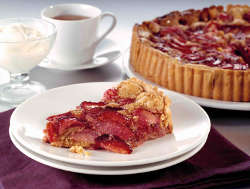
 What Are They? Prunus domestica is a group of hardy trees and shrubs which bear edible fruits containing stones; the type generally grown in Britain and Ireland is a cross between a sloe and a plum. Gages, which are similar (and have excellent flavour), tend to need more favourable growing conditions.
What Are They? Prunus domestica is a group of hardy trees and shrubs which bear edible fruits containing stones; the type generally grown in Britain and Ireland is a cross between a sloe and a plum. Gages, which are similar (and have excellent flavour), tend to need more favourable growing conditions.
Where Do They Come From? Many of the plums on sale in Ireland at this time of year come from continental Europe, but reliable all-rounders such as Victoria (red with dark speckling, good flavour for cooking and dessert use) grow well in Ireland.
Where Can I Get Them? You can grow your own of course (even in a tub, on a dwarfing rootstock); conveniently, Victoria thrives on a north or east-facing wall. Otherwise small shops may have supplies from local growers, and Irish grown plums should be available now in farmers’ markets – and a range of plums from here and abroad is available in bigger shops and supermarkets.
What Can I do With Them? The plum is a very versatile fruit, delicious eaten raw (with cheese, perhaps) when ripe, or cooked in desserts such as the Plum & Almond Tart below. They are lovely poached (serve warm with ice cream), split and then grilled or barbecued, or cooked and pureed to flavour ice cream or other desserts – and, of course, they make wonderful jams and preserves. If you break the stones open you can even eat the kernels, which have a delicious nutty flavour - and a reputation as a superfood, with qualities that are said to help defend the body against cancer.
RECIPE: Plum and Almond Tart
This is a delicious, simple seasonal dessert, and easy to make. Irish plums are in season now (Aug/Sep) and, while almonds need a warmer climate, they have been an important ingredient in Irish kitchens since the 18th century. Serves 8-10
Pastry:
180g/ 6 oz butter
75g/ 3 oz icing sugar
2 egg yolks, preferably free rage
225g/ 8 oz plain flour
Filling:
100/ 4 oz g soft butter
150g/ 5 oz sugar
100g/ 4 oz amaretto biscuits
200g/ 7 oz ground almonds
4 egg yolks, preferably free range
16 plums, approx (halved, stones removed, sliced)
To make the pastry: In a food processor, mix the butter, icing sugar and egg together. Add in the flour and blend until it forms a ball of pastry. Gather up into some clingwrap and chill for an hour.
To make the filling: Also in the processor, mix the butter, sugar, biscuits, ground almonds and egg yolks.
Set the oven to Gas Mark 4, 180ºC (350ºF). Roll out the pastry and use to line a 28cm diameter x 3cm deep tart tin. Chill for 10 minutes.
Pour in the filling mixture. Place the plum slices on top and sprinkle with an extra tablespoon of sugar.
Bake in the preheated oven for 45-50 minutes, until completely set and nicely browned.
Serve warm with whipped cream, crème fraiche or ice cream.
In Season - Wild Mushrooms

 Weather conditions in the late summer and early autumn this year have been ideal for fungi, which are prolific everywhere in our hedgerows, fields and woodlands, often well ahead of their normal season.
Weather conditions in the late summer and early autumn this year have been ideal for fungi, which are prolific everywhere in our hedgerows, fields and woodlands, often well ahead of their normal season.
Mixed woodland is ideal for foraging for fungi, especially where there are beech trees, and many desirable edible varieties thrive here. The Boletus family, for example, notably B. edulis (the penny bun, porcino or cep), which is a prize find.
Biddy White Lennon and Evan Doyle’s book Wild Food (O’Brien Press) is useful for identifying and making use of some of the edible fungi most commonly found in Ireland - St George’s Mushroom (mid spring-summer), chanterelle (late summer-autumn), field mushroom (late summer-early autumn), and cep or penny bun (late summer-autumn) - while Richard Mabey’s classic Food For Free (Collins) covers a wide range of those found in the UK and Ireland, with the little ‘backpack size’ edition especially useful.
I wished I had it with me recently when visiting Beech Hill Country House Hotel, Derry, as the range and quantity of fungi in their 33 acre wooded grounds was a wonderful surprise.
Guided mushroom hunts are offered in many areas, one of the longest established being the Annual Mushroom hunt at Longueville House (www.longuevillehouse.ie), Mallow, Co Cork, which takes place on two days - Sunday 06th & 20th October 2013 - and includes the ‘Legendary Luncheon’ prepared by proprietor-chef William O’Callaghan, and no doubt washed down with some of the excellent Longueville House Cider.
.jpg) This recipe for Wild Chanterelle Goulash is from The Strawberry Tree Restaurant at BrookLodge, which specialises in organic and wild foods and features in Biddy White Lennon and Evan Doyle’s book Wild Food (O’Brien Press).
This recipe for Wild Chanterelle Goulash is from The Strawberry Tree Restaurant at BrookLodge, which specialises in organic and wild foods and features in Biddy White Lennon and Evan Doyle’s book Wild Food (O’Brien Press).
In season from July-November, bright yellow chanterelles are easily spotted in clusters in woodland, notably in forests with birch, beech and mossy coniferous areas. Good in potato, egg and bacon dishes, they keep for couple of days in the fridge and can be dried or preserved in oil.
1kg wild chanterelles
2 organic onions, finely diced
2 organic red peppers, diced
100g organic streaky bacon or pancetta, diced
1 organic garlic clove, finely chopped
2 tbsp organic tomato purée
1 rounded tbsp sweet paprika powder
300ml organic vegetable or chicken stock
A splash of organic white wine vinegar
50ml organic cream
½ bunch parsley, chopped
Organic crème fraiche
Sea salt and black pepper
Organic rapeseed oil for frying
Brush or wash the chanterelles very quickly under running water, pat dry.
Heat some oil in a pan and fry the mushrooms quickly, put in a sieve set over a bowl and save the poured-off liquid.
Fry the diced onions over medium heat until golden, add the peppers, garlic and bacon and fry for another 5 minutes. Reduce the heat, put the tomato purée in and stir well, avoid burning the purée. Add the paprika powder and then deglaze it with the vinegar.
Pour the stock and the saved liquid from frying the chanterelles and cook it gently for 15−20 minutes. Add the cream, season with salt and pepper and blitz in a processor.
Strain through a sieve into a pot. Put the chanterelles back in the sauce and cook for a few more minutes.
HOW TO FINISH
Fold in the chopped parsley and season to taste. Garnish with, or fold in, a dollop of crème fraiche
WHAT YOU GET
Is a summer-special goulash with all the flavour of the chanterelle. Perfect served as its original decreed, with bread dumplings, or maybe with pasta or rice instead. As a supper with friends or even a TV snack. Just spoon over a slice of fresh grilled bread, and enjoy.
In Season - Parsnips
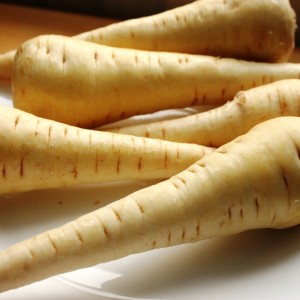
 Closely related to the carrot, this creamy coloured root (Pastinaca sativa) has been used as a vegetable since antiquity and was cultivated by the Romans. Like carrots, parsnips are valued for their natural sweetness and they are a good source of antioxidants and dietary fibre, and also high in vitamins and minerals, notably potassium.
Closely related to the carrot, this creamy coloured root (Pastinaca sativa) has been used as a vegetable since antiquity and was cultivated by the Romans. Like carrots, parsnips are valued for their natural sweetness and they are a good source of antioxidants and dietary fibre, and also high in vitamins and minerals, notably potassium.
Mainly used as a winter vegetable because the flavour improves after frost, parsnips are edible raw but are usually cooked - and famously improved by adding butter. Simply steamed or boiled parsnips are transformed by the addition of a knob of butter and they are delicious baked in buttered greaseproof paper or foil.
This versatile vegetable works well in many savoury bakes and casserole dishes and even as an ingredient in baking (see below). While somewhat out of favour in recent years, parsnips are enjoying a comeback in the rustic dishes that are currently popular and, like many other vegetables, being accorded due respect once again.
 RECIPE: Parsnip and Hazelnut Tea Loaf
RECIPE: Parsnip and Hazelnut Tea Loaf
While carrots are a familiar ingredient in baking and desserts, it is rare to find parsnips used in this way. This unusual recipe is perfect for autumn and it is from Catherine Fulvio’s new book, The Weekend Chef, Easy Food for Lazy Days (Gill & Macmillan, hardback €22.95).
With a cookery school, a farm B&B, and the needs of family, TV programmes and numerous other demands to contend with, Catherine has a pretty full on schedule to juggle - so her appealing suggestions for food that helps make weekends a time to unwind come from one who knows the importance of relaxation, and finding time for play date evenings, TV suppers and entertaining friends.
About this recipes she says “Irish carrots are especially sweet, so you could use them instead of parsnips. The banana in the recipe ensures that the loaf doesn’t dry out – it will keep for almost a week if you can resist it for that long!”
Makes 1 large loaf
for the cake:
150g light brown sugar
150ml sunflower oil
3 eggs
1 ripe medium banana, mashed
175g self-raising flour, sieved
1 tsp baking powder
1 tsp mixed spice
100g grated parsnip
75g hazelnuts, roughly chopped
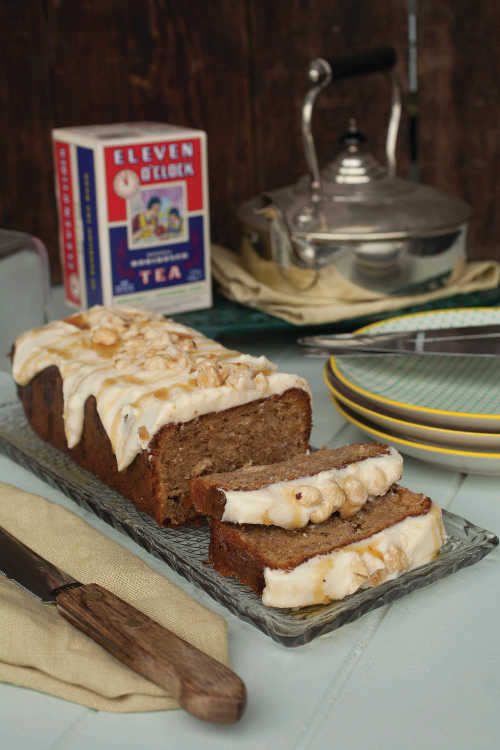 for the icing:
for the icing:
100g icing sugar, sieved
70g butter, softened
75g cream cheese
1 tbsp maple syrup
12 whole hazelnuts, toasted and roughly chopped
1 Preheat the oven to 170°C/fan 150°C/gas 3. Line a 2lb loaf tin with parchment paper.
2 Using an electric beater, mix the brown sugar, oil and eggs together until light in colour, then add the mashed banana. Fold in the flour, baking powder and mixed spice, followed by the grated parsnip and chopped hazelnuts. Pour into the prepared tin and bake for 45–50 minutes, until a skewer inserted into the centre comes out clean. Cool completely before removing from the loaf tin.
3 To make the icing, beat together the icing sugar and butter with an electric mixer until pale and fluffy. Gradually beat in the cream cheese a spoonful at a time. When the cake is cooled, spread on the icing. Drizzle over the maple syrup and sprinkle with the chopped hazelnuts.
In Season - Cranberries

 As much a part of our Christmas as the turkey or the plum pudding, cranberries are borne on evergreen dwarf shrubs or trailing vines (subgenus Oxycoccus of the genus Vaccinium).
As much a part of our Christmas as the turkey or the plum pudding, cranberries are borne on evergreen dwarf shrubs or trailing vines (subgenus Oxycoccus of the genus Vaccinium).
A major commercial crop imported from North America, they thrive in acidic bogs and the sharply flavoured red berries have antioxidant qualities which have led recently to their reputation as a ‘superfruit’.
Most of the commercial cranberry crop is water-harvested - the land is flooded and machines collect the berries off the surface of the water - for processing into juice, sauces, jams and sweetened dried cranberries, but a small proportion is hand harvested to be sold fresh.
The acid conditions of Ireland’s boglands make it possible to grow such crops in the midlands and they are a speciality of Slievebloom Farmhouse Foods (+353 (0)57 913 1372; www.slievebloomfarmhousefoods.com), near Birr in Co Offaly, where Ciara Morris makes a range of preserves, chutneys and sauces, several of which – including a mulled wine & cranberry sauce – have achieved success at The Great Taste Awards.
Since 2006 she and her business partner, local farmer/fitter Michael Camon, have owned Ireland’s only cranberry farm, which was first started by Bord Na Mona as a pilot project - and now successfully produces fresh fruit for supply to some of Ireland’s top restaurants (and retailed in Ireland for the festive season) as well as Ciara’s range of products.
Fresh cranberries are versatile and freeze very well for use throughout the year, while dried ones (which are sweetened and easily available) are especially useful in breads and baking and as an addition to salads, oatmeal toppings, granola and seed or nut snack mixes.
 RECIPE: Cranberry and White Chocolate Cookies
RECIPE: Cranberry and White Chocolate Cookies
One of Rosanne Hewitt-Cromwell’s recipes from ‘Like Mam Use To Bake’ (Mercier Press, paperback €19.99), which is based on her popular blog of the same name.
These cookies from the Christmas chapter would make an attractive small gift, but they are equally appealing all year. “I find the window of opportunity to buy fresh cranberries in December very brief,” comments Rosanne.
“Once I can stock up on enough to make some cranberry sauce for Christmas day I am usually happy. Using dried cranberries in these cookies means that they are not just for Christmas though, you can enjoy them at any time of year.”
125g unsalted butter, softened and cubed
125g caster sugar
1 large egg
1 tsp vanilla extract
150g plain flour
25g cornflour
Pinch of salt
75g white chocolate, roughly chopped, or buttons/chips
75g dried cranberries
Preheat the oven to180°C/ 350°/ Gas Mark 4. Line two baking sheets with
parchment paper.
Cream the butter and sugar together using an electric hand-held whisk/stand-alone mixer until pale and fluffy (approximately 3 minutes).
Add the egg and vanilla extract and beat through.
Sift in the flour, cornflour and salt and fold through.
Add the white chocolate and cranberries and fold through.
Wrap the dough in some cling film and shape into a 15cm/6in sausage. Chill in the fridge for an hour.
Unwrap and cut the dough in half, cut each half in half again and continue doing so until you have 16 pieces of dough. Don't worry if the dough still feels a little sticky it will roll perfectly well.
Roll each piece between your hands to form a ball and place evenly spaced onto the baking sheets. Flatten each ball slightly and bake in the preheated oven for 5 minutes or until golden brown.
Remove from the oven and allow to cool on the baking sheets for 5 minutes before transferring to a wire rack to cool completely.
In Season - Root Vegetables

 Under rated for decades, root vegetables - broadly categorised as plants with edible underground parts, but most often referring to those with tap roots and tuberous roots such as carrots, parsnips and potatoes - have been the mainstay of traditional northern European diets for many centuries.
Under rated for decades, root vegetables - broadly categorised as plants with edible underground parts, but most often referring to those with tap roots and tuberous roots such as carrots, parsnips and potatoes - have been the mainstay of traditional northern European diets for many centuries.
Easy to grow, these high-carbohydrate culinary work horses are packed with energy, have a long season and can be kept for months without refrigeration. Being of such practical trouble-free use, it’s easy to see why more delicate and demanding vegetables have tended to steal the limelight in the years when ‘food as fashion’ emerged, but they are still our best friends, wonderful comfort foods and the basis of so many of our simple and delicious traditional dishes.
Easily available ‘true roots’ include tap roots like beets, turnips and radish, as well as the increasingly popular celeriac and the rarer but delicately delicious salsify - which is well worth seeking out - and tuberous roots which include Jerusalem artichokes as well as potatoes.
Bulbs - onions, shallots, garlic - also count as root vegetables since they grow underground, as do some of our more exotic rhizome kitchen staples, like ginger, turmeric and arrowroot.
Considering this wide range - and there are many more, less well known - the potential for these wholesome and often colourful foods is huge. They are also cheap to buy and easy to cook, making a great foundation for wholesome budget meals.
It’s good to see root vegetables returning to favour in restaurant kitchens - albeit mostly in unfamiliar (‘baby’ and ‘heritage’) forms, and we should be making the most of them at home too.
 RECIPE: Roasted Vegetable Mix with Maple Syrup
RECIPE: Roasted Vegetable Mix with Maple Syrup
This variation on a popular way with root vegetables is from Calso Cooks: Real Food Made Easy (Mercier Press, paperback, €19.99) by West of Ireland food blogger, Paul Callaghan.
Food as therapy is a strong thread of the theme here, as the Armagh native explains how he moved to Co Clare after losing his business in the recession and, having found a house to rent with a large garden, discovered that growing and cooking his own food gave him a reason to get up in the morning - and soon became a serious source of delight to family and friends. The design and production style is all bit home-made, but that is part of the charm.
“I’m a huge fan of roasted veg. It only takes a little bit of time to prepare and minimal looking after. This selection is my usual handy roast dinner accompaniments but there is no end to the selections you can have.”
Feeds 4
Ingredients
3 carrots
3 parsnips
2 courgettes
2 red onions
1 red pepper
1 yellow pepper
1 green pepper
5 cloves of garlic
olive oil
Sea salt and black pepper to season
2 tablespoons maple syrup
Method
1. Preheat the oven to 200’F
2. Peel the carrots and parsnips and cut into batons. Wash the courgettes and cut into batons also. Peel the onions and cut into wedges. De-seed and slice the peppers. Bash the cloves of garlic with the flat of a knife.
3. Pour all the prepared ingredients into a roasting tray. Drizzle with oil and give a generous amount of seasoning. Place in oven for 30 minutes.
4. Remove from the oven and drizzle the maple syrup over the vegetable mix and give it a good toss around. Then pop it back into the oven for 10 minutes.
5. Serve hot and remove the garlic cloves if desired.
6. TIP: If you are feeling adventurous, then feel free to add flavouring to this dish - some herbs like rosemary, thyme, sage…spices like fennel, cumin or caraway seeds - wholegrain mustard, balsamic vinegar, soy sauce…basically whatever you like!
[Ed’s note: You might also try replacing the imports like olive oil and maple syrup with Irish products such as rapeseed oil and Highbank apple syrup. GC]
In Season - Citrus Fruits
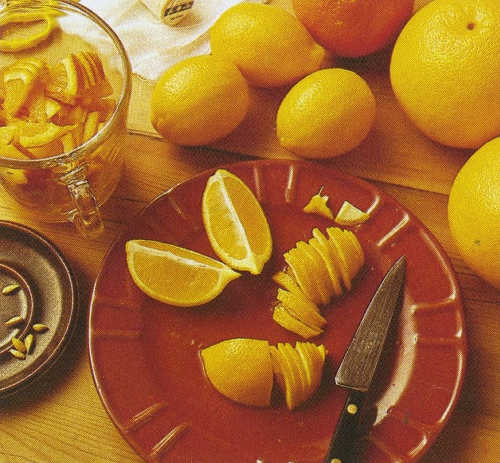
 Cultivated since ancient times, the best-known citrus fruits are the oranges, lemons, grapefruit, limes and tangerines. Citrus plants hybridise easily and kumquats are among the many related fruits. The trees and shrubby plants are sensitive to cold but can be grown here fairly successfully in tubs if they are given protection in winter.
Cultivated since ancient times, the best-known citrus fruits are the oranges, lemons, grapefruit, limes and tangerines. Citrus plants hybridise easily and kumquats are among the many related fruits. The trees and shrubby plants are sensitive to cold but can be grown here fairly successfully in tubs if they are given protection in winter.
An attractive addition to a porch or conservatory, the spiky evergreen plants reward a little care; the flowers are sweetly scented and are produced continuously, so there may be fruit and flowers at the same time. Fruit fresh from the tree has a delicious flavour unlikely to be found in imported fruit.
Now that most foods are available at any time of year, it is difficult to recall the excitement the beginning of a new season used to generate. But - although most citrus fruits are available from different regions throughout the year - the season for Seville oranges and their other bitter relations is still very short.
They start to come in about mid January and they'll only be in the shops for a few weeks, so pick them up at one if you see them. Interestingly, although the more common sweet orange was a much later arrival in Europe, the bitter orange - of which the best-known variety, the Seville, comes from Spain - was known to the Greeks and Romans.
As far as we know they did not make marmalade with them however - that didn't come along until about 1700, in (of course) Dundee. Do try making your own marmalade: once you do, you'll be hooked for life - the fresh tangy flavour of home-made marmalade is unbeatable and it isn't hard to make either.
Even if you haven't time to make marmalade now, get the oranges as they freeze well - just make sure that you choose a recipe which involves cooking the oranges whole and freeze them in weighed batches. Adding an extra orange or two per batch will allow for any loss of pectin during storage - or make a mixed fruit marmalade, including sweet orange, grapefruit and/or limes, if you leave them longer than anticipated.
Cold and grey as it may be outside, the aroma of marmalade through the house has a wonderful way of evoking the warmth and colour our citrus fruits have left behind.
Points for success:
- Cooking citrus fruit takes much longer than other fruits because of the thickness of the peel, so much more water is needed to allow for evaporation. By the end of the first cooking stage, the contents of the pan should be reduced by half and the peel must be very soft - once the sugar is added, the peel will not soften any more.
- Pectin and acid content is important to obtain a good set in all jam and marmalade making; lemon juice is added to seville orange marmalade to supply the extra acid needed to get a good set and prevent crystallisation.
- When the sugar is added it must be dissolved over low heat before bringing the temperature up top the boil. Once dissolved, a fast rolling boil is needed to bring the marmalade up to boiling point. To allow for safe fast boiling, the reduced pulp should not come more than halfway up the pan. If you don't have a big heavy-based pan suitable for preserves, why not consider sharing one with friends? Alternatively, you can hire preserving pans or big heavy-duty Castle Brand saucepans. (Try Kitchen Complements, Dublin, 2. South Anne Street, Tel:01:770734)
-The longer you boil, the darker the colour and more 'mature' the flavour, but over-boiling produces a half-set, syrupy preserve. If your marmalade has reached setting point and you prefer it darker, add a spoonful or two of treacle instead of boiling longer.
- Setting point is reached when a sugar thermometer reaches 221'F, 105'C, or when a little jam cooled on a cold saucer wrinkles when pushed with a finger or spoon.
- To keep well, the marmalade must be poured into jars which are clean, dry and warm, then leave until completely cold before covering. Store in a cool, dark place.
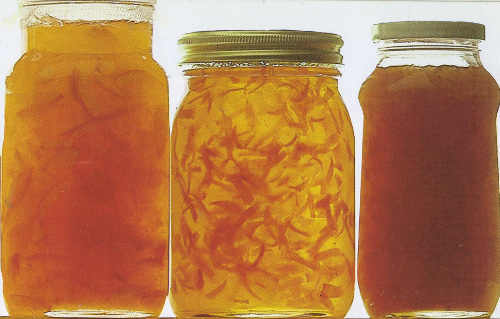 RECIPE: Mixed Fruit Marmalade is good at any time, and especially useful when Seville or bitter oranges are in short supply, as the proportion is smaller but the flavour still good.
RECIPE: Mixed Fruit Marmalade is good at any time, and especially useful when Seville or bitter oranges are in short supply, as the proportion is smaller but the flavour still good.
This recipe is from my book, Meals For All Seasons (1992). Makes 8-10 lb/3.6-4.5 Kg
llb/450g bitter oranges
l lb/450g sweet oranges
2 large lemons
1 grapefruit
6 pints water
About 6 lb/2.7 Kg granulated sugar
Scrub the fruit and pick off the discs at the stalk end. Halve fruit and squeeze the juice; reserve.
Quarter the peels and remove any excess pith. Tie the pith and pips loosely in a square of muslin.
Slice the peels as thickly or thinly as you like them, or chop in a liquidiser or food processor - in which case include a little of the measured water with each batch as it is processed.
Put the prepared peel, water and fruit juices into the preserving pan; tie the muslin bag of pips and pith to the pan handle and bring the mixture to the boil.
Cover loosely and simmer for 1.5-2 hours, or until the peel is really tender. Remove the pan from the heat, remove the muslin bag and press between two plates to squeeze out all the juice, then discard the bag.
Measure fruit and juice and add l lb/450g sugar per l pint/600 ml of juice and pulp.
Bring up to the boil and boil hard for 15-20 minutes, until setting point is reached.
Skim, if necessary, or stir in a knob of butter to disperse any small amount of scum.
Cool for 15 minutes then stir to distribute the peel evenly before potting.
In Season - Seed Potatoes
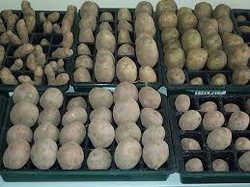
 No, we’re not suggesting that you should be eating seed potatoes, but it’s the ideal time to plant them (see Michael Kelly’s GIY column) and it’s worth thinking carefully about the best variety before you put the work in. You might consider a heritage variety, for example, as some of them are not only particularly well suited to the Irish climate, but also have natural blight resistance.
No, we’re not suggesting that you should be eating seed potatoes, but it’s the ideal time to plant them (see Michael Kelly’s GIY column) and it’s worth thinking carefully about the best variety before you put the work in. You might consider a heritage variety, for example, as some of them are not only particularly well suited to the Irish climate, but also have natural blight resistance.
The Heritage Irish Potato Collection is one of the 2014 Irish Food Writers’ Good Food Awards winners, honouring David Langford and Dermot Carey and supporting them in their aim to find a permanent home for a collection that has been growing since the 1970s when David began collecting and growing heritage potatoes. In 2006 he teamed up with Dermot Carey, an experienced organic vegetable-grower who was then gardener at Lissadell House in Co. Sligo.
The horticultural skills, passion, and hard work of David and Dermot has resulted in an amazing collection, grown and managed by them on an entirely voluntary basis. The collection has well over two hundred varieties including the Irish Apple (dating from 1768), and the Lumper (forever associated with Irish Potato Famines) as well as more recently developed varieties. This valuable collection is in urgent need of permanent home where all these varieties can be maintained as part of our Irish food culture and heritage for the generations to come.
Meanwhile, gardeners and cooks interested in heritage potatoes for their own plots can get more information and seed potatoes from the Irish Seed Savers Association (www.irishseedsavers.ie) where over 50 varieties are available.
RECIPE: created for the Irish Food Writers’ Guild Food Awards 2014 by chefs Derry Clarke and Michael Hunter of l’Ecrivain Restaurant, Baggot Street, Dublin 2.
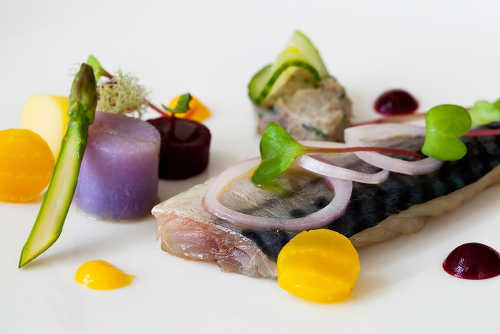 Cured & smoked Irish mackerel, Irish Heritage potato salad, pickle, beetroot
Cured & smoked Irish mackerel, Irish Heritage potato salad, pickle, beetroot
Serves 4
In this recipe Derry Clarke pairs one of Ireland’s most delicious and sustainable fish, sourced from one of over 100 members of Responsible Irish Fish, with indigenous spuds from the Irish Heritage Potato collection.
for the cured mackerel
4 mackerel fillets, all bones removed
100g Irish Atlantic Paprika Sea Salt
100g white sugar
1 large bunch fresh dill, chopped
for the smoked mackerel pâté
4 mackerel fillets, all bones removed
200g wood chips
100g cinnamon sticks
50g star anise
2 tbsp fresh rosemary and thyme, chopped
2 tbsp mayonnaise or crème fraîche
1 tbsp grated fresh horseradish
1 tbsp chopped fresh chives
a squeeze of fresh lemon juice
for the pickle
100ml white wine vinegar
1 tbsp fennel seeds
150g sugar
1 cucumber, thinly sliced
2 shallots, peeled and sliced
for the potato salad
200g cooked Irish Heritage potatoes, peeled and diced
50ml olive oil
1 shallot, peeled and diced
1 tbsp chopped chives
Irish Atlantic Smoked Sea Salt
To cure the mackerel, mix the salt, sugar and dill together and spread over the flesh of the mackerel, cover and refrigerate overnight. Remove from the fridge, scrape off the curing mix and rub the mackerel with rapeseed oil.
To make the smoked mackerel patéyou will need to smoke the mackerel fillets. Begin by placing the wood chips into the bottom of a deep roasting tin, add the cinnamon sticks, star anise and rosemary and thyme.
Cover with an oiled wired rack and place the four mackerel fillets on top, skin-side-up. Tightly cover the tin with tinfoil and place it over a low heat for 15 minutes (this is best done outside your house on a barbecue). Once smoked, remove cover and leave to cool.
To make the mackerel pâté, flake the mackerel flesh into a bowl, add the remaining ingredients and mix well until you have a nice paté texture.
To make the pickle, boil the vinegar, sugar and fennel seeds for three to four minutes in a small pot, season, allow to cool, and then add the sliced cucumber and shallot.
To make the potato salad, gently mix all ingredients together.
To serve, arrange the cured mackerel at the centre of the plate with a quenelle of smoked mackerel paté and a spoonful of potato salad to the side.
In Season - Wild Garlic
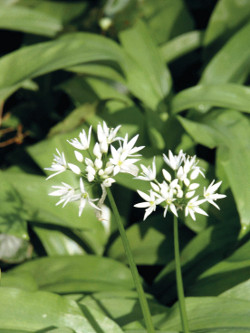
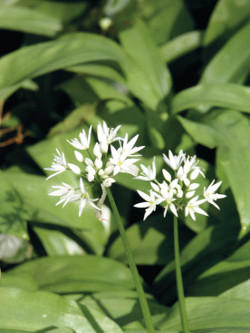 Popular in many Irish kitchens and also known colloquially as ‘ramsons’, this attractive bulbous perennial (Allium ursmum) is a member of the onion/garlic family that grows prolifically in woodland and along hedgerows in spring, often carpeting the ground and reaching a height of about 50cm/20in high.
Popular in many Irish kitchens and also known colloquially as ‘ramsons’, this attractive bulbous perennial (Allium ursmum) is a member of the onion/garlic family that grows prolifically in woodland and along hedgerows in spring, often carpeting the ground and reaching a height of about 50cm/20in high.
Both the long spear-shaped leaves and the white star-shaped flowers (April-May, or earlier in some years) are edible and feature on many a fashionable menu - fresh when in season, and preserved all year.
Thanks to its pungent smell and abundance, wild garlic is one of the easiest wild foods to harvest, and one of the simplest to use; the flavour is less overpowering than the pungent aroma suggests, and it can be used in salads, notably the young leaves can be chopped and used as a substitute for chives. Like other members of the onion and garlic family, wild garlic leaves have a useful affinity with tomatoes - perhaps better even than the ubiquitous and strongly flavoured basil.
While this free food is a wonderful countryside resource in spring, gardeners need to be wary of wild garlic - ‘prolific’ and ‘carpeting’ are the danger words, and it can become a serious weed in a small garden where it may arrive uninvited. Although you may at first be delighted to have it, the tiny bulbils spread like wildfire and it can very quickly become a problem.
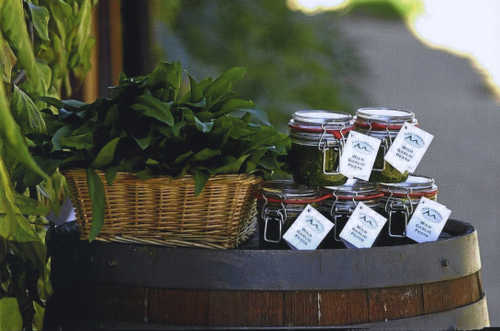 RECIPE: Wild Garlic Pesto - a Strawberry Tree Restaurant recipe from Wild Food, Nature’s Harvest: How to Gather, Cook & Preserve by Biddy White Lennon & Evan Doyle (O’Brien Press, €16.99). Allotting 10 pages of this book to Wild Garlic is a measure of its popularity and, among other useful information, there is also a great Wild Garlic, Leek & Potato Bake and a recipe for Wild Garlic Preserved in Oil.
RECIPE: Wild Garlic Pesto - a Strawberry Tree Restaurant recipe from Wild Food, Nature’s Harvest: How to Gather, Cook & Preserve by Biddy White Lennon & Evan Doyle (O’Brien Press, €16.99). Allotting 10 pages of this book to Wild Garlic is a measure of its popularity and, among other useful information, there is also a great Wild Garlic, Leek & Potato Bake and a recipe for Wild Garlic Preserved in Oil.
WHAT GOES IN
50g fresh wild garlic leaves
25g pine, cashew, hazel or chestnuts…your choice!
200ml organic olive oil or better still- Irish organic rapeseed oil
40g Parmigiano-Reggiano or really mature Desmond, grated
Organic black pepper and sea salt.
HOW IT GOES
Simple recipes are not always the easiest. It took us years to get this just right. Any of the above nuts, oils or cheeses will make a fabulous fresh spring-tasting pesto ... we're just not saying which go into our Strawberry Tree wild garlic pesto!
So, the easy way is to blitz the nuts and half the oil in a food processor and add in the grated cheese. Then add the wild garlic and blitz with the remaining oil to the right consistency. Then simply season, to your taste. As a fresh oil dressing, it'll work, every time
HOW TO FINISH
Pour into sterilised Kilner jars and keep in the fridge or a really cool, dark pantry. More so than with basil pesto, there is a reaction between the wild garlic, oil and metal lids ...hence the Kilner.
WHAT YOU GET
This Is a serious pesto; a deep dark green pesto with attitude, a pesto that will slap you in the face with the unmistakably strong taste of wild natural garlic and its lush woodland dwellings. What you also get is 'bottled spring and summer' ... to give as a present to your friends, if you are able!
If not, use it to impress as a dressing over salads, bake into your favourite bread dough, add to any pasta dish or mix with butter and slip under the skin of a chicken roast... the list goes on, just use your imagination and go wild!
In Season - Spring Cabbage
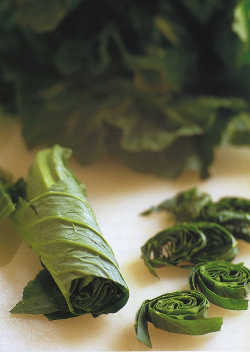
 One of the new the season’s first crops, spring cabbage was a favourite vegetable before the days of all-year everything as it was such a welcome change after the heavy winter vegetables. It may not be as popular as it used to be, but it certainly deserves a special place in the kitchen as it’s a versatile and healthy vegetable and - being rich in vitamin C, folic acid and dietary fibre - just what’s needed to boost the system as we go into summer.
One of the new the season’s first crops, spring cabbage was a favourite vegetable before the days of all-year everything as it was such a welcome change after the heavy winter vegetables. It may not be as popular as it used to be, but it certainly deserves a special place in the kitchen as it’s a versatile and healthy vegetable and - being rich in vitamin C, folic acid and dietary fibre - just what’s needed to boost the system as we go into summer.
The special features of this leafy brassica are that central leaves form only a loose pointed head, or none at all, and it’s often known simply as ‘spring greens’, a term also used more broadly to include thinnings and trimmings leaves from other types of brassica, including curly kale, cauliflower, broccoli and brussels sprouts.
The loose formation and exposure to light produces dark green leaves and, although they can be strongly flavoured, they are easy to cook and work well with a surprising number of other foods.
If you have an allotment or a large garden, they’re well worth growing in the space left after early potatoes have been lifted and will give fresh greens throughout the ‘hungry gap, from early April to June when summer vegetables come on stream.
Cooking spring greens is easy. Simply slice the leaves and steam or cook quickly in a little boiling water, then drain well and finish with pepper and a knob of butter, or add as the last ingredient in a stirfry. They are lovely with the addition of some gently fried onion and bacon, and mix well with other vegetables.
Leafy greens complement a wide range of foods, including robustly flavoured fish like salmon, the only rule is that they must be cooked quickly and not overcooked.
RECIPE SUGGESTION from River Cottage Everyday by Hugh Fearnely-Whittingstall (Bloomsbury):
“I've never had much trouble eating my greens and I hope these recipes will ensure you don't either. The golden rule with almost any brassica or beet leaf, whether it's the leaf or stem, or unformed flower (as with broccoli and caulis) is to keep the cooking time short.
Stick to this, and pair your lightly done greens with a smidgeon of something rich and lubricating, and/or textured and savoury - most obviously a knob of butter (garlicky, if you like), but also a little crisp bacon, a just-cooked egg, a few toasted seeds... you get the idea.”
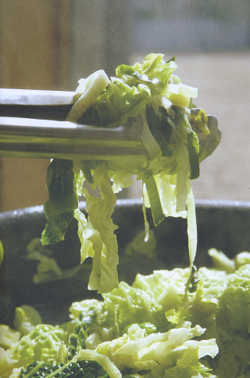 Leeks with greens
Leeks with greens
Soft, buttery, wilted leeks bring a lovely sweetness to any kind of lightly cooked cabbage or greens. This simple preparation is one I turn to frequently, both at home and when cooking at River Cottage: it's so easy to throw together, can be made with different seasonal greens throughout most of the year and works as a side dish to everything from a bit of grilled fish to a full-on Sunday roast.
Serves 4
About 500g leeks
A knob of unsalted butter
1 Savoy or other green cabbage, 2 heads of spring greens, or a few bunches of curly kale
Sea salt and freshly
ground black pepper
Trim the leeks, slice them finely (maximum 5mm) and give them a good rinse to get rid of any grit. Heat the butter in a large frying pan or wide saucepan and add the leeks with a pinch of salt. Let them cook gently for 5-6 minutes, stirring or shaking the pan occasionally, until wilted and tender.
Meanwhile, trim and coarsely shred the cabbage, greens or kale. Cook lightly - in either a steamer or a large saucepan of salted water - for 3-4 minutes, until wilted and tender but not too soft. Remove from the heat immediately, drain well and let the excess moisturesteam off for a minute or so.
Then add to the pan of buttery leeks,along with some more seasoning, and stir over a low heat for about a minute until thoroughly combined. Serve straight away.
In theory you can use any leftovers for bubble and squeak... but in practice there rarely are any.
In Season - Radishes
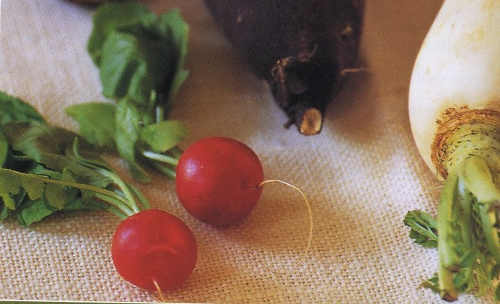
 Although there are other edible members of the ancient radish family, Raphanus sativus - which includes white radish (daikon or mooli, used widely in Japan) and black radish - it is the jaunty little red globe that’s in season now that we all know and love, and that we are most likely to see on sale or harvest from our gardens this month.
Although there are other edible members of the ancient radish family, Raphanus sativus - which includes white radish (daikon or mooli, used widely in Japan) and black radish - it is the jaunty little red globe that’s in season now that we all know and love, and that we are most likely to see on sale or harvest from our gardens this month.
Quick growing and appealing, it’s long been a popular beginner vegetable for children to grow, although they may prefer the milder flavour of the longer variety with white tips, the French breakfast radish - which is probably the one experienced by a young Darina Allen in France, described below.
Related to horseradish, turnip and mustard and recognised for its diuretic and cleansing properties since earliest times, the radish is high in vitamin C and, like other cruciferous plants (including broccoli and cabbage), is linked with anti-cancer properties.
The bright colour, easy preparation and punchy flavour of radishes make them an appealing quick addition to brighten a salad, and they’re the perfect crunchy appetite stimulant to serves with aperitifs.
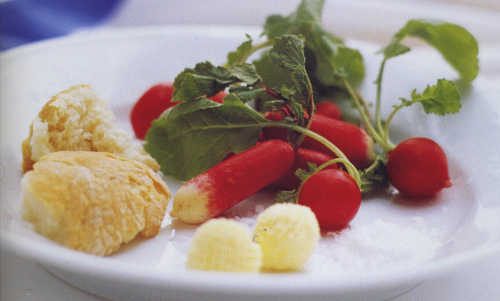 RECIPE: Radishes with Butter, Crusty Bread and Sea Salt
RECIPE: Radishes with Butter, Crusty Bread and Sea Salt
Fresh back from the Ballymaloe LitFest, and with the new edition of Myrtle Allen’s classic, The Ballymaloe Cookbook, to savour, I started browsing through the shelf of older Ballymaloe books including Darina’s A Year At Ballymaloe Cookery School and found this delightful little recipe.
This book was published in 1997 and, even in relation to such a simple recipe, so much has changed since then. The local butter mentioned is no longer available - but Ballymaloe now have their own beautiful butter, made for the house by Tim Allen using the organic milk from their Jersey cows.
The dominant sea salt at the time was Maldon (which is still an excellent product) but we now have three Irish-made sea salt to choose from, including one from West Cork (Irish Atlantic Sea Salt) and Achill Island Sea Salt (see Special Irish Foods and the People Who Make Them) which won a 2014 Euro-Toques Food Award, and both are on sale at Ballymaloe Cookery School.
The crusty bread is probably homemade as usual - or, perhaps, supplied by Declan Ryan’s Arbutus Artisan Bread which was a great hit in The Big Shed at the LitFest - and the one reliable is the cheery little radish, every cook/gardener’s staple to boost early summer salads.
“When I was just nineteen, an au pair, alone and frightened in Besancon, a French girl took pity on me and invited me to have lunch with her in a café. We had a plate of charcuterie and radishes. I watched in fascination as she smeared a little unsalted butter on her radishes, dipped them in sea salt and ate them greedily. I followed suit - and I've never forgotten the flavour. We use Bill Hogan's fine unsalted butter churned from morning cream whenever we can get it.”
Fresh radishes complete with leaves
Finest unsalted butter
Sea salt (se use Maldon flakes)
Crusty bread
Wash the radishes and trim the tail and the top of the leaves if they are long.
Cut a chunk of butter into 1cm (1/2 in) cubes. If you have a pair of butter pats, soak them in cold water and then roll each cube into a ball, and drop then into a bowl of iced water.
To serve: put 7 or 8 chilled radishes on each plate, add 2 or 3 butter balls and a little mound of sea salt.
Serve fresh crusty bread as an accompaniment.
In Season - Elderflower Cordial
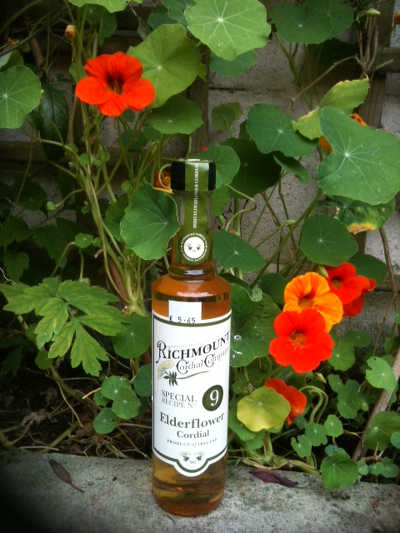
 Georgina Campbell
Georgina Campbell
For years I’ve been banging on about the shortage of good Irish-made non-alcoholic drinks - and, specifically, a quality commercially produced elderflower cordial that would be available all year round like the imported ones.
Many people have been making seasonal batches in recent weeks but, while it’s a joy to find home made elderflower in restaurants and country houses around the country in summer, it’s never made in very big quantities - and this is a versatile drink that should be on every drinks list, all year round.
Topped up with copious amounts of water or sparkling water, elderflower cordial makes a wonderfully refreshing long drink and is just about the only one that a non-drinker won’t find cloying when drinking it in the same way as white wine - as an aperitif, with food, or throughout a party or an evening at the pub.
So, when I found the Richmount Cordial Company’s Elderflower Cordial at the Sheridans Irish Food Festival in Carnaross this May, it was the highlight of my day.
It's made by David and Martina Burns of Carrickboy, Co. Longford, who are well known for their innovative approach to farming and food production. They won a Euro-Toques award for their sweet corn a couple of years ago, so maybe it should be no surprise that they're now into another unusual venture.
A former dairy farmer, David discontinued milking because he didn’t have the acreage to expand his herd to the necessary size, and turned his hand to other farming enterprises.
However Martina, a former teacher, was a dab hand at making elderflower cordial and, following encouragement from chefs and friends who tasted it, they decided to go into commercial production in 2013.
They planted a large number of elder saplings to augment the wild elderflowers freely available in surrounding hedgerows - and are helped by local people, who are given very specific picking instructions and paid €3 per kilo. In the height of the elderflower season, in June, it’s a race against time to get the fresh flowers harvested in peak condition on dry days.
The cordial is made from an infusion of flowers in a sugar and lemon syrup, which is then filtered, bottled, pasteurised and packaged for distribution. Just like homemade cordial, the colour varies according to the time of picking - flowers picked early in the season produce a paler cordial than later ones. It is a simple, traditional process, using fresh natural ingredients and ‘no concentrate or artificial sweeteners, flavourings, additives, colourings, or sulphites’.
David and Martina are very health conscious and aware of the need to control sugar intake but, as only a small splash of elderflower cordial is needed to turn a large glass of water into a delicious drink, that should not be a problem. And it is certainly an appealing alternative to alcohol.
You will find Richmount Elderflower Cordial at many of the country’s best speciality food stores and there is a list of stockists on their website (www.richmountcordials.ie)
 RECIPE: Elderflower & Lemon Drizzle Cake
RECIPE: Elderflower & Lemon Drizzle Cake
Elderflower cordial is also a versatile flavouring for use in cooking, adding a light fragrance to syrups for fruit salads and other desserts, and a taste of summer to baking - as this pretty cake from the centeranian baking supplies company Dr Oetker shows.
175 g plain flour
2 tsp dr. oetker baking powder
175 g butter, softened
175 g caster sugar
3 medium eggs, lightly beaten
1 tblsp dr. oetker select vanilla extract
dr. oetker orange & lemon slices, to decorate
For the cream filling
350 ml double cream
3 tblsp elderflower cordial
1 tsp dr. oetker natural lemon extract
2 tblsp icing sugar
For the drizzle
225 g icing sugar, sifted
3 tblsp elderflower cordial
Method
Heat the oven to Mark 5/190°C. Grease and base-line three 18cm sandwich tins.
Sift the flour and baking powder into a bowl.
In a separate bowl, cream the butter and sugar using an electric whisk.
Gradually beat in the eggs and vanilla extract to the creamed butter and sugar, then fold in the flour.
Divide between the three tins and bake for 15-20 minutes until risen, golden and firm to the touch.
Leave to cool in the tins before transferring to a wire rack to cool completely.
For the cream filling, whisk all the ingredients until thick (don’t over-whip). For the drizzle, stir the sugar and cordial together until smooth.
Sandwich the cake together with the cream, pour over the drizzle and decorate with lemon slices.
In Season - Globe Artichokes
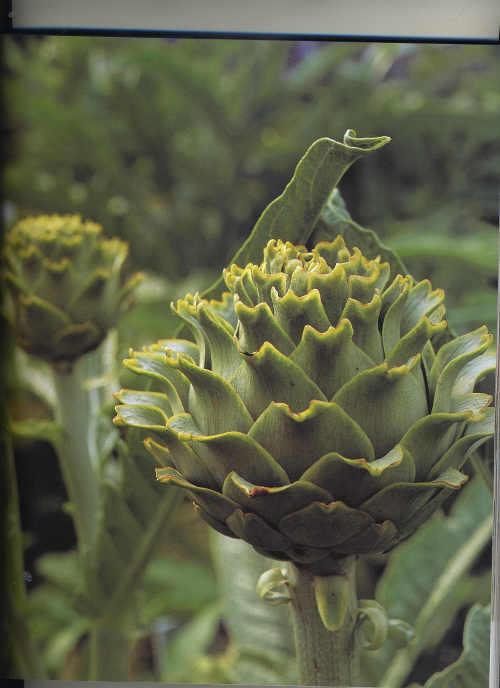
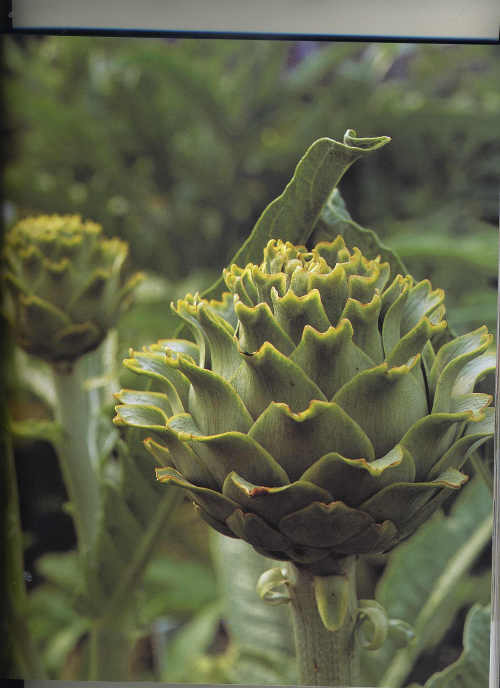 Georgina Campbell
Georgina Campbell
On our travels this summer I’ve been surprised to see that wintry favourite, Jerusalem artichoke, on a number of menus where seasonality is usually observed.
Perhaps chefs are somehow confusing them with the splendid globe artichoke (Cynara scolymus) the handsome architectural member of the thistle family that is a cultivated form of the cardoon, and in season now.
Although mainly grown for the large edible flower buds, it is very worthwhile to allow some buds to mature if they are growing abundantly as the beautiful thistle-like purple flowers are quite spectacular, both as a garden feature and for cutting.
They can be grown in all areas if the variety is carefully chosen (‘Vert de Laon’ is hardy) but really thrive in the milder south-western counties of Ireland and Britain and my father always had an abundance of them for both the table and the house in his lovely Cornish garden.
Even if grown from seed they should flower in the first season, and will grow larger and more prolific for several years if well fed and protected from frost if necessary, although they do need to be divided and replanted to maintain a vigorous stock.
The easiest way to cook and serve globe artichokes is to trim the stem and then to boil or steam the whole immature flower heads until the scales pull away easily from the base.
Served whole but with the ‘choke’ - which is the immature flower - removed, you simply pull out the individual ‘petals’ and dip them into a sauce of melted butter, vinaigrette or Hollandaise, then suck the delicious juicy flesh from the base of each one; finally cut out the hearts (also known as ‘fonds d’artichaut’) and enjoy them with any remaining sauce and some crusty bread. It’s a lovely sociable summery ceremony, with lots of fingers licking and all the ‘petals’ ending up in a big bowl on the table.
There are of course many other ways to serve this versatile delicacy, including Globe Artichoke Hearts Braised in Olive Oil, a more refined recipe from Darina Allen’s book A Year At Ballymaloe Cookery School (1997; Kyle Cathie paperback edition 2007).
“Ireland has a great climate for globe artichokes. Fields of them make one of the more bizarre sights which greet tourists on the Beara peninsula. Our variety has been handed down through generations of Myrtle Allen's family. We mostly eat them whole, dripping with melted butter or Hollandaise. We grow so many that by the time August comes we get more flahulach with them and just eat the hearts.”
SERVES 4
900 ml (11/2 pints) water
1 lemon
6 globe artichokes
1 onion, coarsely diced
6 tablespoons extra virgin olive oil
2 cloves garlic, chopped
4 tablespoons coarsely chopped parsley
Salt and freshly ground black pepper
Preparing the artichokes is the fiddliest part of this recipe. Acidulate the water with the juice of the lemon. Drop in the squeezed lemon halves too.
Cut a ring around the stalk where it meets the base of the artichoke. Break off the stalk and the toughest fibres will come with it. Then, with a sharp knife, starting from the base, ruthlessly cut off all the leaves and trim the top down as far as the heart.
Scrape out the hairy choke, either with the tip of a knife or a sharp-edged spoon. Work quickly and drop the trimmed hearts into the acidulated water immediately, or they will discolour.
Chop the onion into large dice. Heat the oil in a wide sauté pan, add the chopped onion and garlic and sweat for a few minutes. Cut the artichoke hearts into quarters or eighths, add to the pan with the chopped parsley.
Season with salt and freshly ground pepper and toss well. Add 60ml (21/2 fl oz) water, cover and cook for 10-15 minutes, until the artichokes are tender. Serve hot or at room temperature.
Wild Strawberries - In Season
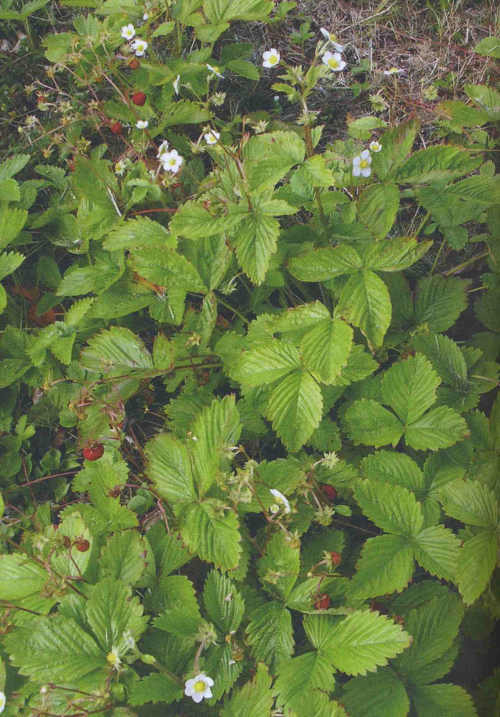
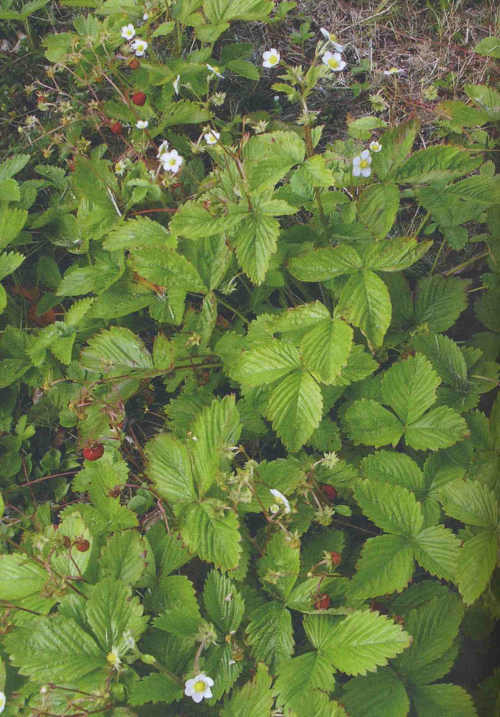 Georgina Campbell
Georgina Campbell
Wild strawberries, Fragaria Vssca, the woodland strawberry or fraises des boi,s grow abundantly all over the northern hemisphere and their small, but sweet and intensely aromatically flavoured, fruits are produced generously over a long season - it will surprise many who think of strawberries as a fruit of high summer, that they continue to fruit well into autumn (in season from June to late September).
They may well pop up in your garden, where they will settle and reproduce in the same way as cultivated strawberries, by runners thrown out in late season, which root where they land on soil.
‘Wild’, or Alpine, strawberries are also bred for cultivation, and will have slightly larger fruits and similar although less intense flavour, but they have less staying power than their wild cousins and sometimes die off and need to be replaced.
 RECIPE: Wild Strawberry, Bilberry, Blackberry And Rose Water Jelly
RECIPE: Wild Strawberry, Bilberry, Blackberry And Rose Water Jelly
From “Wild Food, Nature’s Harvest: How to Gather, Cook & Preserve” by Biddy White Lennon & Evan Doyle (O’Brien Press €16.99)
What Goes In
1 handful wild strawberries
2 handfuls wild bilberries
2 handfuls wild blackberries
750ml water
400g organic sugar
½ vanilla pod
5 leaves of gelatine
4–5 drops of rose water
250ml organic sparkling white wine
How It Goes
Place the water and sugar into a saucepan with the half vanilla pod, split. Bring slowly to boil to dissolve the sugar. Soak the gelatine leaves in a bowl of cold of water. Add gelatine into hot liquid and stir until you are sure gelatine is fully dissolved through the liquid. Whisk rose water drops into the liquid and add the white wine.
Use a large mould, just as your grandmother did, for placing in the centre of the table. Or, use individual dariole moulds or coffee cups or whatever shape you like.
Place a layer of the wild strawberries in the bottom of mould and just cover with the jelly liquid. Allow this layer to set in fridge.
Keep the remainder of the liquid jelly warm. When set, add another layer of berries. This time using all three types of berries (wild strawberries, wild bilberries and wild blackberries).
Repeat layering process until mould is full.
How To Finish
Allow to set in fridge. To turn out, dip jelly mould into hot water for a few seconds and turn out onto serving dish.
What You Get
Is an adult jelly of summer fruits that will transport you back! This jelly pays homage to the illusive and hard to harvest wild strawberry. That’s why it has pride of place for the first spoon at the top of the mould when it is inverted. We feel that the rose water adds to the deep perfume taste of this fabulous wild fruit.
Plums & Damsons - In Season
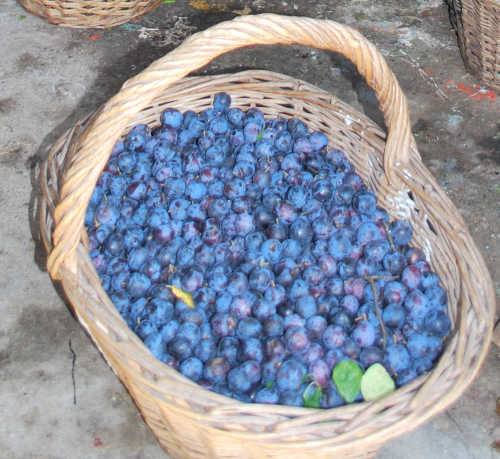
 Everywhere we’ve travelled in recent weeks the cooks of Ireland have been hard at working preserving this year’s heavy crops of fruit and, especially, plums and damsons, or prunus domestica.
Everywhere we’ve travelled in recent weeks the cooks of Ireland have been hard at working preserving this year’s heavy crops of fruit and, especially, plums and damsons, or prunus domestica.
Plums, bullace, damson - as Biddy White Lennon points out in Wild Food (O’Brien Press), there are plenty of variations to argue about but they all seem to be related to the wild cherry and all are plump, juicy stone fruit ranging in colour from yellow right through to the deep purplish blue-black of the wild damson.
The damson trees thrive in hedgerows and odd corners of land, and the fruit - which can be shaken onto a cloth spread under the tree when ripe, in August-September - makes delicious jams, jellies, fruit cheeses and relishes for cheese and cold meats.
When making plum jam it is usual to remove the stones (a tedious task) but that’s not a practical proposition for the smaller damson. Luckily, most of the stones can be skimmed off when they rise to the surface during cooking, and the flavour is so good that it’s easy to forgive the ones that remain.
If you’re fussy about stones, make a jelly instead; straining the juice takes more time but it’s easy to do; the old fashioned method is to strain it overnight through muslin tied to an upturned stool so it can drip into a bowl- what could be simpler?
When it has stopped dripping, measure the juice and allow 1lb/450g sugar per 1pint/600ml before finishing as for jam.
Damson Jam
2kg (41b) damsons
2.5kg (51b) sugar
600ml (1 pint) water
Yield: 8 jars
Pick over the damsons and discard any that are damaged. Put them into a preserving pan (or a large heavy based saucepan) with the water and simmer gently for about half an hour, until the fruit is soft and pulpy.
As soon as the stones float free, begin taking them out. Add the warmed sugar and stir until dissolved, then boil rapidly, stirring occasionally to prevent burning, until a set is obtained.
Skim, although not much skimming should be necessary if a small nut of butter is added to prevent a scum forming.
Pot up into clean, warm jars and cover while still very hot or when absolutely cold, and label
TIPS
• Cook the fruit gently and make sure it is tender before adding the sugar - the skins will be tough if sugar is added too soon.
• The sugar will melt more quickly if it is warmed before adding.
• Warm through over gentle heat after adding the sugar, which must be completely dissolved before raising the heat and boiling for a set.
• Covering the jam when it is warm encourages mould. Cover only when very hot or fully cold. Stored in a cool dark place it should keep for years.
Irish Nuts - In Season
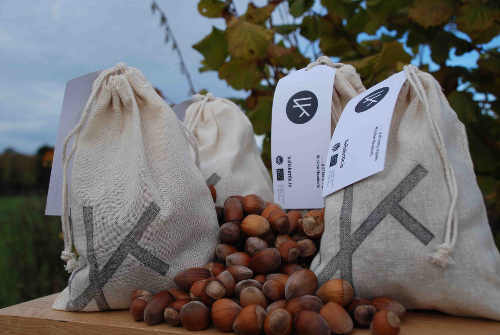
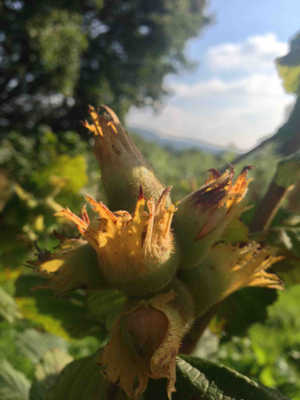 Although collecting wild hazelnuts from hedgerows was a common activity in Ireland until recently (and has perhaps seen a resurgence due to the current popularity of all kinds of foraging), commercial nut growing has never been a significant aspect of Irish food production. Happily there are experts out there who see this as a missed opportunity and it looks as if things are on the change.
Although collecting wild hazelnuts from hedgerows was a common activity in Ireland until recently (and has perhaps seen a resurgence due to the current popularity of all kinds of foraging), commercial nut growing has never been a significant aspect of Irish food production. Happily there are experts out there who see this as a missed opportunity and it looks as if things are on the change.
The Irish Nut Growers Association, for example, is dedicated to promoting nut growing in Ireland, saying “… the perception that nut crops cannot succeed in Ireland is false. The right varieties, grown in fertile soil in appropriate locations, and properly tended, can be expected to produce good crops most years.”
Certain varieties of hazelnut (cobnut), chestnut and walnut seem most likely to succeed, although other less well known nuts also have potential.
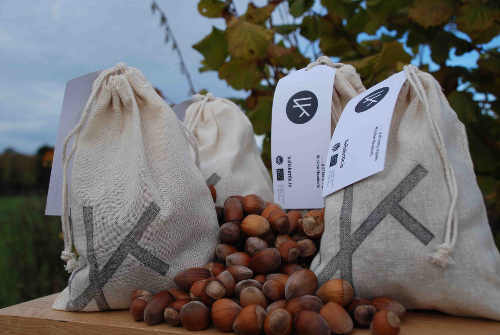 Fruit and Nut, a specialist supplier of fruit and nut trees at The Sustainability Institute in Co Mayo is in agreement, and not only supplies cultivars suitable for Irish conditions but also offers a consultancy service and horticultural workshops on a wide range of topics, including nut production.
Fruit and Nut, a specialist supplier of fruit and nut trees at The Sustainability Institute in Co Mayo is in agreement, and not only supplies cultivars suitable for Irish conditions but also offers a consultancy service and horticultural workshops on a wide range of topics, including nut production.
Although a number of garden centres carry limited stocks of trees, The Irish Nut Growers Association says very few have expert knowledge; in addition to Fruit and Nut, they suggest Woodkerne Nursery in West Cork for anyone who is serious about fruit and nut production.
An encouraging number of people in Ireland have invested in nut orchards in recent years, including the Lynch family of Hell’s Kettle Farm (087 990 1104) at Donard, Co Wicklow. They have farmed beside Hell's Kettle river for generations, but their range of produce is innovative - beef is a core product (butchered on site by Pat Lynch, who is a qualified butcher), but they also have bronze turkeys and grow fruit and nuts in a ‘forest garden’.
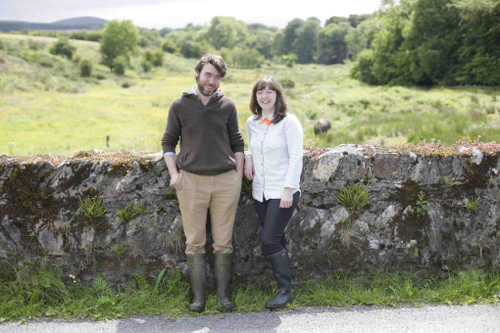 Gavin Lynch and his partner Linda are the latest generation to work the farm and they’re rightly proud of the four acres of hazelnuts that have just produced their first harvest. “We've been busily husking, cracking, roasting and sampling here for the past couple of weeks and we are wicked impressed, particularly with the roasted nuts which are little balls of deliciousness,” says Gavin.
Gavin Lynch and his partner Linda are the latest generation to work the farm and they’re rightly proud of the four acres of hazelnuts that have just produced their first harvest. “We've been busily husking, cracking, roasting and sampling here for the past couple of weeks and we are wicked impressed, particularly with the roasted nuts which are little balls of deliciousness,” says Gavin.
Buy directly (Online Shop and farm shop) and at the Castleruddery Organic Farm stall at Naas farmers market.
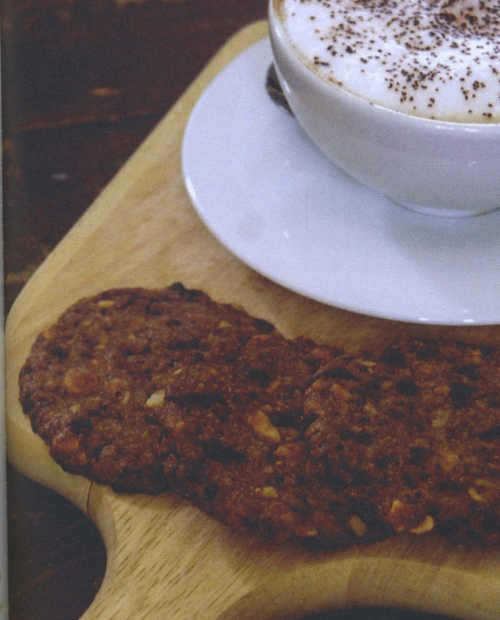 RECIPE: Wild Hazelnut Chocolate Chip Biscuits
RECIPE: Wild Hazelnut Chocolate Chip Biscuits
From ‘Wild Food’ by Biddy White Lennon and Evan Doyle, this is one of the recipes from The Strawberry Tree organic restaurant at BrookLodge Hotel, Co Wicklow.
100g wild hazelnuts, shelled
100g orgnic sugar
185g organic butter
1 organic egg
165g organic flour
175g organic 70% dark chocolate, chopped to crumb
A scant tsp sea salt
HOW IT GOES
Roast hazelnuts in the oven for 8-10 minutes at 170°C. Remove and place in a damp clean tea towel and rub hazelnuts together to remove skins and then finely chop the de-skinned hazelnuts.
Cream the butter and sugar together, add the egg and continue mixing. Add in the sieved flour, salt, and mix until well combined. Fold in the wild hazelnuts and crumbed chocolate. Place mixture in cling film and leave in fridge for 10 minutes.
HOW TO FINISH
Divide mixture into 30g portions and roll into balls and flatten on to parchment paper on an oven tray, with space to spread. Bake at 150'C for 15 minutes approx. Remove, and cool. Yields about 28 biscuits.
WHAT YOU GET
Is a taste of autumn with the wild hazelnuts and, besides, it makes for a really good excuse to have a chocolate chip biscuit.
Venison - In Season

 Wild venison is a treat that game lovers look forward to enjoying in restaurants in winter and, as it becomes more accessible, it is also being cooked more at home, both as a special occasion dish and - in the form of sausages, mince or stewing cuts - for family meals.
Wild venison is a treat that game lovers look forward to enjoying in restaurants in winter and, as it becomes more accessible, it is also being cooked more at home, both as a special occasion dish and - in the form of sausages, mince or stewing cuts - for family meals.
Hunting is an important aspect of deer management, as culling is necessary to maintain the health of the wild stocks. The season varies depending on the breed and sex of the animals, with females given particular protection.
Sika deer, which are mainly found in Kerry and Wicklow, were introduced in the 19th century, while Fallow deer date back to Norman times and are the most widespread throughout the country. The largest - and most cherished - is the native Red Deer, which is a familiar sight in the Killarney National Park, Co Kerry, and is in season from November to February when the herd size is managed.
Whether wild or farmed, venison is a very healthy meat - high in protein and low in fat, it is also rich in iron and B complex vitamins and, like other animals raised on pasture and in the wild, it has the advantages of excellent flavour and texture.
As it is very lean, venison needs to be cooked fast over high heat, or gently in braises and casseroles, depending on the cut.
While farmed venison is now quite widely available, wild venison is still an unusual food to most people and is best purchased from specialist suppliers such as Wild Irish Game, or other reliable purveyors who should be able to advise on the best cooking methods for the selected cut.
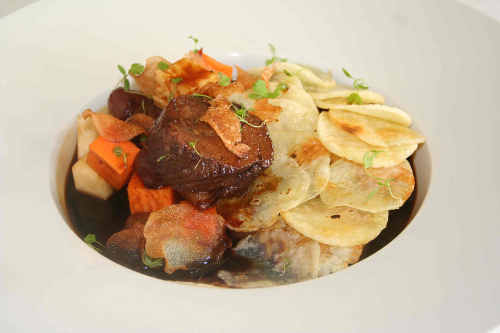 RECIPE: Wild Irish Venison & Root Vegetable Hot Pot
RECIPE: Wild Irish Venison & Root Vegetable Hot Pot
This recipe comes from Knockranny House Hotel in Westport, Co Mayo, where Head Chef Seamus Commons really enjoys cooking game and often lays on a special celebratory weekend at the height of the game season. Although venison is used here, other game meat or birds could be substituted.
Serves 4.
150g parsnip (peeled & cubed)
150g carrot (peeled & cubed)
150g turnip (peeled & cubed)
150g celeriac (peeled & cubed)
4 small banana shallots (peeled)
1 clove garlic (finely chopped)
1 bay leaf
1 sprig thyme
4 juniper berries
3 large potatoes (peeled & thinly sliced)
seasoning
500ml game stock
600g venison, sliced thickly (or alternative, eg pigeon breast)
100g diced smoked bacon
Method:
1. Preheat the oven to 180?C.
2. Season the meat and seal in a very hot pan with the juniper, thyme and bay leaf. Place in a buttered earthenware dish.
3. In a medium to hot pan sweat off the bacon, when crispy add the garlic, shallots and cubed vegetables. Sweat for a few minutes. Place in the earthenware pot on top of the meat and pour over the game stock.
4. Place the sliced potato on top and butter the top layer well.
5. Cover with a lid and place in the preheated oven for 25 minutes, then remove the lid and cook for a further 25 minutes
Sautéed Savoy Cabbage & Pancetta
The earthy flavours of cabbage and other brassicas partner well with game, especially when some form of bacon is included in the dish.
½ head Savoy cabbage (washed & finely chopped)
1 shallot (chopped)
100g pancetta (chopped)
2 sprigs thyme
20g butter
1. In a warm pot, melt the butter until lightly foaming.
2. Add the shallot, pancetta and thyme. Sweat until soft but with no colour. Add the cabbage and cook until tender.
Cauliflower - In Season
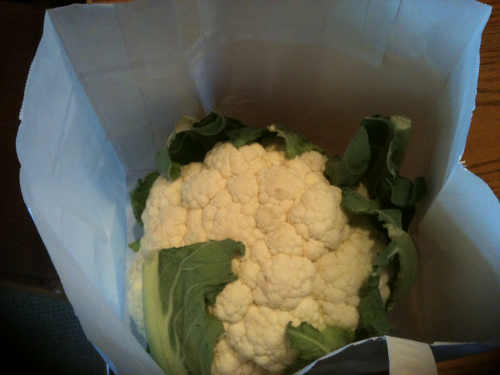
 A member of the brassica (cabbage) family dating back to the 16th century or earlier, cauliflower is one of our healthiest and most versatile vegetables.
A member of the brassica (cabbage) family dating back to the 16th century or earlier, cauliflower is one of our healthiest and most versatile vegetables.
With its white curdy head surrounded by a collar of green leaves, it is a lovely plant when freshly picked, yet it is widely undervalued - and that despite the fact that its image in some quarters has had an unexpected boost thanks to its rise to stardom in top restaurant kitchens of late.
But by the time chefs have put it through its paces (most often to become a very fine purée, purées also being in vogue) it bears little resemblance to the everyday vegetable that we all know and many of us love.
Having grown up on a farm in Cornwall where winter cauliflower (known locally as ‘broccoli’) was an important crop, I have fond memories of the many ways my mother cooked it for family meals - and it is a tribute to its goodness and versatility that I still enjoy it and feel that it deserves more respect than it generally gets.
Like other vegetables, it is currently sold at unsustainably low prices. The beautiful big head of cauliflower pictured here cost just €1.99 and - using the recipe below or something similar - this would provide a generous main dish for a family of four, or more if the children are small and/or plenty of other vegetables are part of the meal.
Bearing in mind the current shift in healthy eating advice, away from meat-focused meals to a diet that puts vegetables first, this is just the sort of food we should be eating on an everyday basis and it is much cheaper, quicker and easier - and tastier - than going to the takeaway.
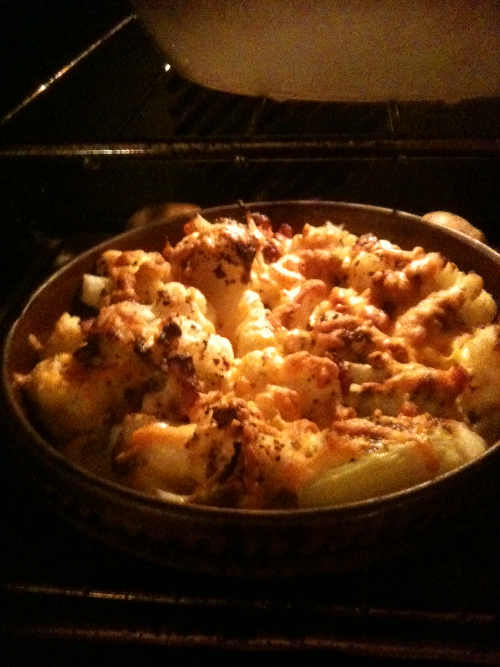 RECIPE: Easy Cauliflower Bake
RECIPE: Easy Cauliflower Bake
This is a favourite everyday supper dish that’s dead easy to rustle up whenever you want something quick, tasty and inexpensive. Amounts given for ingredients are flexible and it’s an easy dish to vary. Freshly chopped parsley or a handful of cherry tomatoes can be added as it goes into the oven and, if cooking for only one or two, half can be frozen surprisingly successfully if used fairly soon (within about a week).
Serves about 4 (depending on the size of the cauliflower and choice of accompaniments).
1 good cauliflower
oil or butter for frying
100g approx diced bacon, preferably smoked
1 large onion, sliced
Dollop of wholegrain mustard
Small (150ml) carton of cream, or as liked
Black pepper and sea salt to taste
3 or 4 tbsp grated hard cheese, eg a mature cheddar
Method:
1. Preheat the oven to 180ºC.
2. Trim the cauliflower as necessary, keeping any of the green outer leaves that look palatable. Cut cauliflower and leaves into large chunks. Put into a large pan with a sprinkling of salt, add boiling water and cook for a few minutes until just beginning to be tender but still crisp. Drain well and turn into a large buttered baking dish.
3. Meanwhile, add a little oil and/or butter to a shallow pan and cook the diced bacon and onion over moderate heat until softening. Add the cream and mustard, bubble up until the cream is thickening slightly, then season to taste and pour as evenly as possible over the cauliflower.
4. Sprinkle with the grated cheese and bake in the preheated oven for about 15 minutes or until brown and crispy.
5. Serve with baked potatoes or potatoes boiled in their skins, chunky carrots and any other available vegetables. Baked herby tomatoes are very good with this, also a few crisp green vegetables (related ones like sprouts or broccoli are best).
Blood Oranges - In Season
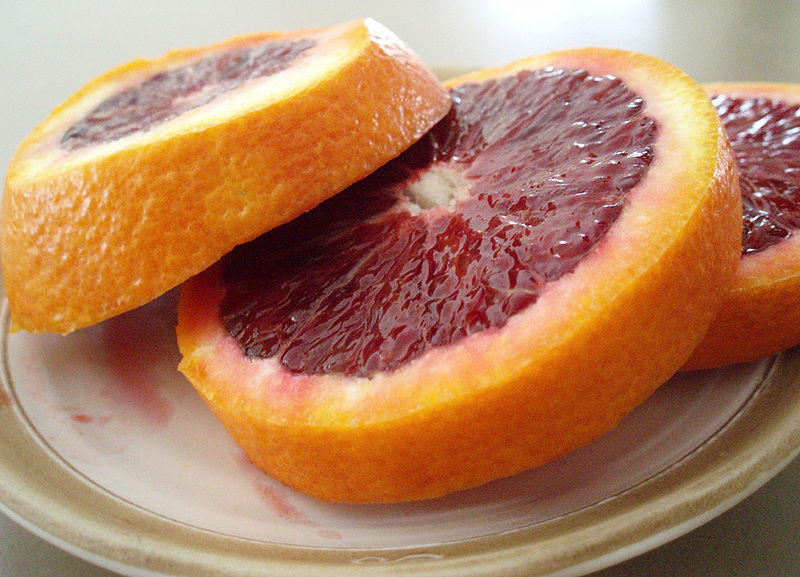
 Georgina Campbell
Georgina Campbell
Blood oranges are a variation of the familiar orange (Citrus x sinensis) with slightly reddish tones showing in the skin and deep, in some cases almost blood-red, flesh.
They are grown mainly in Mediterranean countries and one, the Arancia Rossa di Sicilia ( the Red Orange of Sicily), has PGI (Protected Geographical Indication) status. Their season is short and they are at their best in late winter, so enjoy them while you can. Like other citrus fruits they are light and healthy, with a high vitamin C content and lively, refreshing flavour.
The depth of colour and flavour varies according to variety, with Moro (Italy) and Sanguinello (Spain) both having a good deep colour and intense flavour. Like lemons and oranges they are very versatile in cooking and they look beautiful in many dishes where other citrus fruits would usually be used - with fish, for example - or when juiced.
The deep red colour and its association with love makes the blood orange an especially interesting ingredient to play around with for a romantic dinner - starting, perhaps, with the delicious salad below. I noticed it in Darina Allen’s Simply Delicious Christmas book - and how happy I would be to find this delicious, simple and refreshing dish on a restaurant menu…
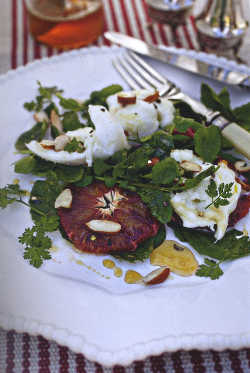 Watercress, Blood Orange and Toonsbridge Mozzarella Salad
Watercress, Blood Orange and Toonsbridge Mozzarella Salad
The rich West Cork pasture that the buffalos feed on gives the Toonsbridge mozzarella its quintessentially Irish taste. A few beautiful fresh ingredients put together simply make an irresistible starter. Make just before serving.
Serves 4
a bunch of fresh watercress
2-3 balls of fresh Toonsbridge mozzarella
2 blood oranges
2-3 tablespoons Irish honey
a good drizzle of extra virgin olive oil
coarsely ground black pepper
coarsely chopped roasted hazelnuts
sprigs of fresh flat parsley
Scatter a few watercress leaves over the base of each plate, warm the mozzarella (see below) then slice or tear some mozzarella over the top.
With a sharp knife, remove the peel and pith from the blood oranges. Cut into 5mm (1/4in) thickslices and tuck a few here and there in between the watercress and mozzarella.
Drizzle with honey and really good extra virgin olive oil. Finally, add a little coarsely cracked fresh black pepper, sprinkle with coarsely chopped roasted hazelnuts and a few sprigs of flat parsley and serve.
TIP: Put the balls of mozzarella into a thick plastic bag and drop in simmering water for 3 or 4 minutes. This transforms the mozzarella to a melting tenderness.
[Note: If watercress is unavailable, try using other robust salad leaves, eg curly endive, chicory or lamb’s lettuce. GC]
Hogget - In Season
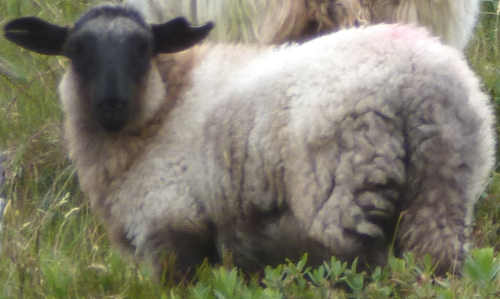
 Georgina Campbell
Georgina Campbell
Although Easter is just around the corner (and early this year) March is only the beginning of spring and it can be a very chilly month, when comfort food that makes the most of the remaining autumn and winter ingredients can be very welcome.
St Patrick’s Day is the big event on the culinary calendar of course, and it’s no coincidence that the foods traditionally associated with the festival, like boiled bacon and Irish stew, make the most of hearty country fare.
Hogget is not a word that’s heard very much these days, but it should be. It refers to lamb from the previous season, between a year and eighteen months old - not yet mutton, but a good sized animal, with plenty of well flavoured meat on it. In the days when wool was highly valued, it was the age at which the very best quality fleece was produced.
Hogget is available from in the spring and early summer for a short season, until the new season's lamb takes over. While new season lamb is seen as a special treat for the Easter table, hogget is a much better buy and has far more flavour.
It makes a decent sized family roast and is ideal for Irish Stew in all its many variations. Try it, for example, in the recipe below, from Mary Gleeson at Gleeson’s Townhouse & Restaurant in Roscommon. It’s a dish that Gleesons has become famous for - in National Geographic’s recent ‘Top 10 Ireland and Northern Ireland: Food and Drink’, this simple lamb stew was singled out as the one to try in Ireland, cooked in “fresh thyme and rosemary-flavoured broth with onions, carrots, celery, and potatoes.”
Perhaps they were led to it by Colman Andrews, who had enthused about this dish in his widely acclaimed book ‘The Country Cooking of Ireland’ (2009): “I’ve eaten Irish Stew in private homes and public eating places, North and South, probably twenty five or thirty examples in all and no two have been alike. The most purely delicious example I remember came from Gleeson’s Townhouse & Restaurant in Roscommon though I suspect its appeal came not from any secret ingredients or from any magical cooking technique but from the flavors inherent in the raw materials that went into it…”
I think he is right about the secret of it unique appeal - this is such a simple recipe that it can only be the quality and local flavours of the prime ingredients that make it special.
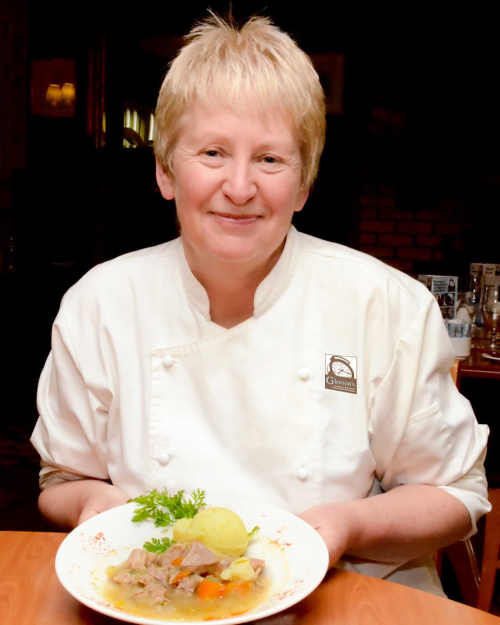 RECIPE Gleeson’s Townhouse Roscommon Lamb Stew
RECIPE Gleeson’s Townhouse Roscommon Lamb Stew
1 kg lean stewing lamb, cut up
3 large carrots, sliced
2 celery sticks, sliced
1 large onion, diced
8 medium peeled potatoes
1 litre chicken stock
fresh rosemary & thyme
sea salt & freshly ground black pepper.
1. Put the lamb into a cooking pot and cover with water.
2. Place vegetables in a separate pot and cover with stock and herbs.
3. Cook lamb gently until tender.
4. Cook the vegetables until three quarters cooked.
5. Strain half of the liquid from the lamb and combine with the vegetables.
6. Cook out fully and season to taste.
Nettles - In Season
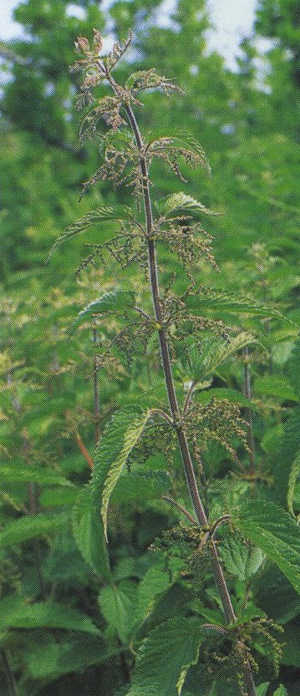
 The common Stinging Nettle, Urtica dioica, was for many generations an important traditional food in Ireland, providing a free and tasty ingredient for soups, purées and sauces in the spring. As they are rich in minerals and vitamins and said to cleanse the blood, nettles were taken as a medicinal herbal tea - for a sort of internal spring cleaning - on three consecutive days, beginning on May Day.
The common Stinging Nettle, Urtica dioica, was for many generations an important traditional food in Ireland, providing a free and tasty ingredient for soups, purées and sauces in the spring. As they are rich in minerals and vitamins and said to cleanse the blood, nettles were taken as a medicinal herbal tea - for a sort of internal spring cleaning - on three consecutive days, beginning on May Day.
Nettles are easily recognised by their hairy stinging leaves and easy to find in the wild; they grow abundantly in hedgerows and waste ground, including odd corners of domestic gardens where they are usually regarded as a weed. So it would amuse (or bemuse) our ancestors that they are now seen as a superfood and grown by specialist producers as a commercial crop...
Nettles are very nutritious, boasting high levels of Vitamins A and C, iron, and - more surprisingly - protein. Even more surprisingly, perhaps, the fibrous stems were once used to make a high quality linen-like cloth.
Spring is the best time to harvest nettles, before they begin to flower in June, and, although most often associated with soup, they can be used in much the same way as spinach. Pick when young, using gloves; strip the leaves off the stems and wash well before use, especially if picked near roads. (Soaking in water and/or cooking will inactivate the stings in the hairs.)
RECIPES
This basic Nettle Purée is given in Richard Mabey’s foraging classic ‘Food for Free’ and it can be used as the basis for numerous dishes, including nettle soup: “Put washed nettles in a pan, cover and boil gently for about 4 minutes (without adding water). Drain well, add a large knob of butter, plenty of seasoning (perhaps some chopped onion). Simmer for 5 minutes while turning and mashing. The resulting puree is fluffy in texture, but rather insipid to taste, a little like pea-pods. Use puree as a vegetable on its own, spread on toast and serve with a poached egg, or mix into balls with oatmeal and fry in bacon fat.”
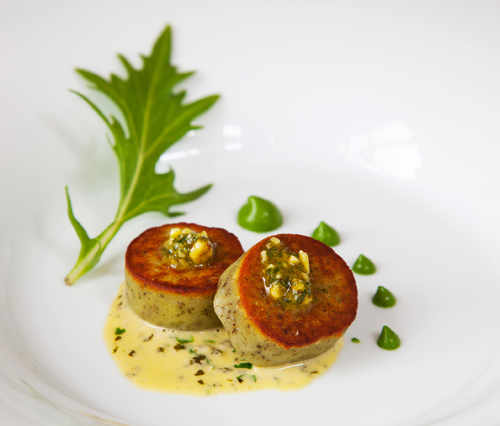 As the flavour is mild, nettle purée needs to be seasoned carefully and is best partnered with more strongly flavoured ingredients such as onion or garlic, as in this Sage Gnocchi, Wild About Nettle Pesto Cream, Garlic Purée. This recipe was created by chef Derry Clarke of l’Ecrivain Restaurant, Dublin, for the Irish Food Writers’ Guild Food Awards 2015. It was devised to showcase one of the award winners’ products, the delicious Wild About Nettle Pesto - but you could try making your own, using Hugh Fearnley-Whittingstalll’s recipe, given below.
As the flavour is mild, nettle purée needs to be seasoned carefully and is best partnered with more strongly flavoured ingredients such as onion or garlic, as in this Sage Gnocchi, Wild About Nettle Pesto Cream, Garlic Purée. This recipe was created by chef Derry Clarke of l’Ecrivain Restaurant, Dublin, for the Irish Food Writers’ Guild Food Awards 2015. It was devised to showcase one of the award winners’ products, the delicious Wild About Nettle Pesto - but you could try making your own, using Hugh Fearnley-Whittingstalll’s recipe, given below.
Serves 4
for the sage gnocchi
1 egg yolk
50g parmesan
50g olive oil
½ bunch fresh sage
250g mashed potato
75g pasta flour
oil, for frying
for the garlic purée
2 bulbs garlic
500ml milk
for the nettle pesto cream
500ml cream
3 tbsp of Wild About nettle pesto
To make the gnocchi, blend the egg yolk, parmesan cheese, olive oil and sage in a food processor. Mix the potato mash and pasta flour together. Bring together the egg mix and potato mix and knead to form a smooth dough.
Divide the dough into three and roll each piece into a long cylinder, roughly 2cm in diameter, cover and leave in the fridge to chill for 30 minutes. Cut into thick slices and poach in simmering water until the gnocchi float to the top of the water. Remove with a slotted spoon and plunge into iced water, then pat dry.
To make the garlic purée, peel the garlic cloves and place in cold water, bring to boil and strain. Repeat this process two more times, then place the garlic in the milk, simmer until the garlic is tender. Strain and blend in a food processor. Add a little more of the milk if the purée is too thick.
To make the nettle pesto cream, pour the cream into a small pan and reduce cream by half over a medium heat, remove and add Wild About nettle pesto and season.
To serve, heat a small frying pan, add a little oil and brown the gnocchi on both sides. Serve the gnocchi in a pool of nettle pesto cream and dot some garlic purée to the side.
At River Cottage Hugh Fearnley-Whittingstall makes this Nettle Pesto using local ingredients, to use ‘swirled through soups or tossed through pasta’, or wherever pesto would normally be used.
20g breadcrumbs
100g young nettles (or the top few leaves of older ones)
20g strong Cheddar, grated
½ garlic clove, crushed to a paste with a little salt
150-200ml rapeseed oil
Salt and black pepper
Preheat the oven to 180°C/Gas Mark 4. Scatter the breadcrumbs on a baking tray and bake for about 10 minutes until dry and golden, checking them frequently towards the end as they burn quite quickly. Tip onto a plate and allow to cool.
Wearing gloves, pick over the nettles, discarding all but the thinnest stalks, then wash well. Fill a bowl with iced water. Find a pan large enough to take the nettles and half-fill it with water.
Bring to the boil and cram in the nettles, pushing them down with a wooden spoon to immerse them. Cook for just 1 minute, then drain through a sieve over a bowl to save the cooking water. Immediately plunge the nettles into the iced water. As soon as they are cold, remove and squeeze them as dry as you can – they will not sting you once they are cooked.
Put the nettles into a food processor along with the breadcrumbs, cheese and garlic. With the machine on low speed, trickle in enough rapeseed oil to make a loose paste. (Alternatively, you can grind the nettles, breadcrumbs, garlic and cheese to a paste using a pestle and mortar, then slowly incorporate the oil.)
Season your pesto with salt and pepper to taste. It is now ready to use. As for the nettle cooking water you saved, drink it – it's too good to waste.
Trout - In Season
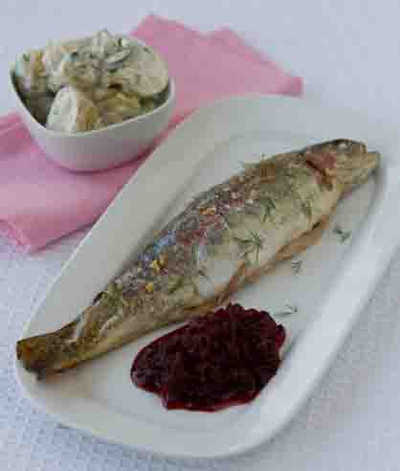
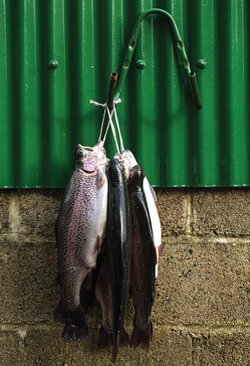 Georgina Campbell
Georgina Campbell
With the mayfly hatching this month, it’s peak season for trout. Closely related to salmon and Arctic char, the name trout actually covers a number of fish including the prized sea trout (a large salmon-like migratory form of river trout), brown trout and rainbow trout.
Most trout spend their entire lives in freshwater lakes and rivers, while others may spend several years in coastal sea water before returning to fresh water to spawn, in a similar way to salmon; a rainbow trout doing this is called a steelhead.
Of the smaller fish, the wild brown (river or lake) trout is a dark-skinned spotted fish and highly sought after for its superior eating qualities.
However, while the texture and flavour of brown trout are recognised as being particularly fine, the cooking methods are the same for all types with pan frying, grilling, oven baking and poaching all suitable, depending on size.
Today, the rainbow trout is known mainly as a farmed fish - the best known Irish example is the excellent Kilkenny producer Goatsbridge Trout Farm (www.goatsbridgetrout.ie) at Thomastown, which is open to visitors and whose products are widely available. They also hold classes.
For information on fishing in Ireland visit www.fisheriesireland.ie
 RECIPE: Baked Trout with Herbs
RECIPE: Baked Trout with Herbs
This recipe from our book From Tide To Table is a very healthy and simple dish equally suited to wild or farmed trout. Perfect for a summer evening - when the trout could be cooked on the barbecue - this oven method really helps to keep the fish moist.
SERVES 4
4 tsp olive oil plus extra for oiling
4 x whole rainbow trout, gutted and cleaned
4 tbsp white wine
2 tsp fresh lemon juice
1 tsp each chopped fresh flat-leaf parsley, chives, dill and basil
salt and freshly ground black pepper
To Serve
beetroot chutney and warm potato salad
Preheat the oven to 190ºC/375ºF/Gas 5. Lightly oil an ovenproof dish that nicely fits the size of the trout. Add the trout and then drizzle over the white wine and lemon juice. Season to taste and bake for 15-20 minutes, or until the trout are completely tender.
Remove the trout from the oven and transfer to serving plates. Mix the olive oil and herbs with the remaining juices in the dish and drizzle over the trout. Add a dollop of the beetroot chutney and serve with small bowls of the warm potato salad on the side.
Yellow Man - In Season
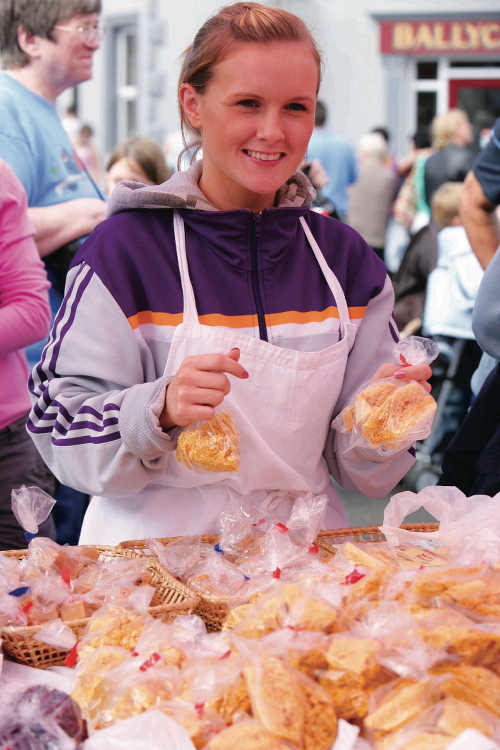
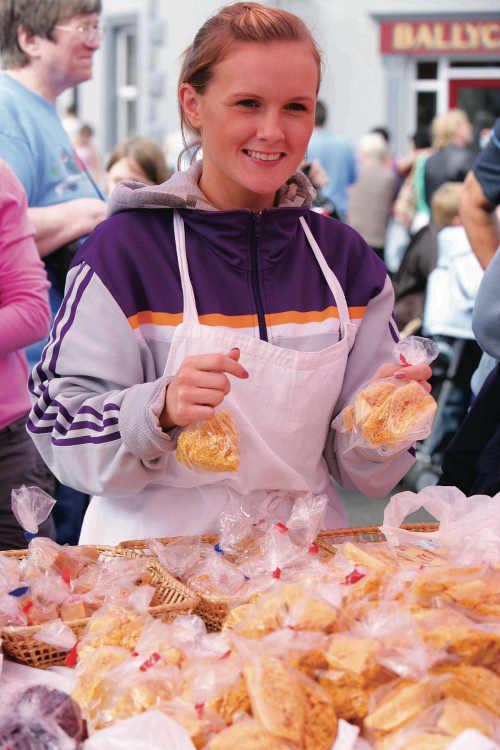 Not exactly ‘in season’ of course, but the crunchy sweet, Yellow Man, is unique to Northern Ireland and - although it is also found on stalls at other country fairs and, nowadays, in the shops - this traditional toffee-like sweet is firmly associated with Lammas Fair, which is held at Ballycastle, Co Antrim, in late August and marks the end of the summer (24-25th August 2015).
Not exactly ‘in season’ of course, but the crunchy sweet, Yellow Man, is unique to Northern Ireland and - although it is also found on stalls at other country fairs and, nowadays, in the shops - this traditional toffee-like sweet is firmly associated with Lammas Fair, which is held at Ballycastle, Co Antrim, in late August and marks the end of the summer (24-25th August 2015).
The fair dates back to the 17th century and is connected with the harvest festivals of lunaghsa, held earlier in the month throughout Scotland and the Isle of Man as well as Ireland.
All sorts of things are sold at Auld Lammas Fair, which attracts thousands of visitors - but the most popular stalls are sure to be the ones selling Yellow Man and another, very different, traditional food that’s always been sold at the fair, the sea vegetable dulse, or dillisk (Rhodymenia palmate).
A famous maker of yellow-man was Dick Murray, of Lurgan who, it is said, sometimes put a ha'penny or two into it in its liquid state, and whoever found it could return it to him in exchange for more of his yellow-man which, he claimed, 'cured all diseases'.
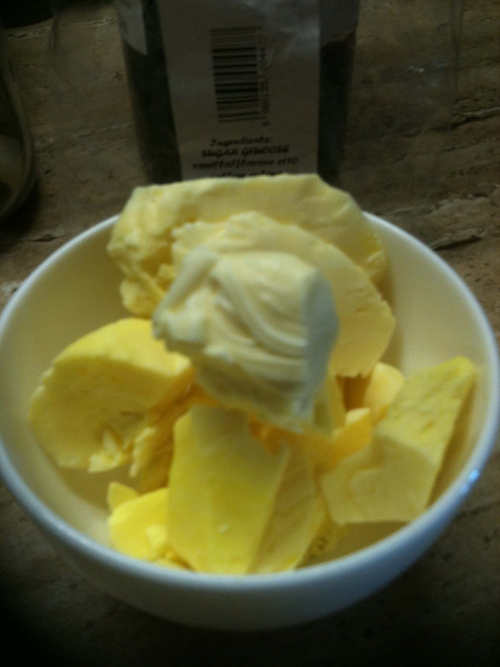 RECIPE: This 'Modern Rendering' of the traditional recipe is the version I gave in my first book ‘Good Food From Ireland’ (Grafton Books/HarperCollins, 1991) and it’s from one of my favourite cookery books Florence Irwin's ‘The Cookin’ Woman’ published in 1949.
RECIPE: This 'Modern Rendering' of the traditional recipe is the version I gave in my first book ‘Good Food From Ireland’ (Grafton Books/HarperCollins, 1991) and it’s from one of my favourite cookery books Florence Irwin's ‘The Cookin’ Woman’ published in 1949.
4 oz/l00g butter
2 tablespoons vinegar
½ lb/225g treacle
½ lb/225g golden syrup
1 lb/450g Demerara sugar
½ teaspoon baking soda
Melt the butter.
Add the vinegar, treacle, syrup and sugar.
Stir until it has melted, then bring to the boil.
Boil hard until a strand 'cracks' when tested in a saucer of cold water. Remove from the heat.
Stir in the soda.
When it foams up, stir again.
Pour into a greased tin.
Mark into squares when cool.
Store in an airtight tin when absolutely cold.
Marrows - In Season
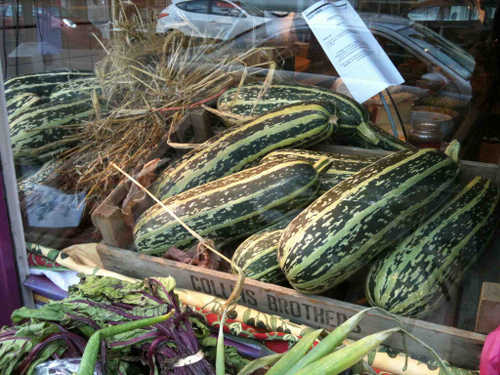
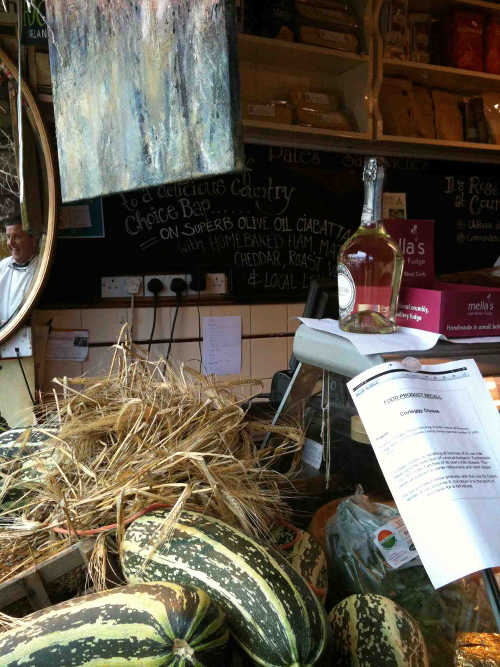 A gorgeous display of marrows in the window of the Ward family’s superb shop and café, Country Choice, in Nenagh, Co Tipperary has reminded me that we hear plenty about other, more exotic, members of the Cucurbita (gourd) family - which includes squash and pumpkin - but very little about the whopper marrows that I remember from my childhood.
A gorgeous display of marrows in the window of the Ward family’s superb shop and café, Country Choice, in Nenagh, Co Tipperary has reminded me that we hear plenty about other, more exotic, members of the Cucurbita (gourd) family - which includes squash and pumpkin - but very little about the whopper marrows that I remember from my childhood.
In those days stuffed marrow was a regular on the family dinner table and my mother had countless tricks up her sleeve to make good use of this abundant food. Growing good marrows used to be a point of honour in the country, and they usually took pride of place on top of the compost heap where they were warm and well fed. As children, watching the plants develop from seeds to thriving plants burgeoning with big fat marrows involved regular trips to the compost heap, which was itself an education for life.
Perhaps that kind of gardening has less appeal these days, but the revival of interest in self-sufficiency - or, at least, in finding local sources for everyday foods - is strong and genuine.
And there are still plenty of marrows around, in Co Tipperary at any rate, and there are many ways of using them. The flesh is very delicate, providing a neutral background for more robustly flavoured fillings, sauces etc, in much the same way as potatoes, pasta or rice - but without the high carbohydrate content.
There are endless ways to cook marrow, your imagination is the only limitation. Aside from the many variations on baked marrow (halved, deseeded, stuffed with a tasty mixture of your choice, and baked until tender), most involve removing the (tough) outer skin and scooping out the seeds and membrane in the middle; you then have a satisfying large amount of flesh to play with.
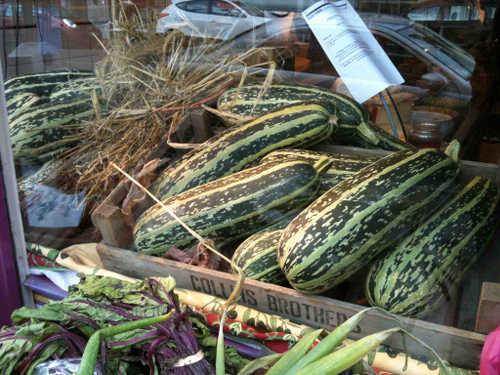 Try it cut into big chunks and baked around the Sunday roast, for example, or maybe think Mediterranean - ratatouille/ piperade family - and create a herby sauce or stew using marrow, tomatoes, garlic and whatever other late summer vegetables may still be to hand.
Try it cut into big chunks and baked around the Sunday roast, for example, or maybe think Mediterranean - ratatouille/ piperade family - and create a herby sauce or stew using marrow, tomatoes, garlic and whatever other late summer vegetables may still be to hand.
Mixed with other well-flavoured vegetables, it’s useful in soups and a plethora of side dishes - and surprisingly perhaps, given the high water content, it can also be fried or deep-fried successfully (treat like aubergine, ie salt well to bring out the juices, then rinse and pat dry before proceeding). Whatever you choose to do, the great strength of the marrow is the very thing that many would see as a downside; ie its neutral (some would say bland) flavour, which – like chicken - allows the cook a free hand with complementary ingredients, including a wide range of pulses, herbs and spices.
And then, of course, there are preserves A spicy chutney is a great way of producing something special for the store cupboard with this unassuming vegetable and this piquant preserve complements all kinds of cold meats, or simply fresh wholemeal bread and farmhouse cheese.
Although it wouldn't originally have included the sweet peppers, this is basically a traditional recipe and would have been familiar in many a farmhouse kitchen down through the years.
RECIPE: Marrow and Tomato Chutney
One 3 lb/1.4 Kg marrow, or equivalent
3 oz/75g salt
8 oz/225g windfalls or cooking apples
l large onion
l red pepper
l green pepper
4 oz/100g dates, stoned
6 oz/175g seedless raisins
l lb/450g red tomatoes
l pint/575 ml vinegar
½ oz/12g mustard seed
2 rounded teaspoons grated root ginger
2 flat teaspoons ground allspice
l flat teaspoon ground cinnamon
l flat teaspoon ground mace
l lb/450g Demerara sugar.
Makes about 6 lb/2.7 Kg.
Peel the marrow, remove the seeds and pith and cut the flesh into small cubes. Arrange in layers in a large bowl, with the 3 oz/75g salt scattered through them. Cover and leave in a cool place for 24 hours. Drain the marrow thoroughly in a colander, then rinse under the cold tap and drain well again.
Meanwhile, peel, core and chop the apples, discarding any bruises and make up the weight as necessary. Chop the onion quite finely. Remove stems, seeds and membranes from the peppers and chop the flesh. Peel the tomatoes and chop roughly.
Put all the ingredients except the marrow and sugar into a preserving pan or heavy-based saucepan and cook over low heat for about 1½ hours until tender.
Stir in the sugar and, when it has dissolved, stir in the marrow cubes. Simmer for an hour or so, stirring occasionally to prevent sticking, until the marrow is soft and most of the liquid has evaporated.
Pour into clean wide-necked jars.
When cold, cover with vinegar-proof lids - plastic-lined metal is alright, but be careful not to use untreated metal lids. Label and store in a cool, dark place. Although it can be used immediately, the chutney is best left for about two months before use, to let the flavours mellow and mature.
Pumpkins & Squash - In Season
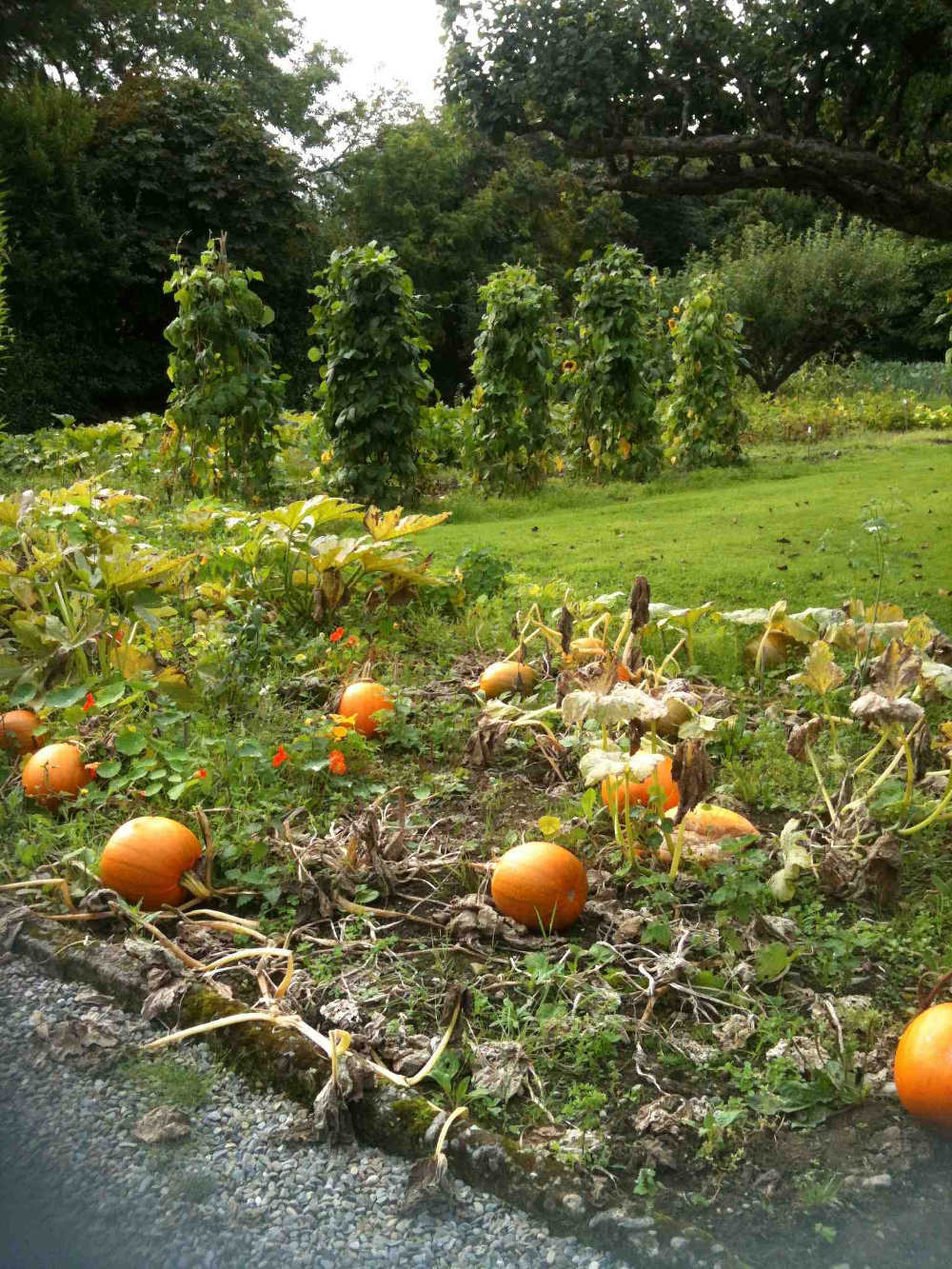
 Pumpkins are not just for Halloween, as - like other so-called winter squashes - they store well after ripening and can be kept throughout the winter, making a versatile addition to the usual range of vegetables.
Pumpkins are not just for Halloween, as - like other so-called winter squashes - they store well after ripening and can be kept throughout the winter, making a versatile addition to the usual range of vegetables.
The flesh is delicately flavoured and can be bland, so generously spiced dishes tend to be most popular, but the flavours vary so it does pay to experiment - and the roasted seeds of some varieties are a bonus.
Although pumpkins, in particular, are easy enough to find in the shops coming up to Hallowe’en, squashes and pumpkins are fun to grow, especially with children, and it’s worth thinking about growing your own next year.
The number of varieties available is surprising, with big pumpkins like Hundredweight or Dill’s Atlantic Giant the ones to choose for competitive Hallowe’en bravado, while more compact ones such as Becky are handier for small gardens and usually have better eating qualities too.
The winter squashes include many varieties - butternut squash, turban squash, acorn squash, banana squash and hubbard squash are just a few of them. All are good to eat and some, such as butternut, are especially good, while others like the turban varieties, tend more towards the decorative end of the spectrum.
If growing your own pumpkins and squashes, let them ripen at least until they begin to colour (sometime in October); once picked and stored in a dry, frost-free place, the colour continues to develop and they can be used for months.
All seed companies will have some pumpkins and squash in their ranges but, as well as the well known garden centre brands, also consider specialist Irish companies such as Irish Seed Savers and Brown Envelope Seeds. There are many advantages over the big international companies, including the fact that their seeds are more likely to suit Irish growing conditions.
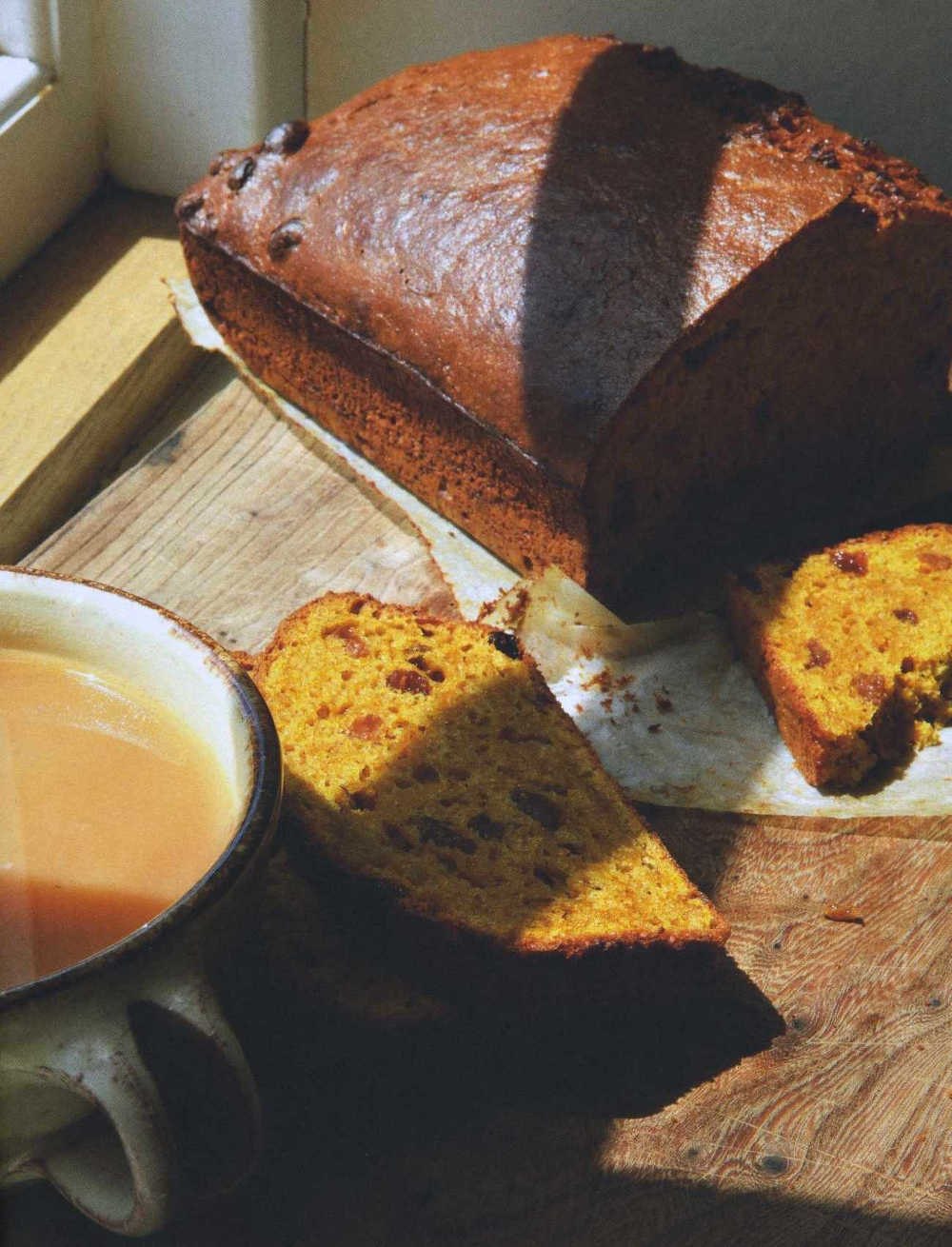 RECIPE: Pumpkin And Raisin Tea Loaf
RECIPE: Pumpkin And Raisin Tea Loaf
This delicious tea loaf is from Hugh Fearnley Whittingstall’s great book, River Cottage Veg Everyday! (Bloomsbury, hardback £25) It is rich and sweet, but also quite light because it doesn't contain any butter or oil.
MAKES 72 GENEROUS SLICES
A little butter or sunflower oil, for greasing
200g light muscovado sugar
4 large eggs, separated
200g finely grated raw pumpkin or squash flesh
Finely grated zest and juice of 1 lemon
l00g raisins
l00g ground almonds
200g self-raising flour
A pinch of fine sea salt
1 teaspoon ground cinnamon
A generous grating of nutmeg
Preheat the oven to 170°C/Gas Mark 3. Lightly grease a loaf tin, about 20 x 10cm, and line with baking parchment.
Using an electric whisk, beat the sugar and egg yolks together for 2-3 minutes until pale and creamy. Lightly stir in the grated pumpkin or squash, lemon zest and juice, raisins and ground almonds.
Sift the flour, salt and spices together over the mixture and then fold them in, using a large metal spoon.
In a large, clean bowl, beat the egg whites until they hold soft peaks. Stir a heaped tablespoonful of the egg white into the cake mixture to loosen it a little, then fold in the rest as lightly as you can.
Tip the mixture into the prepared loaf tin and gently level the surface. Bake for about 1 hour, or until a skewer inserted into the centre comes out clean.
Leave to cool in the tin for 10 minutes, then transfer to a wire rack to cool completely before slicing.
VARIATIONS: For courgette, carrot or beetroot tea loaf, replace the pumpkin with 200g finely grated raw courgette, carrot or even beetroot (which produces a striking purple-marbled effect).
Sweet Chestnut - In Season
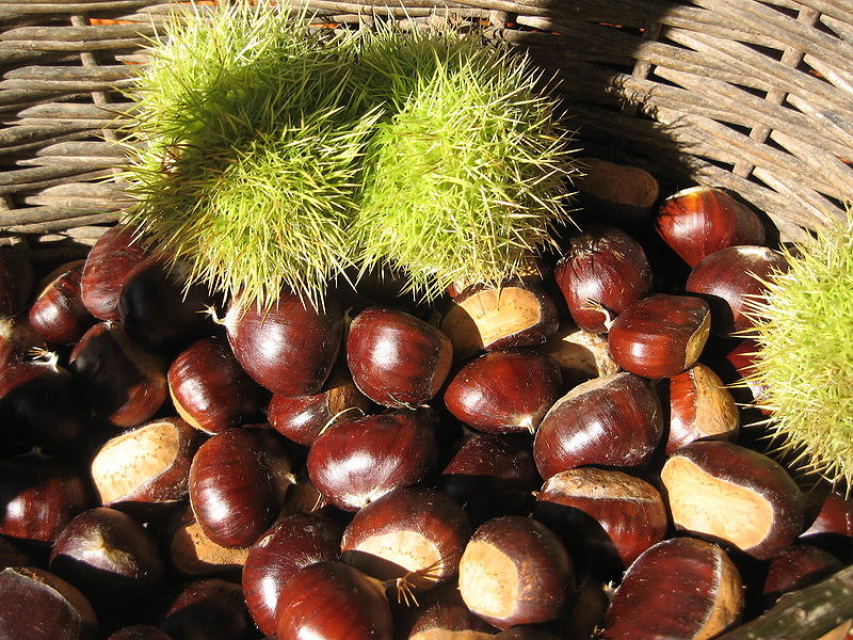
 So much a part of our traditional Christmas, the edible chestnut, Castanea sativa, known as the Spanish or Sweet Chestnut, is a major food crop in some areas of Western Asia, North Africa and Southern Europe, especially the Mediterranean region.
So much a part of our traditional Christmas, the edible chestnut, Castanea sativa, known as the Spanish or Sweet Chestnut, is a major food crop in some areas of Western Asia, North Africa and Southern Europe, especially the Mediterranean region.
It has a commercial history dating back to Roman times and chestnut trees can be grown in some parts of Ireland - Darina Allen has a beautiful young tree in the gardens at Ballymaloe Cookery School and it has grown remarkably quickly, which may encourage more people to try. But the fresh chestnuts on sale here are most likely to come from France, Italy, Spain or Portugal, with the famous Ardèche Chestnut (AOC) being especially desirable, also the Mugello sweet chestnut (PGI) from Italy, which both peel easily and have good flavour.
Unrelated to the common horse chestnut (which is not edible), the sweet chestnut is an unusual nut in that has very little protein or fat, but its high carbohydrate content can make it useful for flour - and it is gluten free, which is a big plus, although the downside is that it doesn’t rise like most other flours.
In the past it has been associated with subsistence diets, but today it is more likely to be thought of as a treat - ‘chestnuts roasting on an open fire’ (or in the street) conjure up nostalgic memories, and who could resist a French marron glacé, the delicious candied chestnut that is traditional in France at Christmas and New Year and with variations that are associated with feast days in other European countries.
Chestnuts make a versatile ingredient in both sweet and savoury cooking and, although the season is short, they preserve well and are easily available vacuum-packed, canned or dried - also as canned chestnut purée, which makes a luxurious convenience food, handy for whipping up all kinds of quick but impressive dishes -the classic Mont Blanc, for example, where chestnut purée is topped with crème fraiche (the Italian version is Montebianco).
If used fresh, they need to be cooked (boiled or roasted) and peeled before use; prick them before cooking and peel while warm, carefully removing the inner skin as it tastes bitter and will spoil the dish.
You can make chestnut ‘flour’ in a food processor, to use in treats like gorgeous Buche de Noel, the classic chestnut and chocolate combo in a rich variation on the festive yule log, or you can use chopped chestnuts in stuffings, whole with vegetables (they’re delicious with sprouts, for example, for the Christmas table), or in more-ish soups like this one from Hugh Fearnley-Whittingstall’s ‘Veg Everyday’, published by Bloomsbury Publishing.
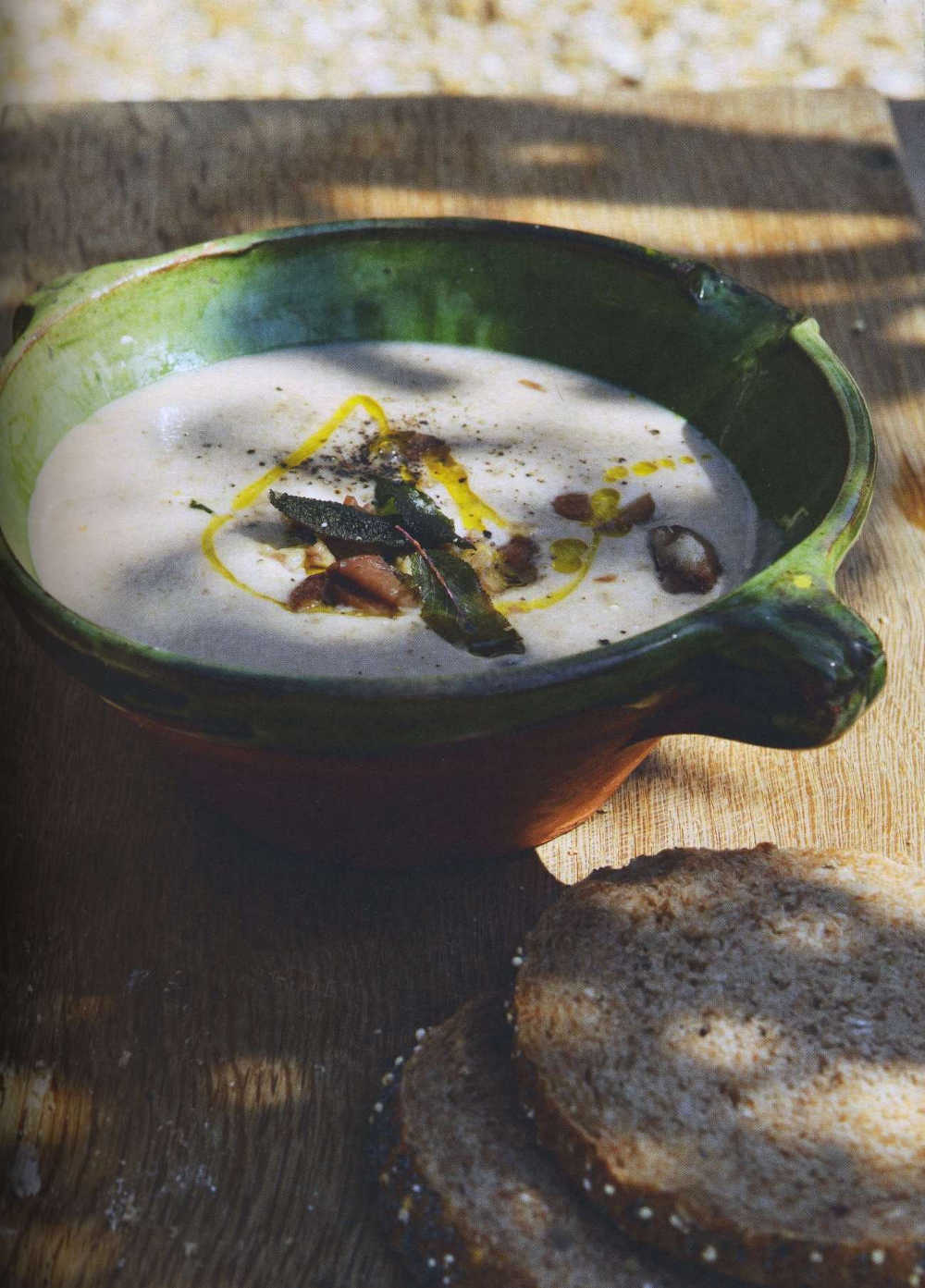 RECIPE: Chestnut and sage soup
RECIPE: Chestnut and sage soup
This is a rich and elegant soup with a beguilingly velvety texture. A small portion makes a lovely starter (perfect for Christmas Day), while a larger serving, with some bread and perhaps a crisp green salad, is a satisfying lunch or supper. You can use vac-packed pre-cooked chestnuts for this, or fresh, whole chestnuts, blanched, peeled and simmered until tender.
SERVES 4-6
3 tablespoons olive oil, plus extra to trickle
15g butter
1 medium onion, chopped
6 sage leaves, roughly chopped, plus extra to finish
1 small garlic clove, finely chopped
1 litre good vegetable stock
400g cooked, peeled chestnuts
100ml creme fraiche
Sea salt and freshly ground black pepper
Heat 1 tablespoon of the olive oil and the butter in a saucepan over a medium-low heat and sweat the onion for about 10 minutes, until soft and translucent. Add the sage and garlic and sauté for a minute.
Pour in the stock and add most of the chestnuts - reserve a handful for finishing. Season with salt and pepper, increase the heat and simmer for 15 minutes, stirring from time to time.
Remove from the heat and cool slightly, then purée until very smooth in a blender or food processor, or using a stick blender. Return the soup to the pan, add the creme fraiche and adjust the seasoning if necessary. Warm through gently - do not let it boil.
Meanwhile, slice the reserved chestnuts. Heat the rest of the olive oil in a small frying pan over a medium heat and sauté the sage leaves for a few seconds until crisp, then drain on kitchen paper.
Ladle the soup into warmed bowls, scatter on the chestnuts and sage leaves and add a trickle of olive oil. Finish with a generous grinding of black pepper. Serve immediately.
Lentils - In Season
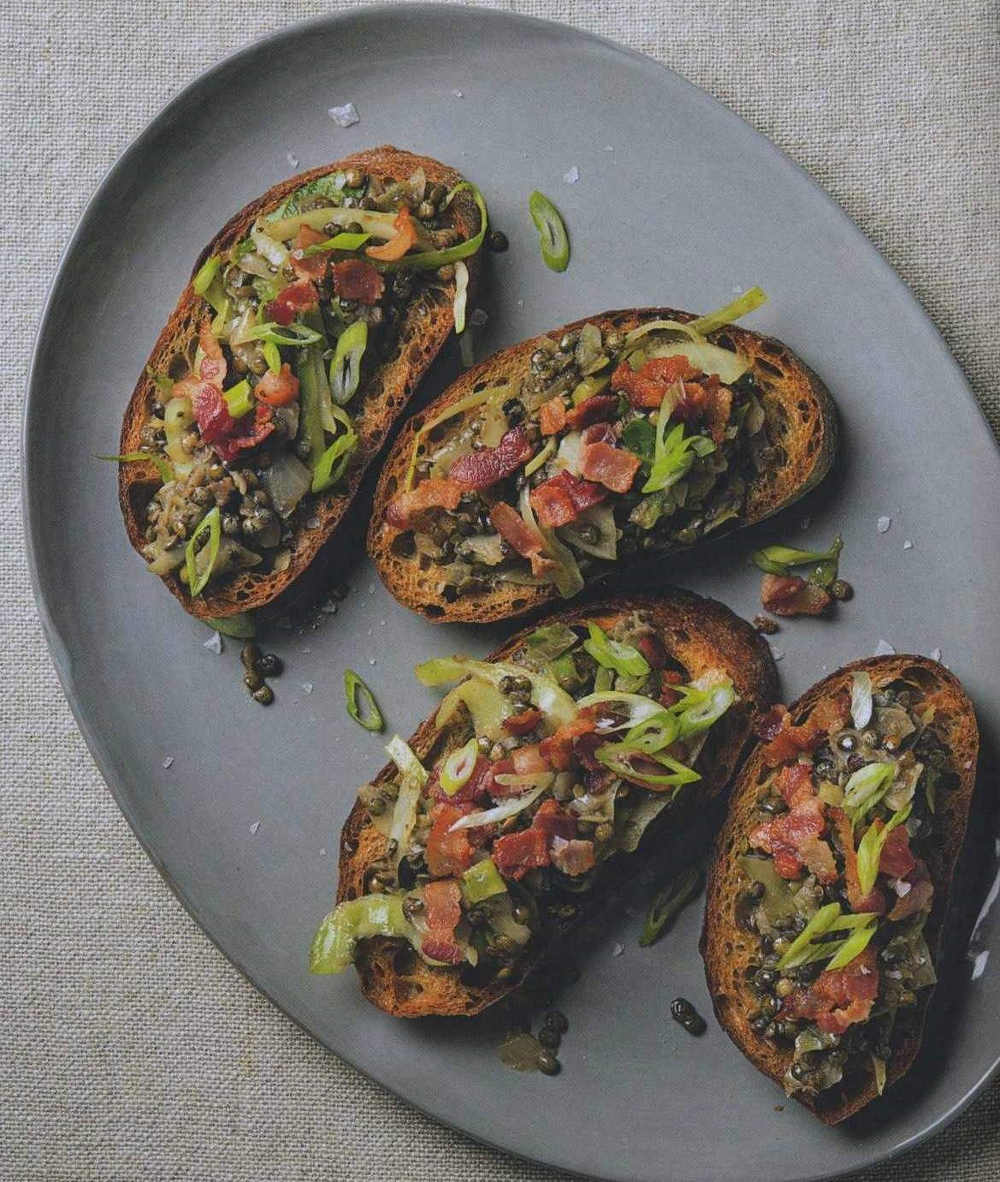
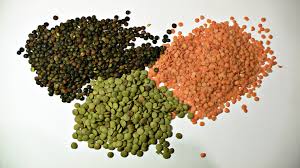 Okay, lentils are dried, so they don’t have a specific season of use, but they’re especially relevant this month as pulses are set to be one of the top food trends of 2016 - and not just for their wholesome goodness, but because the UN General Assembly, no less, has declared 2016 the International Year of Pulses (IYP).
Okay, lentils are dried, so they don’t have a specific season of use, but they’re especially relevant this month as pulses are set to be one of the top food trends of 2016 - and not just for their wholesome goodness, but because the UN General Assembly, no less, has declared 2016 the International Year of Pulses (IYP).
The aim is to heighten public awareness of the nutritional benefits of these annual leguminous crops as part of sustainable food production aimed towards food security and nutrition.
The Food and Agriculture Organisation of the United Nations (FAO), which is to facilitate the implementation of the Year, says that pulse crops such as lentils, beans, peas and chickpeas are a critical part of the general food basket.
Pulses are a vital source of plant-based proteins and amino acids for people around the globe and should be eaten as part of a healthy diet to address obesity, as well as to prevent and help manage chronic diseases such as diabetes, coronary conditions and cancer; they are also an important source of plant-based protein for animals.
In addition, pulses are leguminous plants that have nitrogen-fixing properties which can contribute to increasing soil fertility and have a positive impact on the environment.
For further information through the year check out the IYP website http://iyp2016.org/
As for me, I’ll just eat them as often as possible as usual, because they’re versatile and delicious.
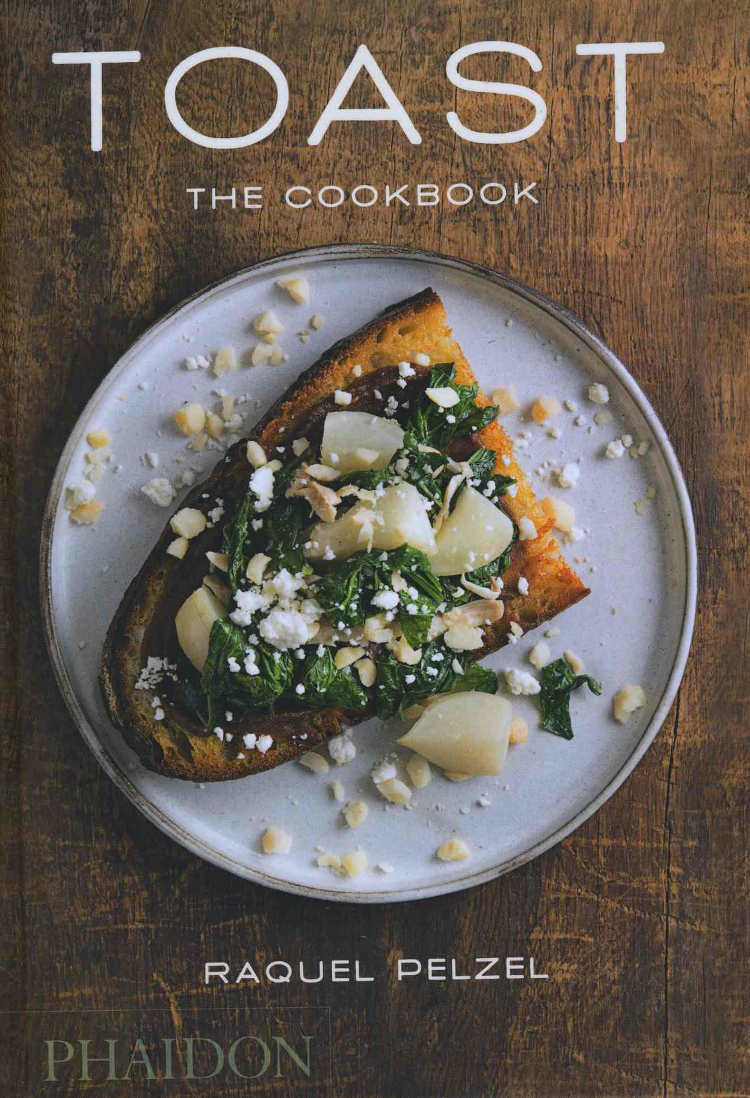 RECIPE: LENTIL, BACON AND CABBAGE TOAST
RECIPE: LENTIL, BACON AND CABBAGE TOAST
This tasty breakfast, lunch or supper dish is from TOAST by Racquel Pelzel (Phaidon Hardback; €19.95/£14.95/$24.95), a season-by-season cookbook offering dozens of different ideas for little somethings (and some more substantial dishes) that you can rustle up using a wide variety of bread types as the base.
“Lentils are a weekly staple in my house,” says Raquel, “They are inexpensive and packed with protein, fiber, and iron. Here, I use duck bacon (pork bacon works too) to give the meaty lentils an even heartier taste, but you could easily lose the bacon for a vegetarian-friendly meal (or use vegetarian bacon instead). Thin ruffles of cabbage lighten the overall dish—add a poached or fried egg to any leftovers and you have total breakfast bliss.”
Serves 4

LENTILS
2 tablespoons extra-virgin olive oil
5 slices (rashers) bacon (preferably duck bacon) thinly sliced crosswise
4 medium shallots, finely chopped
½ teaspoon freshly ground black pepper
2 medium garlic cloves, finely chopped
2 ½ cups thinly sliced green (white) cabbage (about 1/4 of a medium head) 1 1½ teaspoons finely chopped fresh thyme
1 teaspoon kosher (coarse) salt
3/4 cup (165 g) green French lentils (Puy lentils), rinsed
½ cup (120 ml) dry white wine
1 tablespoon (15g) unsalted butter
TOAST
Four ¾ inch (2 cm) thick slices country-style bread
Extra-virgin olive oil, for the bread, plus extra for serving
Kosher (coarse) salt, for the bread
2 scallions (spring onions), thinly sliced
1. Make the lentils: In a large, deep skillet (frying pan), heat the olive oil over medium heat. Add the bacon and cook until the fat is rendered and the bacon is crisp, 5-6 minutes. Using a slotted spoon, transfer it to a plate and set aside. Add the shallots and pepper to the skillet and cook until the shallots begin to soften, about 1 minute. Stir in the garlic and cook until it is fragrant, 30 seconds. Stir in the cabbage, thyme, and salt and cook, stirring occasionally, until the cabbage begins to stick to the pan, 7-8 minutes.
2. Stir in the lentils and wine. Increase the heat to high and simmer, stirring occasionally, until all of the wine is evaporated, 2-3 minutes. Add 1½ cups (355 ml) water and bring to a boil. Reduce the heat to medium-low, cover, and cook until the lentils are tender, about 50 minutes. Uncover and stir in the butter.
3. Make the toast: Toast the bread according to the instructions on pages 7-8. To serve, cover each piece of toast with lentils. Sprinkle the reserved bacon and scallions on top and drizzle with olive oil.
Leeks - In Season
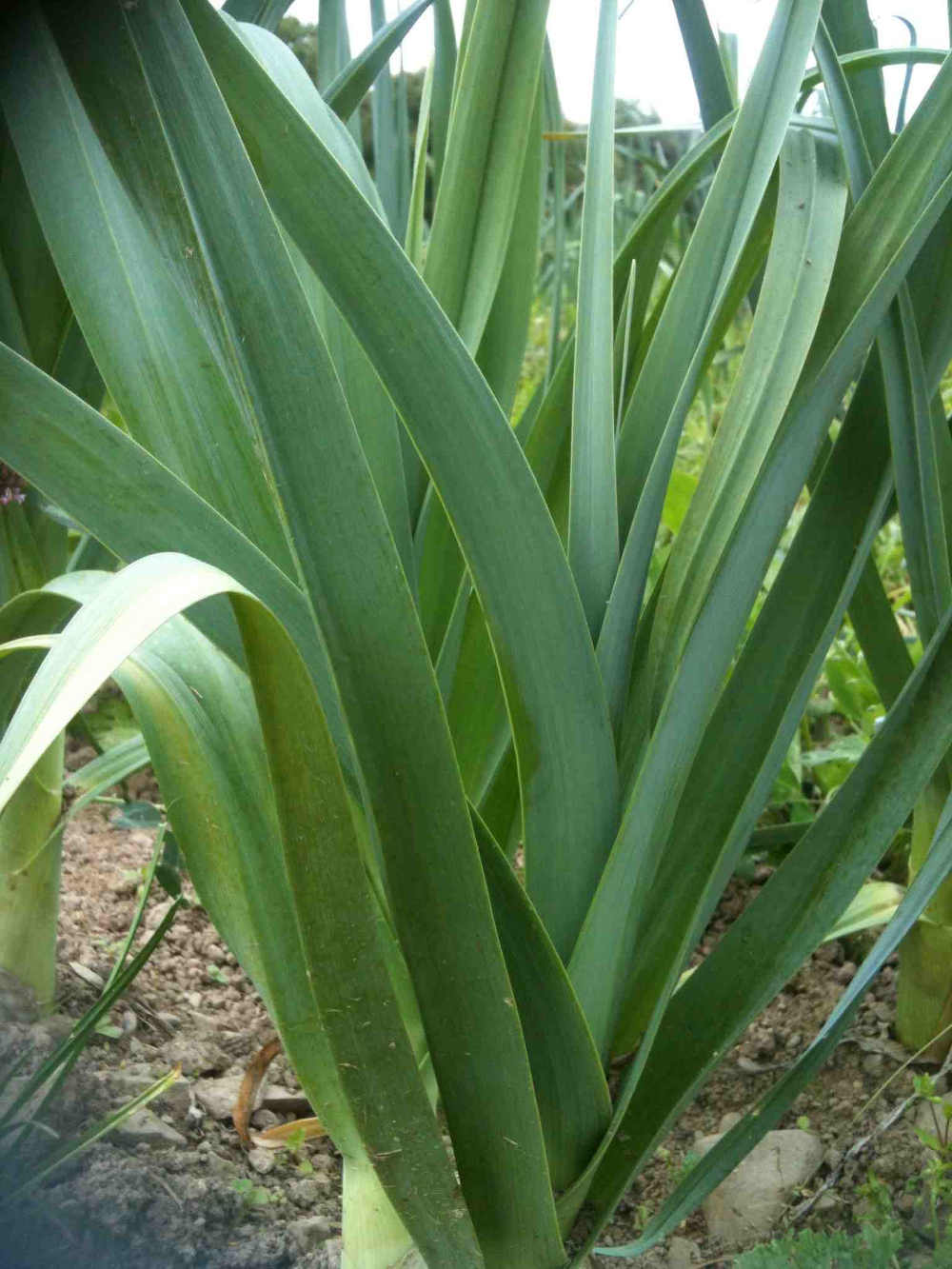
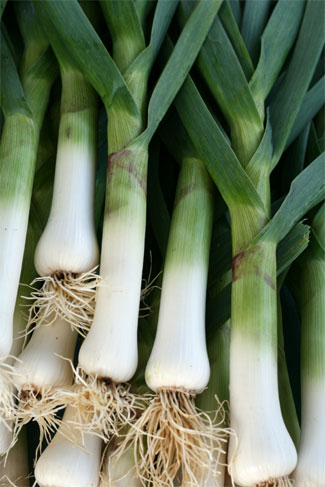 Georgina Campbell
Georgina Campbell
Although available all year round, leeks are at their best in winter and early spring and this versatile member of the allium (onion) family is a very useful garden crop as they are hardy and can be left in the round to harvest through the winter as required.
More like a big scallion (spring onion) than the bulbous onion, the flavour is mild and naturally sweet when cooked (only very young leeks are palatable raw). Leeks are a natural choice in cheese dishes, make excellent soups (simple potato & leek, for example, or classic cock-a-leekie), a wonderfully mellow addition to comforting dishes like lamb casserole (think lamb, barley, carrot and leek), also tarts and quiches - and, more surprisingly perhaps, leeks work well with fish (see below).
Deep fried leek can also make a pretty, crunchy garnish - and, of course, the leek is closely associated to Wales and St David’s Day (1st March). Although they need careful washing, as soil tends to lurk between the leaves, leeks are easy to prepare and - while many recipes deem it to be ‘correct’ to discard the green leaves - all except the coarsest outer leaves are perfectly edible and give welcome colour and character to many a dish.
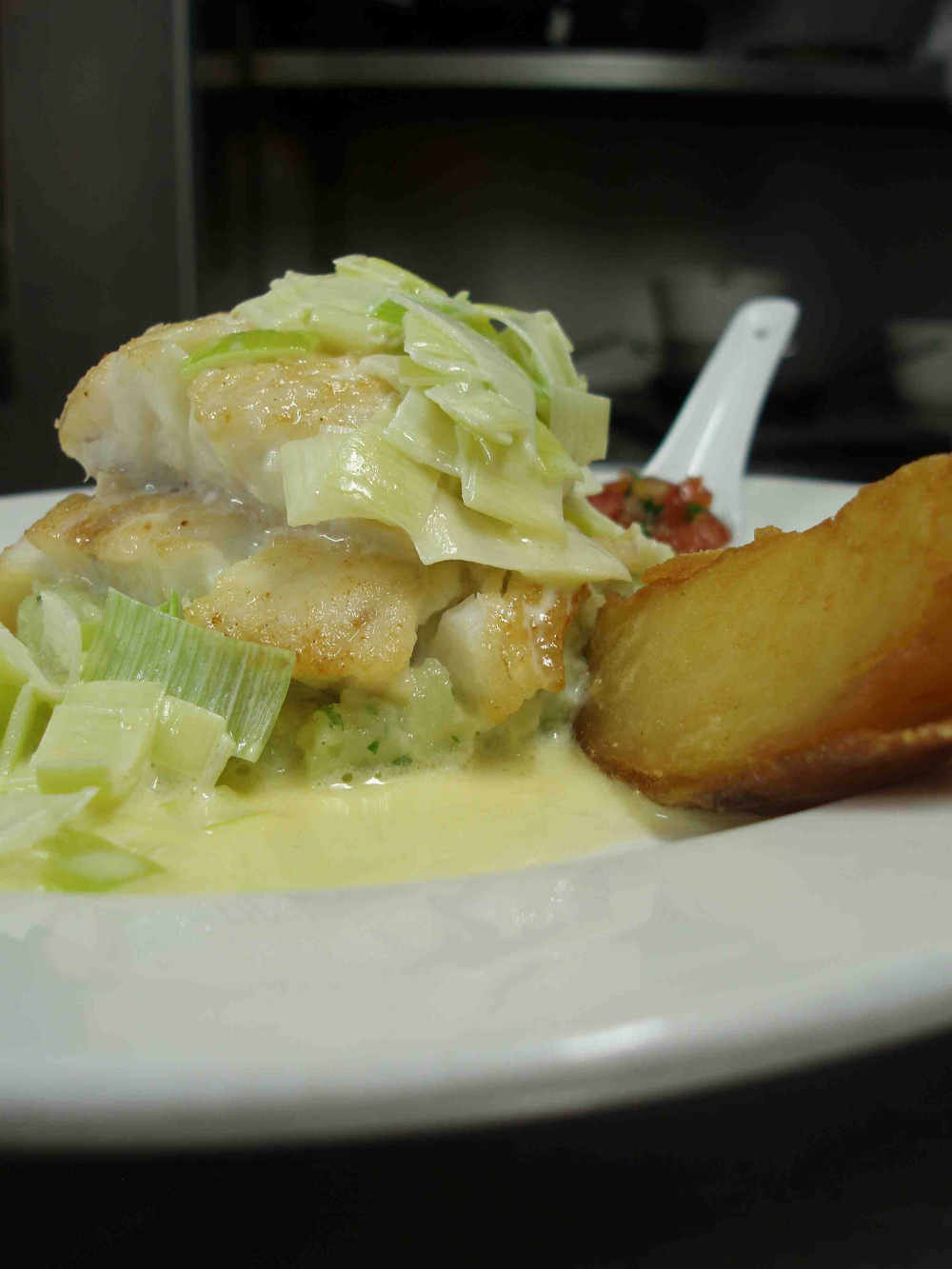 RECIPE: Roast Cod with Parsley Mash & Creamed Leeks
RECIPE: Roast Cod with Parsley Mash & Creamed Leeks
Martin Shanahan, chef-proprietor of what is probably Ireland’s most famous seafood restaurant, Fishy Fishy in Kinsale, never tires of championing the simplicity and speed of seafood cooking. This is a terrific timeless dish, and not just for the fish, but because the vegetables get equal billing - leeks partner well with fish, and this comforting combination is great for winter and early spring.
Serves 4
Parsley Potatoes
20g parsley (2 handfuls), chopped
¼ cup olive oil
8-10 potatoes
salt and pepper
Creamed leeks
300g leeks, finely sliced and washed
150 ml cream
20g butter
Roast cod
4 portions (approx 200g each) thickly-cut cod fillets
salt and pepper
2 tablespoons olive oil
First make the parsley mash: Mix the parsley and olive oil in a food processor, and process until you get a fine green purée. Boil the potatoes until just soft and mash with a potato masher. Whisk in the parsley purée with a fork. Season to taste.
To make the creamed leeks: place the cream and butter in a saucepan and boil to reduce. Add the finely sliced leeks and cook for just 30 seconds. Remove from the heat.
To roast the cod: preheat the oven to its maximum temperature. Use a frying pan that can go on the stove and into the oven. Place the pan on a high heat, and leave for 5 minutes until the pan is very hot.
Meanwhile, season the fish with salt and pepper. Add the olive oil to the pan, it should glisten and cover the base of the pan with a film of very hot oil. Place the fish onto this searing heat, and cook for 2-3 minutes. Place the whole pan in the oven for a further 2-3 minutes until the fish is milky white and firm to the touch.
To serve: place each portion of fish on top of a mound of potato, and spoon the leek sauce around it.
Variation: Other white fish such as haddock, hake or whiting can be used instead.
Wilkies Chocolate - In Season
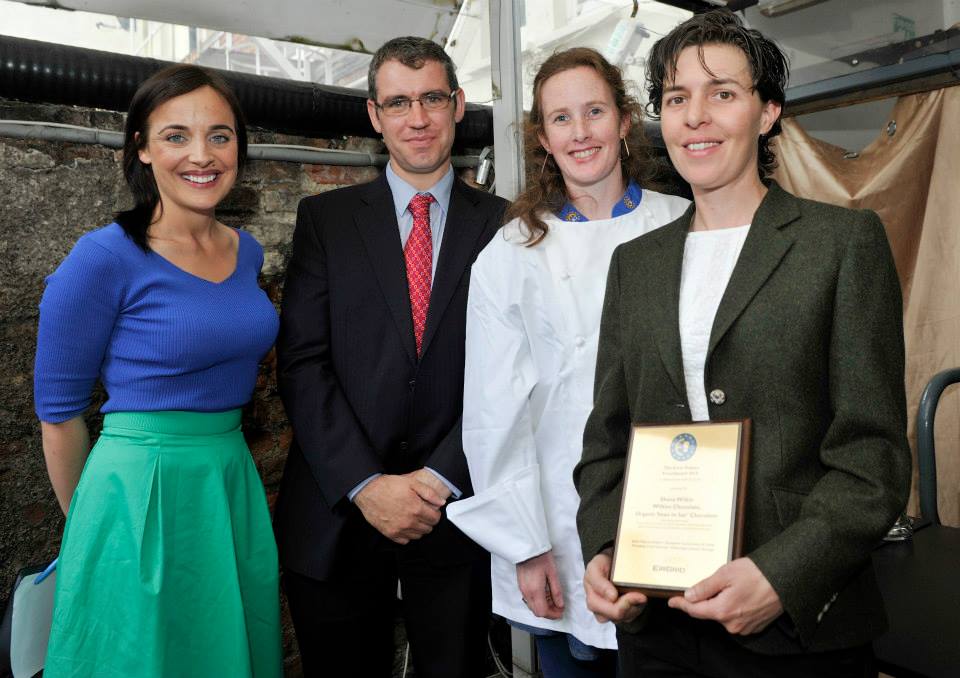
 Mention Easter and the first food association likely to come to mind is chocolate. It’s an all year favourite, of course, but it has seasonal peaks at Christmas, Valentines and, especially, Easter when we must get through mind boggling amount of eggs, bunnies and other chocolatey treats.
Mention Easter and the first food association likely to come to mind is chocolate. It’s an all year favourite, of course, but it has seasonal peaks at Christmas, Valentines and, especially, Easter when we must get through mind boggling amount of eggs, bunnies and other chocolatey treats.
The Irish obsession with chocolate is well documented - we’re the third biggest consumers in the world, on par with the UK and coming behind only Switzerland and Germany, arguably both countries where higher quality is likely to be the norm rather than restricted mainly to the artisan sector as it is here.
In fact, our most popular mainstream brands may not actually contain very much chocolate at all while, by contrast, artisan chocolatiers generally focus on quality and make products with a high percentage of cocoa solids. And some producers, like Shana Wilkie (who worked in Dublin newspapers in another life), go much further in aiming for the highest possible quality.
 Shana, a small batch organic chocolate maker now based in Midleton, Co Cork, was the first in Ireland to make ‘bean to bar’ chocolate and her meticulous commitment to quality has earned some high profile awards, including Bord Bia’s Best Organic Confectionery & Baked Goods Award 2012; one, two and three Gold Star winners across the range in the 2013 Great Taste Awards, and a Euro-Toques Food Award in 2015.
Shana, a small batch organic chocolate maker now based in Midleton, Co Cork, was the first in Ireland to make ‘bean to bar’ chocolate and her meticulous commitment to quality has earned some high profile awards, including Bord Bia’s Best Organic Confectionery & Baked Goods Award 2012; one, two and three Gold Star winners across the range in the 2013 Great Taste Awards, and a Euro-Toques Food Award in 2015.
Shana’s philosophy is more familiar in the world of tea and coffee than relating to chocolate. Wilkies Chocolate was the first chocolate maker in Ireland to import their own Single Origin Criollo beans from a local co-op in Peru, where Shana knows the farmers by name. And, like many other excellent products, pride is taken in using as few ingredients as possible: “We don't use any emulsifiers or add any flavours. This is because our beans are a rare delicacy and each type in farmed in a specific region, giving them a unique flavour that has been influenced by the climate and soil they were grown in.”
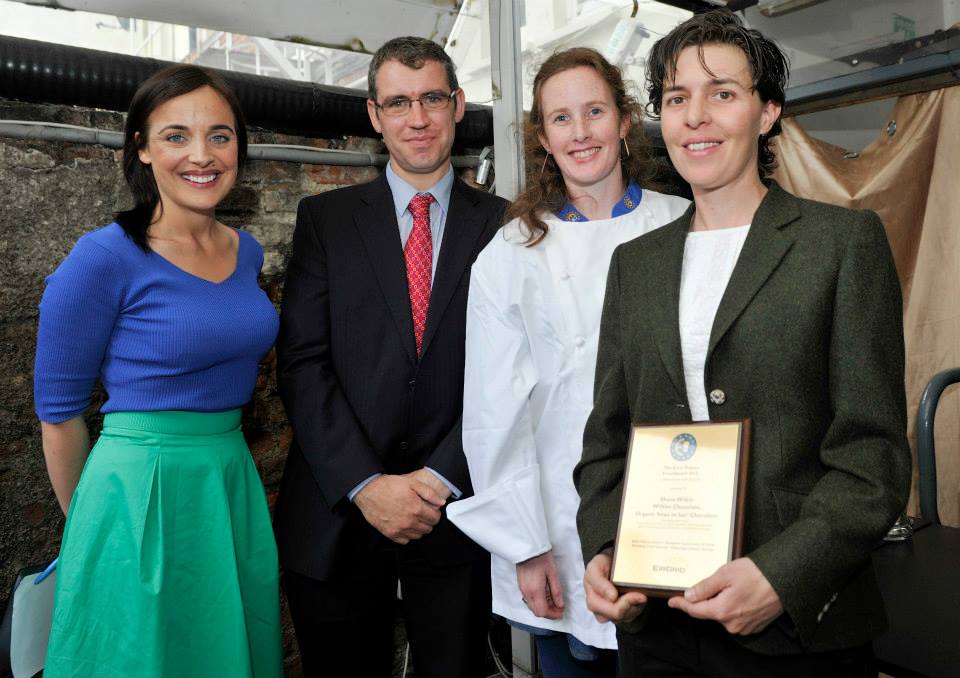 It is also an ethical process: “We care about our environment and the farmers who provide the quality crops we use. It is a priority for us to ethically source the finest organic Criollo Cocoa Beans, ensuring that the farmers receive a fair price for their cocoa. All of our ingredients are organic therefore, no synthetic pesticides or fertilizers are used in their production and the biodiversity that results from this type of farming is encouraged and preserved.”
It is also an ethical process: “We care about our environment and the farmers who provide the quality crops we use. It is a priority for us to ethically source the finest organic Criollo Cocoa Beans, ensuring that the farmers receive a fair price for their cocoa. All of our ingredients are organic therefore, no synthetic pesticides or fertilizers are used in their production and the biodiversity that results from this type of farming is encouraged and preserved.”
Wilkies Bean to Bar and Bean to Cup (organic hot chocolate) range is dairy, gluten, soy and nut free, and made with only three natural organic ingredients; cocoa beans, cocoa butter and cane sugar. The superior flavour texture speaks for itself and, according to Shana, “We promote natural ingredients because they contain a wide variety of compounds that your body uses to keep you active and healthy, while refined sugars and cocoa are mostly devoid of these healthy natural ingredients.”
Knowing all this - and there is plenty more to be learned from the workshops Shana often offers (at Ballymaloe Cookery School, for example) - the next step is to try it for yourself and taste the difference: “a chocolate experience like no other.”
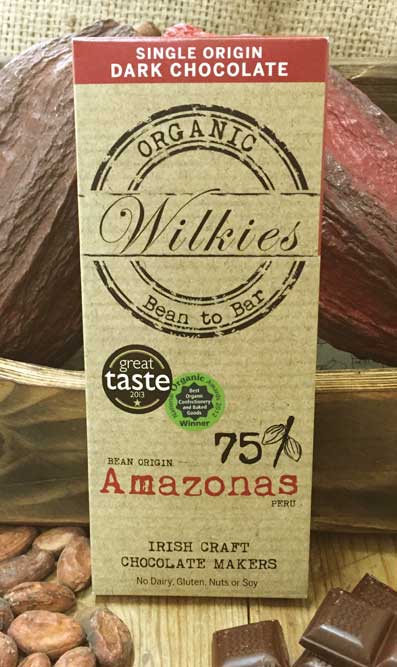 While best known for the bars - which are available in mini sizes (14g) as well as standard (65g) - Wilkies also produce cocoa and hot chocolate products, and a small but highly covetable gift selection of dark chocolates (salted caramel; kirsch; praline; coconut; mint; orange; coffee; plain; dark ganache) all available online, as well as from selected specialist outlets.
While best known for the bars - which are available in mini sizes (14g) as well as standard (65g) - Wilkies also produce cocoa and hot chocolate products, and a small but highly covetable gift selection of dark chocolates (salted caramel; kirsch; praline; coconut; mint; orange; coffee; plain; dark ganache) all available online, as well as from selected specialist outlets.
Wilkies Chocolate Limited
Address: Unit 6, Nordic Enterprise Park, Knockgriffin, Midleton, Co Cork
Web: www.wilkieschocolate.ie
Tel: +353 (0)87 699 6454
Milk - In Season
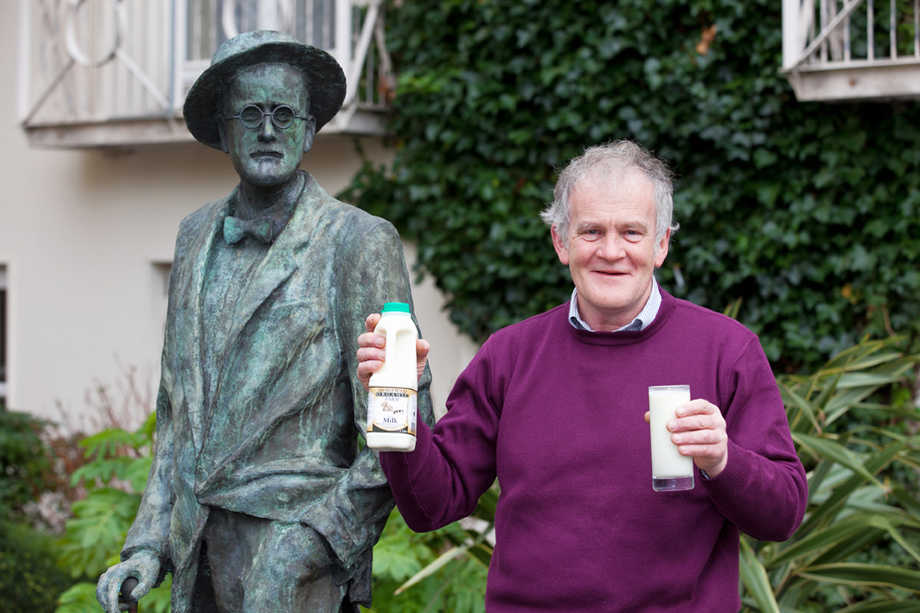

Georgina Campbell
To many it’s just a commodity, a bland white liquid with no character and no season, to be used without thought all year with breakfast cereals and tea - and the growing prevalence of industrial farming methods is reinforcing that impression.
But all milks are not created equal.
A quick glance at any cheese counter is enough to illustrate the point. All are made from milk, so how could a bland universal commodity be the starting point for the huge range and variety of cheeses on display?
Far from being a mere commodity, this magical liquid is infinite in its variety and has a natural season - which, in Ireland, is just beginning with the strong spring growth of our wonderful grass.

Long before potatoes arrived on the scene, or meats were a part of our daily meals, milk was the most important food in the early Irish diet and the basis for all of the curds and cheeses known as ‘white meats’.
Fast forward to today, and it’s obvious that our vibrant artisan cheese and speciality dairy sector has to be based on something special. This was something that focused the mind of food writer Catherine Cleary, when she was working with Kevin and Seamus Sheridan on their book ‘Counter Culture, The Sheridans Guide to Cheese’, stirring her to run the wonderful Appetite Talks at Dublin’s Smock Alley last autumn, an original and inspiring event that was all about cows’ milk.
On one extraordinary afternoon, Catherine brought together an impressive and diverse range of speakers - among them Robin Gill of The Dairy in Clapham, who spoke about his London restaurants and the appetite in London for high end dairy; dairy scientist Alan Kelly who explained the magic of milk; and Seamus Sheridan, who walked us through Fifteen Fields (you can read all about that in ‘Counter Culture’).

Quirky contributions came from historian Juliana Adelman (right), who entertainingly traced modern Irish history through cows, and Mánchan Magan who sprinkled his favourite lost Irish milk words into the mix throughout the event and picked people from the audience to ‘guard’ them so they wouldn’t be gone for ever.
And it was the first public outing for the delicious whey-based gin Bertha's Revenge, from Ballyvolane House in East Cork, which we got to taste before a unique ‘Five Corners Feast’ that was cooked by five of Ireland’s most innovative chefs from all around the island.
A small farewell goodie bag given to guests that evening included a gift of liquid white gold: packed in an unassuming plastic bottle was a litre of the beautiful Mossfield Organic Milk (www.mossfield.ie), produced in County Offaly by Ralph Haslam of Mossfield Organic Farm.
This gorgeous ‘single estate’ milk was among just four very special products recognised at the Irish Food Writers’ Guild Awards (www.irishfoodwritersguild.ie) this year, chosen for its traditional full flavour and rich, creamy texture. produced on the family farm at the foot of the Slieve Bloom Mountains, where the milk of 80 cows grazing on limestone pasture is also transformed into buttermilk, yoghurt, and the excellent Mossfield Cheese, which received an IFWG award in 2007.
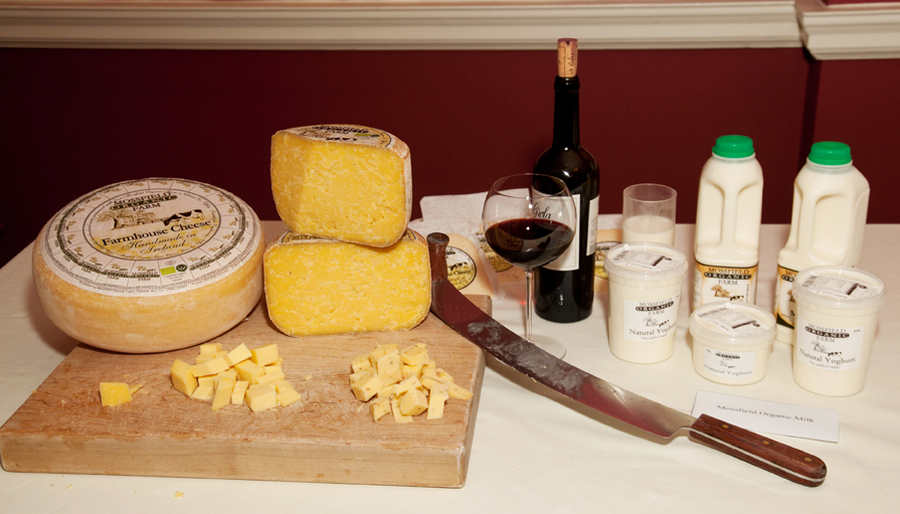
So what makes a milk like Mossfield stand out from the rest?
Perhaps it is simply down to TLC. In Ireland we are blessed with the perfect conditions for dairy production, but the best producers go the extra mile. Not only did Ralph convert to organic methods in 1999 (after three decades of conventional farming) but, today, he follows an ‘organic-plus’ system, reseeding individual fields with up to two dozen types of grasses and herbs depending on the soil’s requirements. This encourages exceptional biodiversity, promotes the health of both soil and animals and produces a particularly rich-flavoured milk. Simply magic.
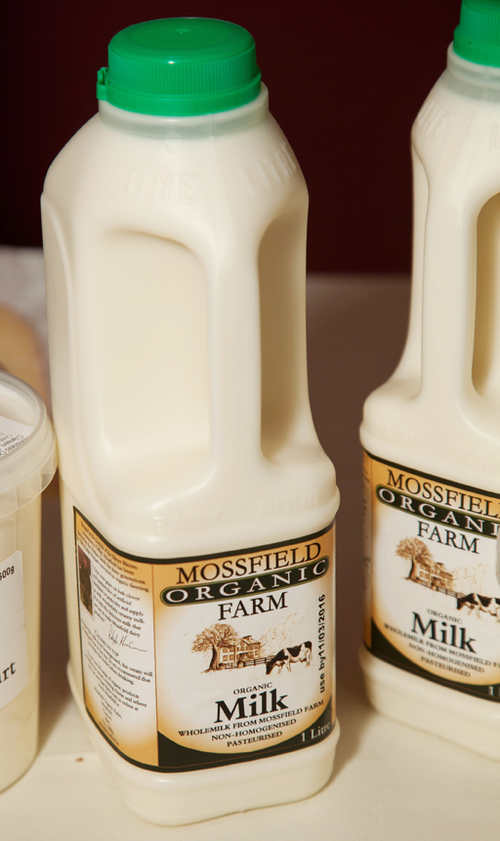 Importantly, this is a ‘single estate’ milk, the produce of one herd and not mixed up with the milk from countless other farms. Also, unlike most commercially available milk, Mossfield Organic Milk is not standardised (skimmed) or homogenised to increase shelf life or to prevent the cream from separating. Instead, it is simply pasteurised and distributed nationwide in as fresh and natural a state as possible.
Importantly, this is a ‘single estate’ milk, the produce of one herd and not mixed up with the milk from countless other farms. Also, unlike most commercially available milk, Mossfield Organic Milk is not standardised (skimmed) or homogenised to increase shelf life or to prevent the cream from separating. Instead, it is simply pasteurised and distributed nationwide in as fresh and natural a state as possible.
Taste this once and you will never see milk as a commodity again.
Comber Earlies - In Season
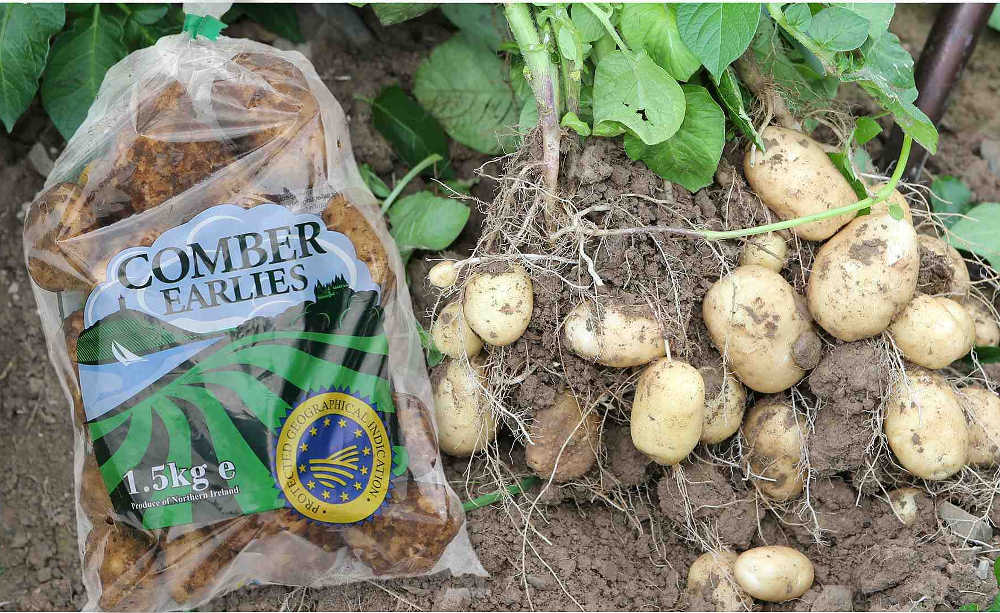
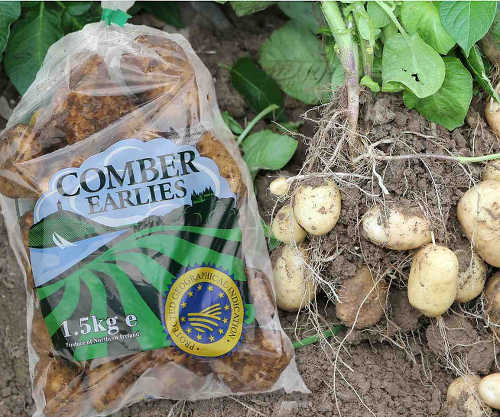
There’s nothing quite like the first early potatoes to remind us that summer is just around the corner. Everybody loves them and in Ireland we’re especially fortunate to have a unique growing area in County Down, with the ideal soil and its own microclimate providing the perfect growing conditions for this early season treat.
Grown by the Comber Earlies Growers Co-Operative Society Limited*, these potatoes are now known throughout Europe since being granted an EU PGI (Protected Designation of Origin) status in 2012, which puts them in the same league as some of the world’s most famous foods including Feta cheese, Melton Mowbray pork pies - and Jersey Royals, the renowned early potatoes from the Channel Islands.
Thanks to the EU PGI status, Comber Earlies can now compete with this long-established rival on something more like a level playing field. Also, because there are various conditions attached to the PGI status, authenticity is guaranteed and others risk prosecution if they try to trade unlawfully on its good name.
Only potatoes planted, grown and harvested within the protected geographical indicated area can be marketed as Comber Earlies, and only potatoes harvested in May, June and July are eligible for the status.
There is no actual variety called Comber - varieties grown include Home Guard, Dunluce, Accord, and Casa Blanca - the name refers to the general geographical area where the potatoes are grown.
The exceptional soil and climate found in the PGI area allows the farmers to grow this unique potato. Protection offered by the Ards Peninsula to the East and the Mourne Mountains to the South along with the South/ East location mean that the micro climate of the designated area is both warmer and drier than other parts of Northern Ireland. The area receives the greatest amount of sunshine, and has the longest mean growing season of any part of the province.
These unique characteristics of soil, climate and topography all work together to produce these fantastic potatoes with their earthy, sweet and nutty flavour- the much awaited taste of summer.
*The group of 12 representing the growers are: Richard Orr, Hugh Chambers, Stephen Christie, Trevor Davidson, Stephen Donnan, Ian Gilliland, Nathan Gilmore, Harry Hamilton, Garth Horner, Andrew Herron, Ivan McKee and John Hamilton. Together, the farmers in the designated area grow, pack and market their delicious Comber Earlies Potatoes.
RECIPE:
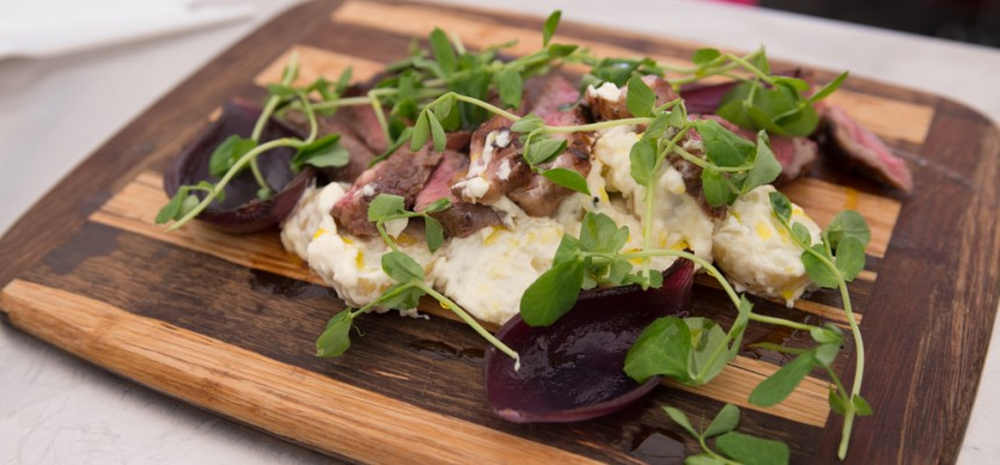 Peter Hannan’s Himalayan Salt Aged Sirloin With Warm Comber Early Potato, Scallion & Horseradish Salad.
Peter Hannan’s Himalayan Salt Aged Sirloin With Warm Comber Early Potato, Scallion & Horseradish Salad.
This simple dish takes just 15-20 minutes to prepare. Aside from the potatoes, County Down is the star here - the beef comes from The Meat Merchant in Moira and the recipe was created for the Comber Early Potato Festival 2014 by Danny Millar, executive head chef of Balloo House, The Parson’s Nose and The Poacher’s Pocket, all in County Down.
Serves 4.
2 x 12oz Peter Hannan’s salt aged sirloins
500g Comber Early potatoes, cooked and kept warm
1 bunch scallions
6 tablespoons good mayonnaise
1 tablespoon good horseradish
1 bag watercress
1 x pickled red onion
1. Season the sirloins on both sides and cook on a hot pan for 2 minutes on each side (for rare) and then leave to rest.
2. Mix mayonnaise and horseradish together and combine with the sliced Comber potatoes and scallions.
3. Check seasoning and place on serving plate.
4. Slice steak and place around potato salad. Drizzle over any juices from the steak
5. Garnish with watercress and pickled red onion
Garlic Scapes - In Season

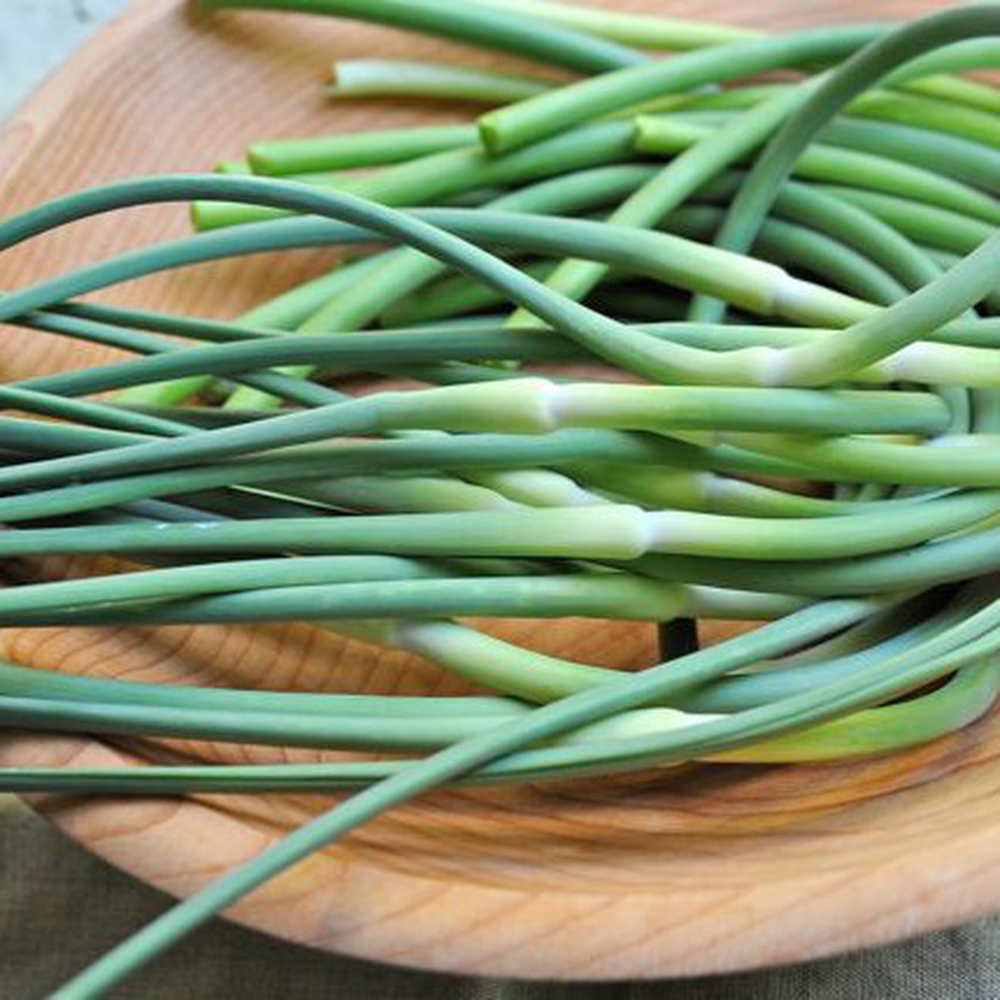
Georgina Campbell
It’s fair to say that garlic scapes are a pretty new concept to most Irish cooks, but they came to everyone’s attention in a big way when they famously featured on Donal and Sofie Skehan’s wedding menu in June 2015 - when, in the gorgeous country setting of Lisnavagh House, Co Carlow, the caterers (Jenni Glasgow and Reuven Diaz of Drogheda’s brilliant Eastern Seaboard) included scapes from Drummond House Farm, Co Louth, in two of the dishes served.
Garlic scapes are a bit like asparagus spears and, like asparagus, the season is short, lasting just a few weeks from late May into June.
All of the many varieties of garlic can be divided into two categories, softneck and hardneck. The strongly flavoured softneck garlic is the most familiar type, and it keeps well. Hardneck varieties grow better in northern areas and send up a strong central stalk in summer; they have a milder flavour than softneck varieties and are best used fresh.
Scapes are the flower stalks of hardneck garlic plants and elephant garlic, which is actually a variant of the leek although it looks like a very large garlic; it has an exceptionally mild garlicky flavour which makes it ideal for using raw in salads.
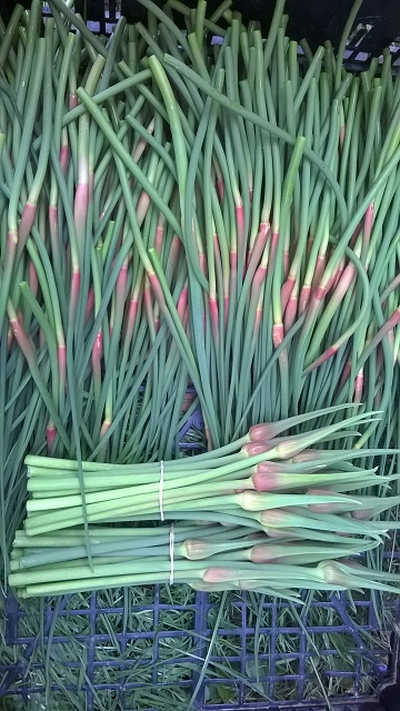
To prevent the plants wasting energy that should be going into bulb production, it is necessary to remove the flower stalks from hardneck garlic in early summer, and this provide a secondary product that can be used in cooking - scapes are ideal for pestos (see below) or garlic scape dressing, for example, and also delicious when deep fried, used in stir fries and barbecues, or to flavour butter.
Garlic is grown on a small scale by producers all over the country and will often be seen at farmers’ markets and speciality food stores in season.
However, as prices for mainstream vegetables are falling to a level that make it unsustainable for farmers to grow them, many enterprising growers are focusing instead on speciality crops, including garlic, that replace imports and can command a premium price. There are now at least two commercial producers specialising in garlic, and growing a wide range of varieties:
• West Cork Garlic, Coolmountain West, Dunmanway, Co Cork Bryn Perrin grows a wide range of varieties and offers elephant garlic scapes and a number of other products - including green (fresh) garlic, dried garlic and garlic bulbs for planting - online. Also from Bradley's Off Licence (www.bradleysofflicence.ie) in Cork and local shops including Urru in Skibbereen, Scallys Supervalu Clonakilty and Manning's Emporium, Ballylickey (www.manningsemporium.ie) West Cork Garlic is also sold at Bantry and Skibbereen farmers’ markets.
• Drummond House, Baltry, Co Louth. Peter and Marita Collier grow ten varieties, including elephant garlic, and supply Honest2Goodness Market and Lotts & Co Grocery (www.lottsandco.ie) in Dublin, in addition to a number of local shops.
RECIPE:
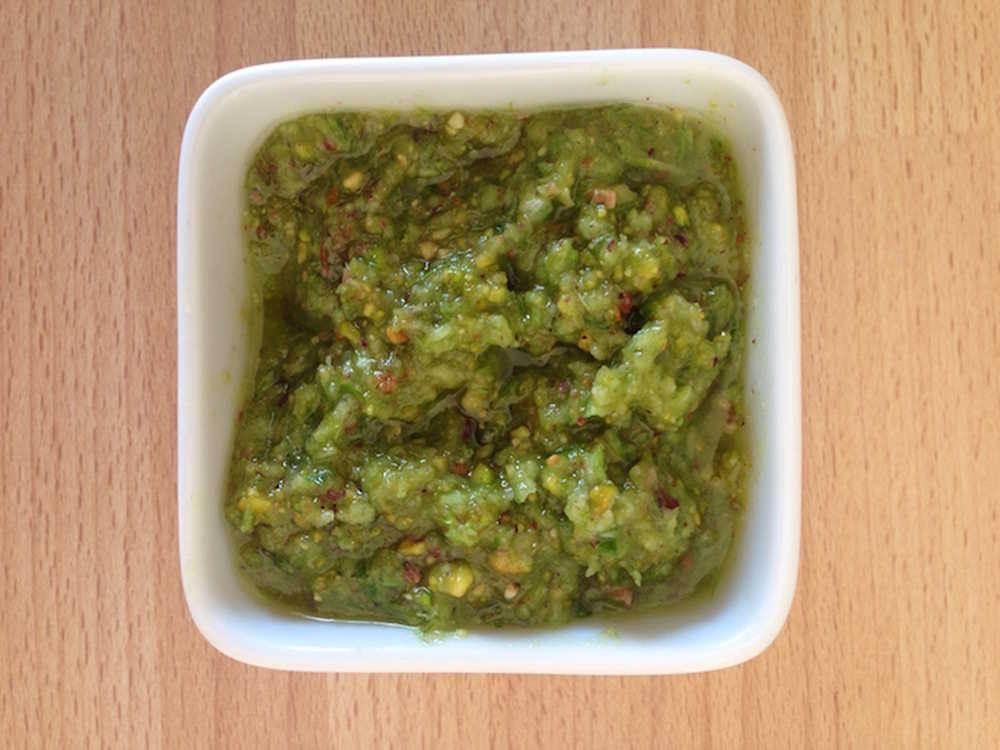 Drummond Farm Garlic Scape Pesto
Drummond Farm Garlic Scape Pesto
“Once a year we have the pleasure of being able to enjoy garlic scapes, a part of the garlic that many people sometimes discard before harvesting. But the scapes are an extremely flavourful part of the plant that can be used in salads, eaten whole or pickled. They’re also great for making this authentic garlic scape pesto. Here’s our recipe for homemade pesto which you can use as a dip with bread or as a sauce with pasta.”
You will need:
10 large garlic scapes
1/3 cup of pistachio nuts
1/3 cup of finely grated parmesan cheese
1/3 cup of extra-virgin olive oil
Black ground pepper and salt
Method:
Cut the ends off the scapes and then cut them again into 2 inch/5cm pieces.
Place them into a blender with the pistachio nuts and Parmesan and blend until they are finely chopped.
Turn the blender back on, on a slow speed and add the olive oil.
Once the ingredients are evenly blended add salt and pepper to taste and then serve in a bowl.
The pesto will keep in a fridge covered for a week, or frozen for a month.
Second Early Potatoes - In Season
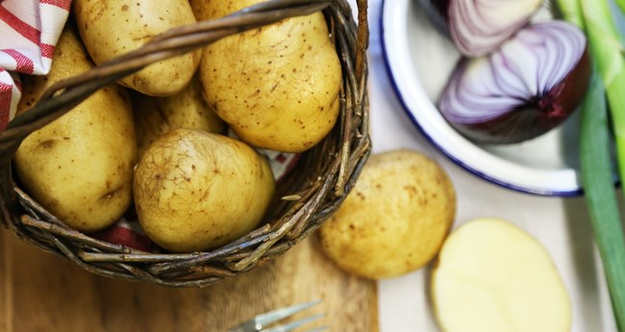
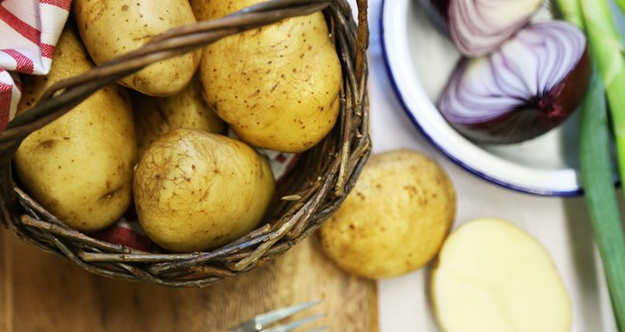
The first new potatoes are always a joy but, long after the first earlies have had their moment, other varieties are coming on stream. Since potatoes are available all year, it’s easy to forget that they all have a new season and in late summer that means the second earlies - especially Queens, in all their variations: Dublin Queens, Rush Queens or just plain Queens...they’re all ‘British Queens’ going local.
And they’re all equally delicious, although the popularity of foods like rice and pasta means we’re not eating them as often as we used to - hence the EU funded campaign run by Bord Bia Potatoes: More Than A Bit On The Side (www.potato.ie), which supports Irish (and British) growers and aims to educate us about our ‘national vegetable’.
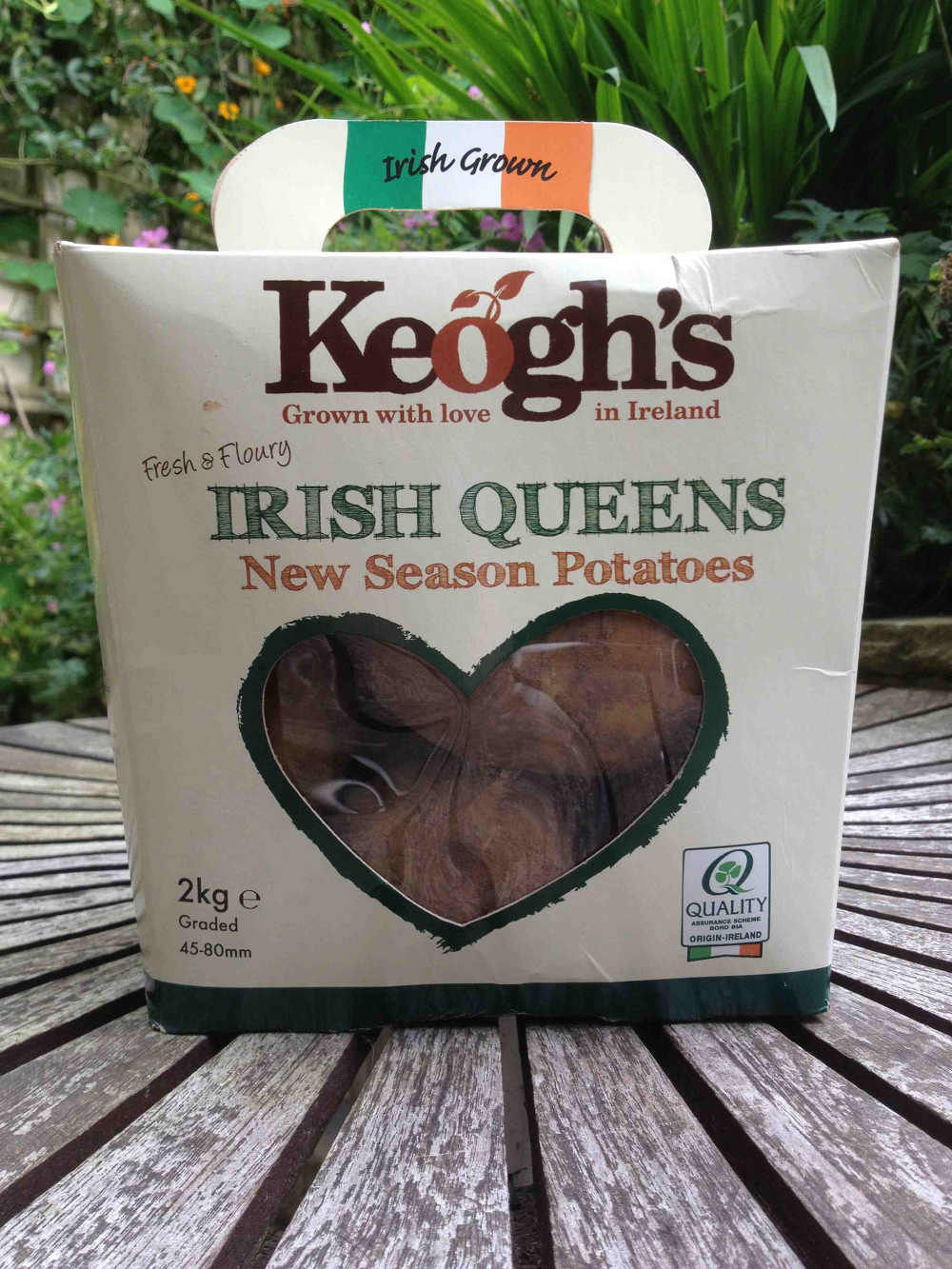 The promotional campaign is focusing on younger consumers and is highlighting health and nutritional benefits plus the fact that potatoes offer enormous potential ‘within the world of modern cooking’.
The promotional campaign is focusing on younger consumers and is highlighting health and nutritional benefits plus the fact that potatoes offer enormous potential ‘within the world of modern cooking’.
TV nutritional expert and dietitian, Aoife Hearne, an ambassador for the campaign comments: "When it comes to trying to eat healthily, being organised and prepared is half the battle, particularly when people are time-poor and looking for a convenient fix in an evening meal. I'd advise people to cook ahead, preparing meals at the weekend that can last into the week for lunch or dinner. Having labour saving kitchen equipment such as microwaves, slow cookers and air fryers can speed up and simplify meals too.
Potatoes are great for this and are a very important source of carbohydrates, which are essential for our bodies and particularly for brain function. Potatoes are naturally fat and gluten free, a great source of fibre, Vitamin C and a variety of B vitamins. They also contain three times more potassium than bananas.”
A dedicated website www.potato.ie provides masses of information, including details of the main varieties grown in Ireland and their season/availability (http://www.potato.ie/varieties/) and wide range of recipes.
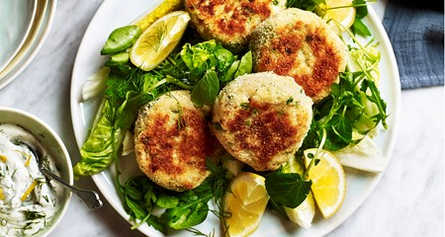 This easy recipe for COD & POTATO CAKES WITH MELTED CHEDDAR CENTRE calls for a floury potato, so the second early Queens (in season July and August) would be a good choice, and it has particularly good flavour. Roosters - the great all-rounder - are also coming into season from this month. The recipes on potato.ie give a lot of information including a per serving breakdown of energy (calories), fats, sugars, salt etc - as well as the all important preparation and cooking time.
This easy recipe for COD & POTATO CAKES WITH MELTED CHEDDAR CENTRE calls for a floury potato, so the second early Queens (in season July and August) would be a good choice, and it has particularly good flavour. Roosters - the great all-rounder - are also coming into season from this month. The recipes on potato.ie give a lot of information including a per serving breakdown of energy (calories), fats, sugars, salt etc - as well as the all important preparation and cooking time.
Serves 2:
Ingredients
150g floury potatoes, such as Roosters, peeled and cubed
20g frozen peas
8oz cod, skinned and roughly chopped
1 tsp chopped parsley
40g full fat hard cheese, (such as cheddar), cut into 4 cubes
2 tbsp sunflower oil for frying
1 egg beaten
20g plain flour
20g coarse breadcrumbs
Method
Place the potatoes into a pan of cold water, salt lightly and bring to the boil; cook for about 7-8 minutes or until tender.
In a microwavable bowl, cover the chopped cod and peas with cling film, cook for 3 minutes and drain.
In a mixing bowl lightly mix the potato, cod, peas and parsley, season with a little salt and pepper.
Divide the mixture into 4 balls.
Take a ball in the palm of your hand and press a cube of cheese into the centre. Form back into a ball trying to keep the cheese in the centre and encased in the potato. Flatten out into a fishcake shape. Ideally chill for 20 minutes.
Place the flour, beaten egg and breadcrumbs into three separate bowls. Cover the fishcakes in the flour, roll in the egg and toss in the breadcrumbs. Pat gently and reshape if needed.
Fry the fishcakes in the sunflower oil over a medium heat for about 5 minutes on each side, turning every so often. Serve with a crisp side salad or your favourite vegetables.
Irish Onions - In Season
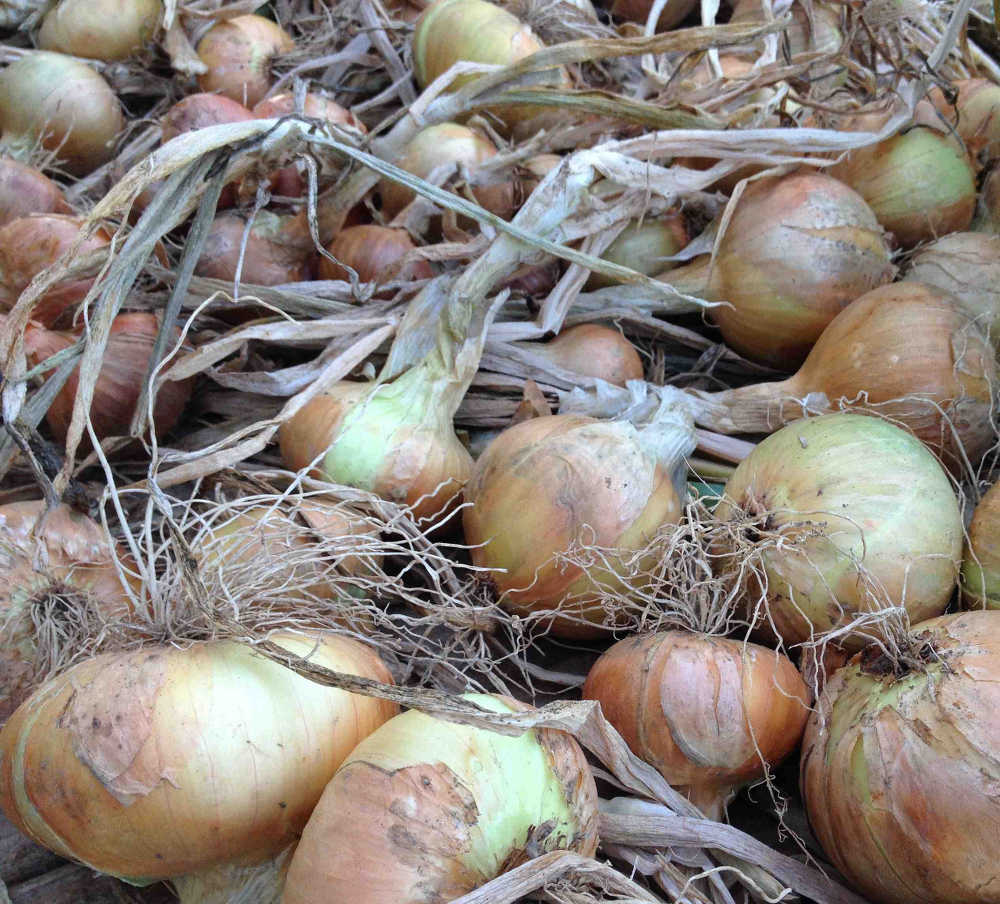
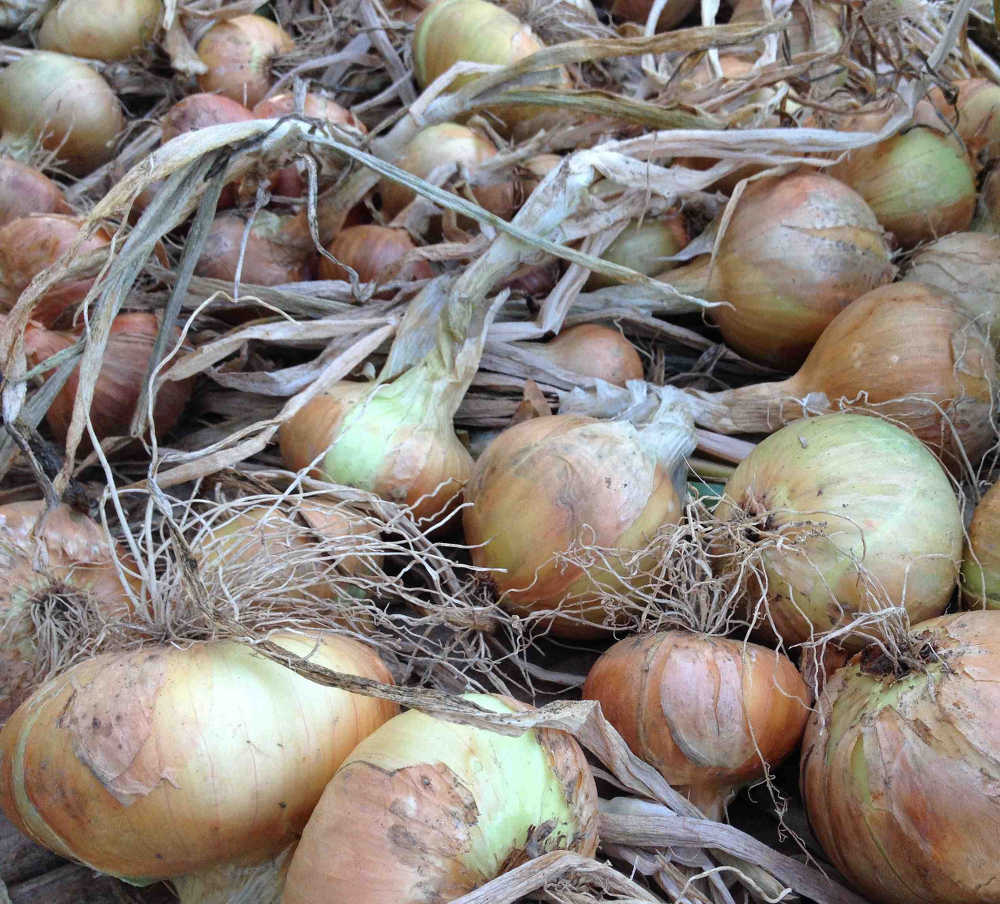
Traditionally known as ‘the poor man’s meat’ onions (allium) are perhaps an undervalued item in our shopping baskets, but indispensable in the kitchen and very nutritious. Irish onions are not seen on supermarket shelves as often as they should be, but they’re coming into season now and should be easily available in shops and markets, so pounce on them when you spot them.
There are only a couple of commercial onion growers in Ireland - Country Crest, at Lusk in north Co Dublin, and the Miller family at Limavady, Co Derry - and they are able to supply for about nine moths of the year, then top up with imports to fill the gap.But many smaller growers sell new season produce through farm shops/farm gate sales and supply local shops with small quantities, so it’s worth keeping an eye out for them at this time of year.
As well as the very familiar salad onions, scallions (spring onions), which are available all year, quite a wide range of varieties are grown in Ireland, from shallots (small, but prized by chefs for their mild sweet flavour) to brown (full-flavoured, richly coloured, versatile); red (mild flavoured and colourful, good raw or cooked) and white onions (usually strongly flavoured, less often seen) of various sizes.
Being very low in saturated fat, cholesterol and sodium, and high in dietary fibre, vitamins - B6, B9 (folate) and, especially, Vitamin C - also minerals including potassium and manganese, onions are an obvious choice as a healthy food. Better still, they’re not only delicious on their own, but this versatile vegetable brings out the best in a wide range of other foods and is the secret ingredient in more dishes than you could ever imagine.
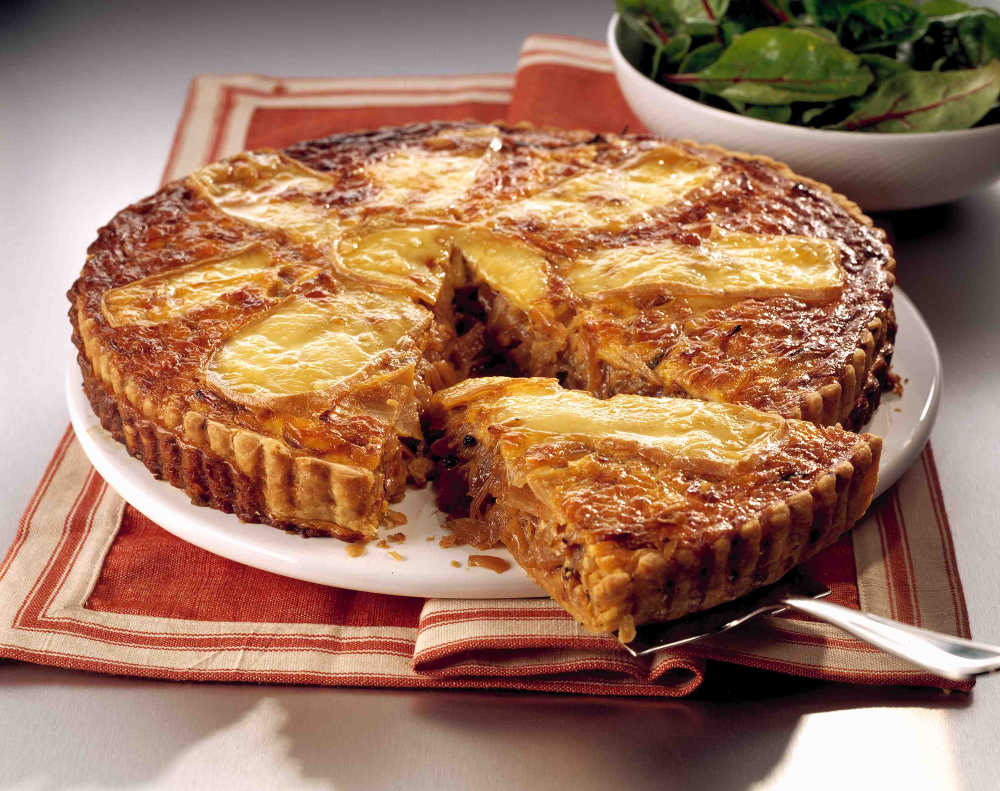
RECIPE: Caramelised Onion and Gubbeen Cheese Tart
This delicious tart is made with the wonderful Gubbeen cheese, produced on the Ferguson family’s near Schull in West Cork (http://www.gubbeen.com/), but another good cheese that melts well could be used instead. It can be made ahead and involves very little shopping
Serves 6-8
Pastry
250g plain flour
Pinch of cayenne pepper
½ teasp. salt
15g butter, chopped
2 egg yolks, mixed with 1-2 tablesp. iced water
Filling
2 tablesp. olive oil
Good knob of butter
4-5 large onions, thinly sliced
Salt and black pepper
4 egg yolks
125ml-250ml cream
1 tablesp. freshly grated hard cheese
Pinch of nutmeg
50g Gubbeen cheese, thinly sliced
To make pastry: Whizz the flour, cayenne and salt in the processor. Add the butter and whizz again until it resembles breadcrumbs. Mix in the egg and water. Gather up the pastry and leave in the fridge for an hour to chill.
To make the filling: Heat a large pan with the olive oil and butter. Saute the onions gently until golden brown and caramelising. This takes about 20 minutes. Season and set aside.
To bake: Set the oven to Gas Mark 4, 180ºC, (350ºF) and slide in a baking sheet to heat.
Roll out the pastry to line a 28cm diameter x 3cm deep tart tin. Chill for 10 minutes.
Put a few balls of crumbled foil in the base of the pastry case and bake for 10 minutes. Remove foil and bake for a further five minutes. Spread the onions over the base of the tart case. Beat the eggs, cream, grated cheese and nutmeg together. Pour the mixture over the onions, place the sliced Gubbeen on top and bake the tart on the baking sheet for 45-50 minutes until firm and golden.
Delicious with a fresh green side salad and tomatoes.
Country Wine Making - In Season


by Hans Wieland
I still remember that Easter Day 1985 when we looked at that cottage in the wilds of Leitrim, near Manorhamilton, climbed through the window and stood in a damp, deserted living room full of books. The one that fell into my hand was “First Steps in Winemaking” by C.J.J.Berry. (What a name!) The rest is history as they say.
Making your own wine is probably one of the most satisfying ways of preserving the produce of your garden and the surrounding hedgerows. With a bit of patience it is easy to achieve and can become a highly economical pastime.
Buying wine in Ireland is still pretty expensive compared to buying wine on the continent and a lot of seasoned home wine makers ‘swear’ on the quality of their home produced ‘country wines’ as they call them.
A country wine is any wine not made from grapes, be it fruit, flowers, vegetables or grain. Many people consider the only true wine to be made from grapes due to its undoubted full flavour and near perfect balance of ingredients for fermentation, but popular fruit wines are made from apples, gooseberries, plums, elderberries and sloe. Elderberry for example makes an excellent wine when blended with apple, sloe, damsons or even banana.
All wines require a good balance of acids for fermentation and tannin to clarify and giving it zest.
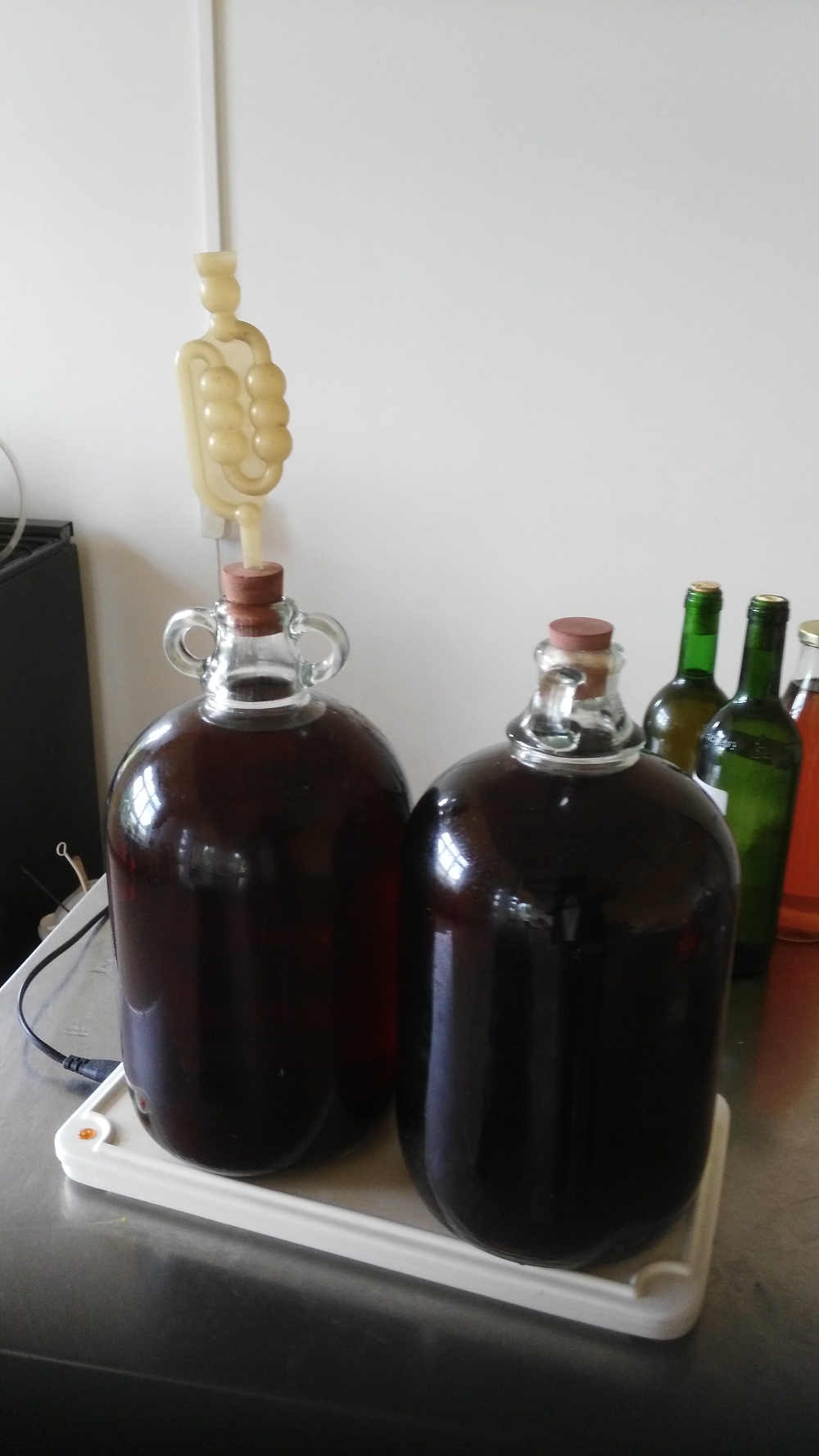
Basis requirements to make wine
The four essential ingredients are yeast, sugar, flavour and water.
Sometimes it is necessary to add enzymes to aid the clearing of the wine from excessive pectin, starch or protein.
Yeast is the most important ingredient. It is a living organism and is responsible for the fermentation process. There are many specialist wine yeasts available. Put the yeast in a sugary solution and it begins to multiply vigorously, turning approximately half of the sugar into alcohol and the rest to carbon dioxide. Plain white sugar is actually better than brown and more natural sugars, because the latter add an unwanted and distracting flavour to the wine. Organic people have to compromise here!
Fermentation
The fermentation takes place in two stages:
First the aerobic stage (with air), when sugar and yeast are added to “must” or the pulp of the basic ingredient (fruits, vegetables, grains) in a plastic bucket and covered with a muslin. This fermentation needs about 10 days at a temperature of around 21 degrees Celsius (Good room temperature).
The second stage takes place without air; this is the anaerobic stage, which needs a lower temperature of about 16 degrees Celsius. At this stage you need a bit of special equipment like a demijohn or fermentation jar and an airlock. It is important that a steady temperature throughout fermentation is maintained. A slow, quiet second fermentation usually makes a better wine than a fast and vigorous one.
During the second fermentation the use of an airlock is necessary, which both cuts off air supply to the yeast and allows carbon dioxide out ; it prevents the invasion of other bacteria which spoils the wine and turns it into vinegar. Fermentation continues until all sugars have been digested by the yeast bacteria. The alcohol level has then reached around 15%, which prevents any more yeast activity.
Before you can bottle and store you must siphon off the wine from the deposited solids. This process is called racking and can be repeated 2 months later. After some 5 months the clear wine can be bottled.
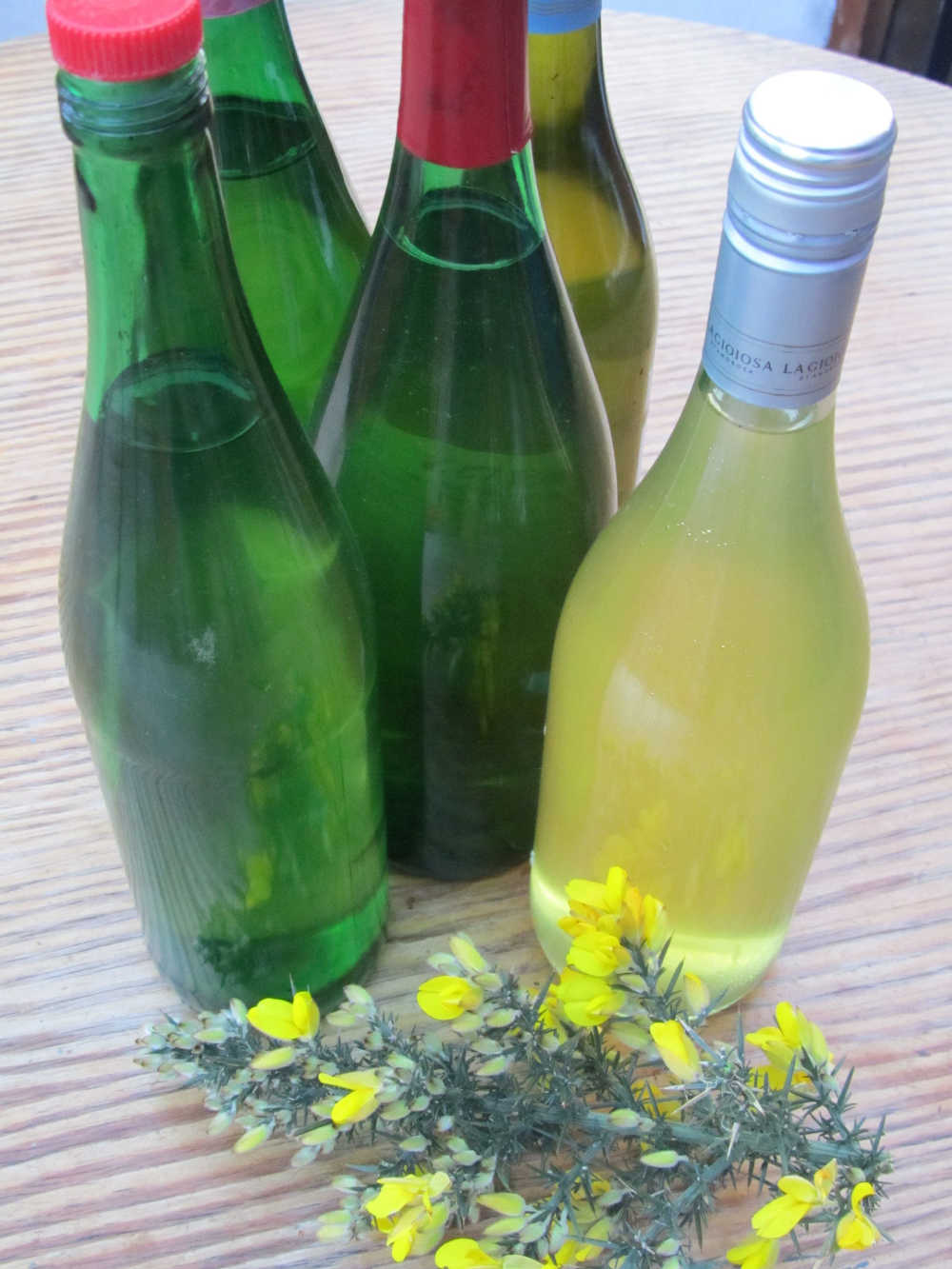
RECIPE:
Here is a simple recipe that I first tried using windfalls.
Apple Wine:
Ingredients:
2.75 kg of apples
4.5 litres of water
1 kg of sugar
Juice and thinly peeled rind of 1 lemon
150 mls of white concentrate
1 teaspoon of citric acid
yeast and yeast nutrient
Method:
Wash and cut up the apples, skins, brown patches and all.
Simmer 10 -15 minutes in 4.5 litres of water.
Strain liquid on to the sugar and the thinly peeled rind of lemon. Stir well.
When lukewarm add the juice of the lemon, the yeast and the yeast nutrient to the liquid; add the concentrate, cover and leave for 24 hours in a warm place, then pour into a fermenting jar and insert air lock.
Leave in a warm, dry place to ferment for 4 weeks.
Siphon off into a clean dry storage jar and ferment out under air lock.
Then siphon off and mature for 6 month before bottling.
---
Hans Wieland, moved from Germany with his wife Gaby and their young family in 1985 and they now live in Cliffony, Co Sligo. He was an organic cheese maker for 20 years, loves gardening and is an expert in storing and preserving. He has worked and taught at The Organic Centre, Rossinver, Co. Leitrim since 1997. Wine and cider making are among the topics covered in classes at The Organic Centre
Wicklow Fine Wines - In Season


Aoife Carrigy meets two pioneers who are producing fine Irish fruit wine. Their new elderberry and blackberry flavour, launched in October, is based on wild elderberries foraged in the Wicklow Mountains during autumn 2015; blended with luscious Irish blackberries, it’s a perfect match for autumn and winter food.
“The stuff is absolutely screaming out the door,” says US expat Brett Stephenson, co-founder of Wicklow Way Wines with his Dublin-born wife Pamela Walsh. “I can’t really label it fast enough.”
Success has come fast for their Móinéir Fine Fruit Wine. The couple launched their flagship strawberry wine at Bloom 2016 on a gloriously sunny June bank holiday weekend. They knew they had something “unique and really good”, admits Pamela, “but that doesn’t mean we weren’t terrified. We had invested so much at that point and it was such a new category.”
The response has been overwhelmingly positive, with a growing number of independent wine merchants and top gastronomic restaurants such as Chapter One and The Greenhouse keen to list this unique Irish wine. And when I visit the pair of pioneers less than four weeks after Bloom in their
Newtownmountkennedy winery, they are packing up their first shipment for London’s Fortnum & Mason.
That’s quite a journey for those Irish strawberries, which started life in Pat Clarke’s fruit farm on the Dublin-Meath border and made their way into the elegant Riesling-style bottles, at over 100 strawberries per bottle, by way of Brett’s tinkering about with the tools of his new trade: the bladder press that gently crushes the fruit, the small-batch 320 litre tanks in which the wine is macerated for four days and fermented for another week, and the larger storage tanks in which it is matured and blended before being bottled and boxed up on-site. That all this happens by hand – from the picking of the fruit to the air-bagging of the bottles – makes it all the more remarkable to think of those bottles navigating through Picadilly traffic and onto the shelves of Fortnum & Mason just in time to be taken home and chilled ahead of last season’s Wimbledon finals.
It’s been quite the journey for Brett and Pamela too. While a lot has happened since the launch, Móinéir has been years in the making. “It took a year to get the wine out,” Brett says, but that’s not counting finding the right space for the winery, or registering the business, or untangling the challenges of creating an unprecedented commercial category. “It’s a huge undertaking.”
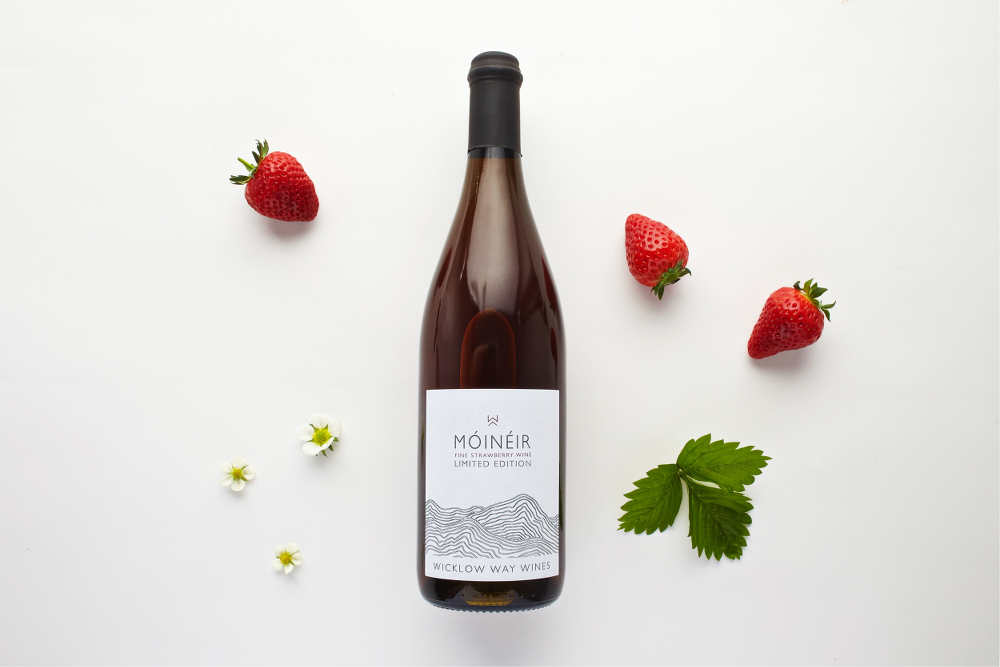
As for the research and development, that began back in the 1990s when the couple were living in California where they became “hobbyist” wine-makers. “That’s how we got into this,” Brett says. “Years of trying it out and getting better and better.”
An electrical engineer by training, Pamela worked in Silicon Valley, while Brett worked as a sound engineer in San Francisco. “I got to work with my heroes… Tom Waits, Grateful Dead, Jefferson Airplane, Santana.” But in early 2000, with two young kids in tow (Shane and Celina, now 21 and 18 respectively) they decided that they wanted “to work to live rather than the other way around” and moved back to Dublin.
Committed to Californian-fostered ideals of sustainability, Pamela landed a job with Airtricity where she headed up Ireland’s first off-shore wind-farm on the Arklow Bank. But a decade in a senior executive role with a huge amount of travel eventually took its toll. “I started getting sick: asthma, chest infections.”
Pamela says her life-long passions for gardening, foraging and cooking helped to keep her sane but she realised “I couldn’t keep doing what I was doing.” The itch to start their own business grew, but the question was, what business? “It’s hard to find something that works for what you want to do, but hasn’t been done a hundred times.”
Then the penny dropped.
“We shop Irish for food as much we can, but we’re always buying French or Italian wines,” says Pamela. Meanwhile, their experiments with wine made from “every kind of berry” were producing “fabulous flavours.” They suspected they weren’t the only Irish consumers who would support an Irish fruit wine. “We said ‘someone should do that’. And then thought, uh oh, that’s us!”
There have been lots of learnings since they decided to take the plunge, as can be expected from navigating such uncharted waters. They’ve learnt, for example, just how expensive it is to produce a strawberry wine on a commercial basis. It doesn’t help that we Irish have the highest excise rate for wine in Europe, as Pamela explains. “In a bottle of wine that’s selling for €20” – which Móinéir strawberry wine fetches in an off-licence – “the best part of €7 is tax.”
“And then you’re talking the bottle, label, cork, transport, box, middle man,” Brett continues, not to mention a year’s worth of rent and rates before you can make a sale, or the fruit itself. “It’s incredible. People sometimes say ‘your wine is expensive’ but have you bought strawberries lately?”

The couple keep a tight rein on costs and quality by doing everything in-house, down to attaching the beautifully designed labels on a small hand-operated machine. This low-tech contraption looks even teensier when compared to the crates of empty bottles that run the length and height of one whole wall of the winery.
Thankfully Brett’s background in mixing sound gives him patience for managing such minutiae. Meanwhile Pamela’s brand of professional attention to detail has helped manoeuvre the complexities faced by start-up companies, such as signing up to Bord Bia’s Origin Green sustainability programme for which the business was an obvious fit.
Currently, all the fruit used is either selected from Bord Bia-approved growers or foraged, as with the 9kg of elderberries Brett used for their elderberry and blackberry wine, to be released in late autumn. The by-product fruit pulp is recycled as compost for food production. “My raised beds have gone wild!” says Pamela.
Being members of Origin Green, she says, “puts the onus on us to continue that down the road.” For example, having committed to using exclusively Irish fruit, “the challenge becomes how do you grow if you can’t get the fruit?” The answer is to work with those growers to meet demand, including looking at planting elder trees.
That commitment to Irish-only fruit isn’t just about air miles or supporting a sustainable local economy. They believe it is the unique sweetness, body, acidity levels and intensity of flavour of Irish fruit that make their wines so special. An added bonus is that those pure Irish flavours go so well with other Irish flavours.
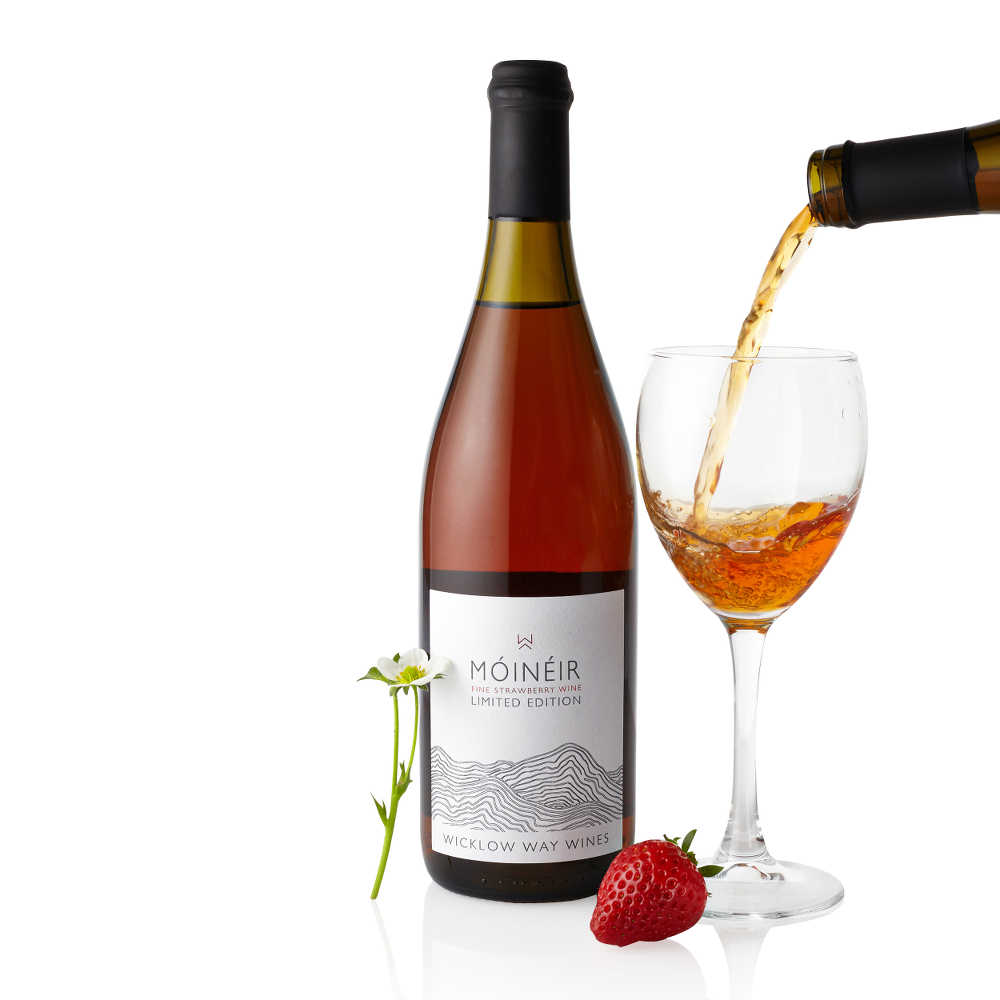
Their aromatic strawberry wine smells distinctly summery with that unmistakable fragrance of crushed, macerated strawberries. And it tastes like a wine, but with an unmistakable character of pure, ripe strawberries. It's off-dry in style, meaning it has a definite sweetness to it but one that is balanced with a refreshing acidity for a gorgeously tangy effect. As well as making a great aperitif, Brett says “it cuts through food really nicely.” They recommend it with nettle pesto and asparagus. It also pairs well with spicier fare such as Thai. But Brett’s favourite match is with avocado and salmon – often for a working lunch, enjoyed in the Wicklow air at the entrance to the winery.
“Once it’s been in the vats about six months, I like to pour a little glass from the tasting valve, and go sit out by the door…” Brett says, trailing off into a reverie. This could be another reason that the speed of labelling can’t keep up with the rate of sales, observes Pamela with a raised eyebrow and a smile.
Still, given their desire to work to live rather than the other way around, it sounds like they’ve hit on a recipe for success.
[First published in the Irish Independent]
---

Chairwoman of the Irish Food Writers’ Guild, Aoife Carrigy is a freelance food and wine writer and editor. She is a regular contributor to FOOD&WINE Magazine, The Irish Independent, The Herald and Cara Magazine, amongst others, and was co-author of The Ard Bia Cookbook and general editor of The ICA Cookbook, The ICA Book of Home and Family, The ICA Book of Tea & Company and, most recently, The ICA Book of Christmas. In 2015, she teamed up with Great Irish Beverages to launch the inaugural Dublin Wine Fest and Irish Cider & Food Day.
Quince - In Season
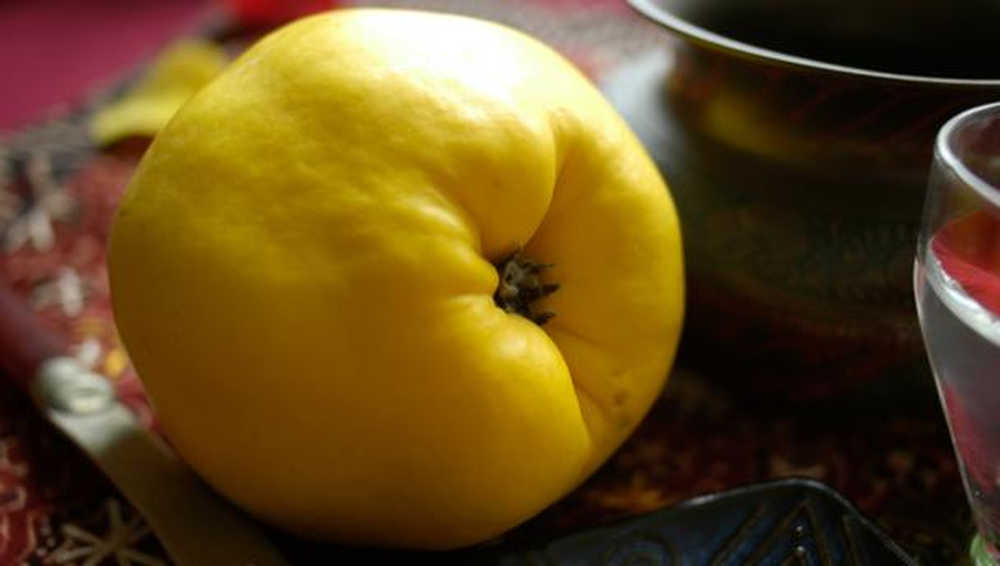

The new books highlighted by Darina Allen in her column this month include Gather, by Gill Meller (Quadrille, £25) and, from it, she selected the lovely recipe for pheasant and quince, given below.
“Look out for quince, they are in season at present,” she says. “You’ll find them in good greengrocers and at some Farmers Markets. A bright canary yellow fruit that resembles a slightly knobbly pear. They are deliciously perfumed and can have a downy fur on the outside. The fruit is always hard even when fully ripe. Use to make homemade membrillo - quince cheese or quince jam, delicious for Christmas presents or adds cubes of quince to pork or lamb stews or tagines. Alternatively give a quince tree to a foodie gardening friend, (cydonia oblonga) - a gift for life.”
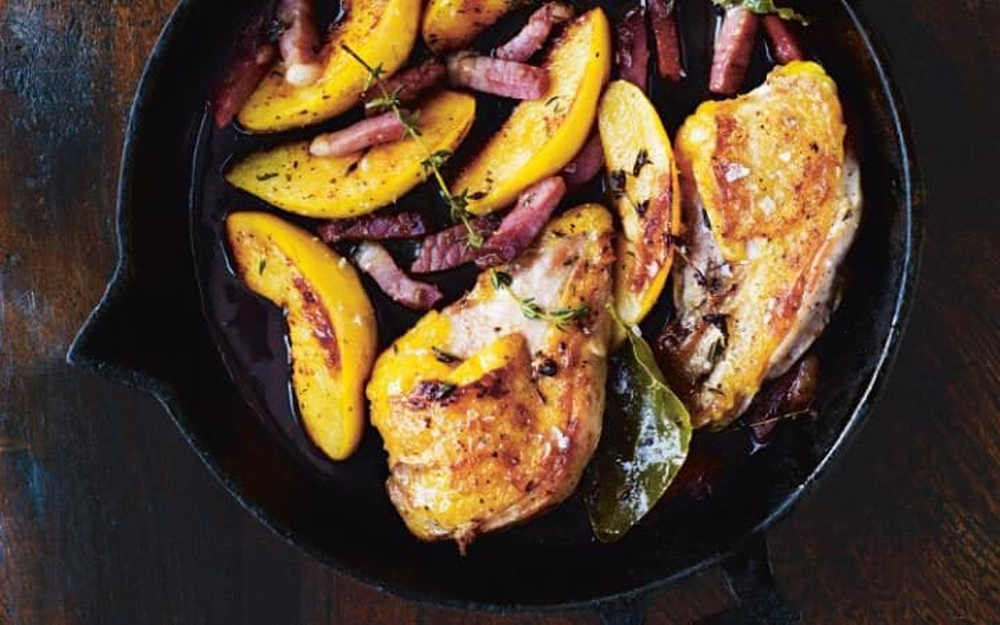
RECIPE: Gill Meller’s Fried Pheasant with Quince and Bay
From Gather, by Gill Meller (Quadrille, £25)
This rustic dish has an air of autumn about it. I like to think it’s got all the colour and patina of a hedgerow as its greens turn to soft, mottled yellows and light, earthy browns. The first pheasant of the season usually coincides nicely with the quince harvest.
You can prepare the quince well in advance – once cooled, it keeps beautifully in the fridge in its cooking syrup. If you’re not having pheasant, you can just as easily serve the quince alongside some good cheese and cold ham, or enjoy it sweet – with vanilla icecream.
Serves 2
Pared zest of ½ lemon
8 black peppercorns
2 bay leaves
1 teaspoon fennel seeds (optional)
2 thyme sprigs
75 g (2½ oz) sugar
2 tablespoons runny honey
2 quinces, peeled, quartered and cored
1 tablespoon extra-virgin olive oil
75 g (2½ oz) unsmoked bacon lardons
2 pheasant or guinea fowl breasts (about 150 g/2½ oz) each)
1 knob of butter
Salt and freshly ground black pepper
First, make the fragrant syrup. Place the lemon zest, peppercorns, bay leaves, fennel seeds (if using), thyme sprigs, sugar, honey and 300 ml/10½ fl oz of water in a medium pan. Place the pan over a medium heat and bring up to a gentle simmer.
Cut each quince quarter into 2 or 3 more evenly sized wedges. Place the wedges into the simmering syrup and cook very gently for 25-45 minutes, until the wedges are tender. (The cooking time can vary from quince to quince). When the quince are ready, remove from the heat, then use a slotted spoon to take them out of the pan and set aside.
Heat the olive oil in a large frying pan over a medium heat. Add the lardons and fry, stirring regularly, for 4-6 minutes or until the lardons are beginning to colour a little. Season the pheasant or guinea fowl breasts with salt and pepper and add them to the pan together with the cooked quince.
Cook the breasts for 2-3 minutes on each side, or until golden brown and cooked to your liking, and until the quince wedges are lightly caramelised. Remove the pan from the heat, then remove the breasts from the pan and set aside to rest.
Divide the lardons and quince wedges equally between two warmed plates. Then place the frying pan over a high heat and add 100 ml (3½ fl oz) of the fragrant syrup (save the rest to use a fruit syrup). Reduce this by half; take the pan off the heat and stir in the butter until melted; season to taste.
Cut each breast into thick slices and divide it equally between the two plates, arranging it next to the quince. Spoon over the syrup and serve straight away.
Gather by Gill Meller (Quadrille, £25)
Pancakes with Lemon - In Season
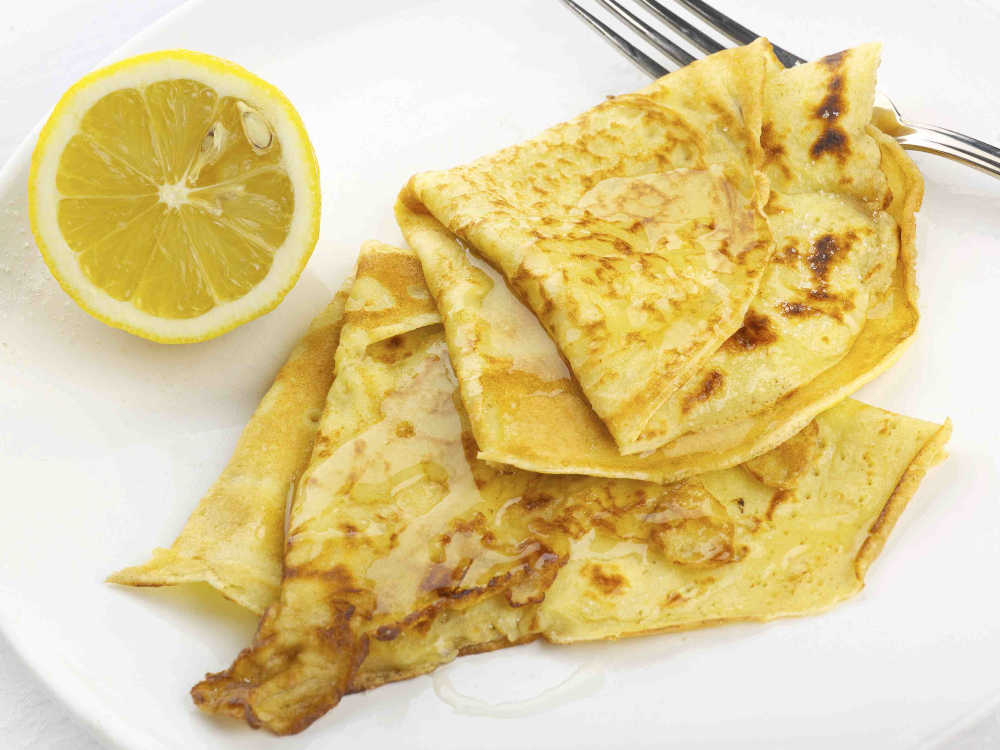

Shrove Tuesday (28th February this year) is one of the best loved culinary landmarks of the year for many families, because the traditional image it conjures up is very hard to beat: simple and mouth wateringly delicious pancakes, hot off the pan.
Although pancakes are very versatile - they can be folded, rolled or stacked, served with sweet or savoury fillings, and they freeze well too - many will agree that there is nothing to compare with the delicious simplicity of a sprinkling of caster sugar and a good squeeze of fresh lemon juice.
Lemons are available all year now, of course, but can it be coincidence that they are at their peak season just when they’re needed for using up kitchen perishables like milk and eggs in this last treat before Lent?
Simply Superb - a foolproof guide to cooking perfect pancakes
Like all very simple dishes, it’s important to get the basic techniques right: a good, heavy cast-iron pan is best, it must be preheated and very hot before any fat is added.
The best fat is not oil (and certainly not butter, which would be burnt black at the temperature required) but a hard block white cooking fat such as Frytex, which you smear over the pan very quickly to make a thin film of hot fat just before adding the batter.
Keep the batter in a jug beside the hob and use a ladle - the first pancake is always a disaster (but tastes just as delicious - cook's perk) but, once the pan is seasoned, it will work a treat and you very quickly learn to judge exactly the amount of batter needed to swirl around the pan and just reach the edges.
Basic Pancake Batter - makes about 8-10 pancakes.
l egg
4 oz/100g plain flour
½ pint/300ml milk
Pinch of salt.
Put all of the ingredients into a food processor or liquidiser in the order given and blend for a minute or so, until thoroughly mixed and smooth, with bubbles rising. Traditionally, a hand beaten batter is left to rest for an hour before use, but this is not necessary when using a blender or food processor.
Before cooking, pour the prepared batter into a jug and have it ready beside the cooker, with a ladle. Also have all the necessary warmed plates, caster sugar and lemon juice ready to hand as, once you start making the pancakes, you have to keep up the momentum and there's no time for anything else.
To cook, heat a heavy frying pan, preferably cast-iron, over high heat. Smear lightly with white cooking fat, leave a moment until just smoking, then pour on a ladleful of batter. Quickly tilt the pan around - if you have judged the amount of batter correctly, it will just thinly cover the whole of the base of the pan.
Cook for about a minute, until the top is set and the bottom browned, then flip (or toss) over and cook the other side for about half a minute. Slide onto a warm plate, put the pan back onto the heat, sprinkle with caster sugar and lemon juice, roll up quickly and pass to the first taker.
Re-grease the pan and continue in the same way until all the batter has been used up.
In polite households it may seem more appropriate to keep the pancakes warm and serve everyone at the same time -it is certainly more polite, but they never taste as good.
Baking - In Season


Georgina Campbell
For some reason I always feel that - apart from the big baking build up to a traditional Christmas - March is the month when the gentle rituals of baking really come into their own. While bright and brave, with its cheery bulbs in flower, it can be a harsh month and the idea of spending hours creating delicious bakes in a cosy kitchen seems very appealing.
There are special occasions, too, at this time of year that are especially suited to tea time treats - Mother’s Day, for example, which was originally Mothering Sunday and celebrated with a cake made by young servant girls in big houses, who were allowed to go home for the day and bring a cake to contribute to their family get together.
All that may be news to many today, but it has far more relevance than our commercial modern alternative - something well worth remembering and celebrating with a really good cake. So what could be better than one that is regularly made at Ballymaloe House, home to the mother of our renewed confidence in Irish food and cooking, Myrtle Allen? We’ll raise an appreciative tea cup to that.
RECIPE: Ballymaloe Lemon Cake
The gentle ritual of Afternoon Tea is a relaxing interlude in the day for guests at Ballymaloe House, who are treated to a choice of wonderful cakes and bakes created by talented pastry chef, JR Ryall. This recipe is used at least once a week in the pastry kitchen at Ballymaloe, where they say simply that “It is best enjoyed with a cup of tea in the afternoon.” It would make a lovely treat for Mother’s Day or Easter.
Cake:
8 oz/ 225g caster sugar
8 oz/225g butter (room temperature
4 large eggs
8oz/225g plain white flour
1 level teaspoon baking powder
zest of 1 lemon
Butter icing:
2oz/55g butter (room temperature)
4oz/110g icing sugar
zest 1 lemon
1 tablespoon/15ml lemon juice
3 tablespoon/45ml lemon curd
Glacé icing
6oz/170g icing sugar
lemon juice
METHOD:
7 inch/18cm round cake tin x 3 inch/7.5cm deep
Preheat the oven to 180ºC.
Line the base of the cake tin with non stick baking parchment or a spare butter wrapper and brush the sides of the tin with melted butter and dust with flour.
Cream the butter, sugar and lemon zest until pale and light in texture. Whisk the eggs in a separate bowl and gradually add to the creamed butter and sugar, bit by bit, mixing well between each addition.
Sieve the flour with the baking powder. Gradually and gently fold the flour into the cake mixture until the mixture is an even consistency. Transfer the mixture into the cake tin and smooth over the surface with a palate knife.
Bake for 45-50 minutes or until a skewer inserted into the centre of the cake comes out clean. Allow to rest in the tin for 10 minutes before turning out onto a wire rack and when cool carefully cut the cake in half.
To make the butter icing, cream the butter, sieved icing sugar, lemon zest and juice together until pale and light in texture. Spread on top of the bottom half of the cake. Neatly spread the lemon curd on top of the butter icing before sandwiching with the top half of the cake.
To make the glacé icing sieve the icing sugar into a small bowl and add enough lemon juice to make a thick smooth icing and spread it over the top of the cake using a palate knife, allowing any excess to dribble down the sides.
Decorate with crystallised lemon verbena leaves and rose petals.
Asparagus - In Season

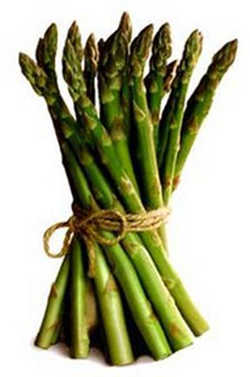
Georgina Campbell
Asparagus is all too familiar as an all-year flown-in product, but locally grown asparagus is a different thing altogether. It was once widely grown in walled gardens and flourishes in many areas of Ireland - where it would be nice to see it back in production again.
Asparagus is hugely popular in northern Europe, where ‘asparagus menus’ are a speciality in restaurants in asparagus-growing areas at this time of year, and include white (blanched) asparagus as well as the green asparagus that is more familiar here.
In England, after years of struggling to compete with imports, asparagus growers are currently experiencing an upturn, as customers keen to support local produce understand the need to pay a premium and are happy to do so - and the same thing could happen here.
Its short season begins in late April and only lasts six to eight weeks - traditionally cutting finishes on Midsummers Day - but that is part of its charm, and its delicate flavour and seasonality makes it highly desirable in the kitchen.
Although not often seen in shops, it is worth looking out for Irish grown asparagus at small shops that may be supplied by local gardeners. It may be found at farmers’ markets too, especially in the South-West where the warmer climate and sandy soil suit it well.
Peter and Marita Collier of Drummond House at Baltray, Co Louth, have built up a reputation for their garlic production in the last few years, and they also grow asparagus. They now supply some of Ireland’s top chefs, including PJ McMahon of the famed Aniar in Galway. But they also supply some to Brid Carter of Honest2Goodness Market in Glasnevin, Dublin 9, where you can buy it on Saturdays (9.30-4) when available.
Marita knows there are other asparagus growers dotted around Ireland and would love to establish a network - anyone interested can contact her on 087 688 2202, or email: hello@drummondhousegarlic.com
And asparagus is much more than just a pretty vegetable. It has long been recognised for its medicinal qualities and is a good source of dietary fibre, protein and many vitamins, minerals, trace elements; low in calories and sodium, it has diuretic properties and is high in antioxidants. But, for all its health properties, its sheer deliciousness remains the best reason for seeking it out.
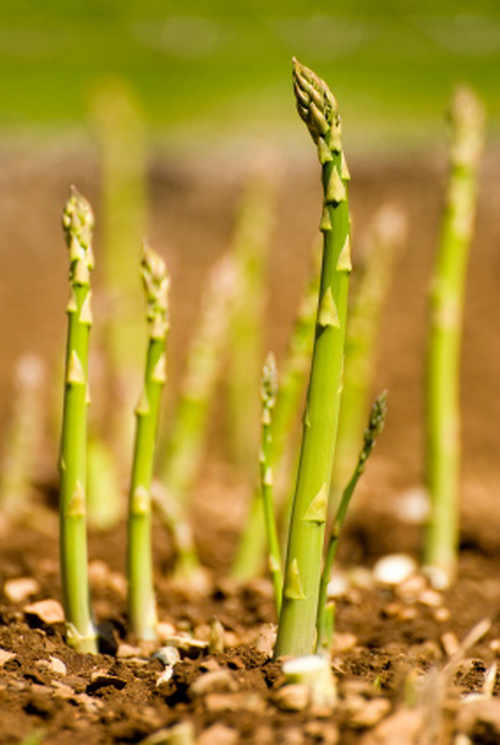
When buying, look for very fresh, firm asparagus with tightly furled tips. Before use, cut off the woody base of the stalk, or break the stems where they snap easily leaving the tough lower ends behind.
Bundles of asparagus are best boiled upright so that they cook evenly - ideally premium quality asparagus is best eaten steamed or semi-boiled (ie standing in a tall pan, with the lower stems in water and the tender upper section in steam), and served very simply as a starter with hollandaise (see recipe below), vinaigrette, melted butter or olive oil, Parmesan cheese, or even mayonnaise.
When plentiful and inexpensive, it makes a useful side vegetable and can be roasted in a little olive oil or char-grilled. It is a versatile ingredient for a wide range of dishes, from salads (used raw or cooked) and stir-fries to omelettes, risottos, quiches, tarts, soups and terrines. Eggs partner perfectly with asparagus and other flavours that work well include tarragon, butter, some cheeses (e ricotta, mascarpone, parmesan), Greek yoghurt, lemon, bacon and ham.
If you have a large garden or allotment, why not consider growing asparagus. It is a beautiful feathery-foliaged herbaceous perennial that grows to about 1 metre/3ft tall and - although it requires space and takes several years to develop enough of the precious stems to allow harvesting - it is a rewarding crop and 2 year old crowns that will establish quickly can be bought from English Fruit Nursery at Enniscorthy, Co Wexford (053 9240984 / 053 9240504; Email: info@englishsfruitnursery.ie )

RECIPE: Buttered Asparagus With Hollandaise Sauce is a classic treat that makes the most of delicious seasonal asparagus.
This recipe is from Kevin Dundon’s lovely go-to cookbook - Full On Irish - Creative Contemporary Cooking.
Hollandaise sauce should be lightly piquant and have a smooth pouring consistency. If it is too thick, add a little water or vinegar. It is a sauce which curdles easily. If this begins to happen, add an ice cube and whisk well; the sauce should come back together.
Serves 4-6
20-30 asparagus spears, trimmed
knob of butter
for the Hollandaise sauce
1 tbsp/1 1/4 US tablespoons
white wine vinegar
1 tbsp/1 1/4 US tablespoons
fresh lemon juice
3 egg yolks
about 100g/4oz/1 stick unsalted butter
salt and freshly ground white pepper
To make the hollandaise sauce, place the vinegar in a heatproof bowl with the lemon juice and egg yolks and a pinch of salt.
Whisk until thoroughly combined, then set the bowl over a pan of simmering water on a low heat and whisk for about 3 minutes until the mixture is thick enough to leave a trail when the whisk is lifted.
Meanwhile, melt the butter in a small pan or in the microwave. Gradually add to the egg yolk mixture, a little at a time, whisking constantly. When approximately 75g/3oz/ 3/4 stick has been added, season lightly with salt. If it is still too sharp, add a little more butter. Season to taste and keep warm.
Meanwhile, cook the asparagus spears for 3-6 minutes, depending on their size, in a large pan of boiling water or in a steamer standing in 7.5cm/ 3in of boiling water until just tender. Drain, return to the pan, and quickly toss in the knob of butter.
To serve, tip the asparagus onto a warmed serving plate and spoon over the hollandaise sauce, or serve it separately in a warmed jug and allow everyone to help themselves.
Fermenting - In Season
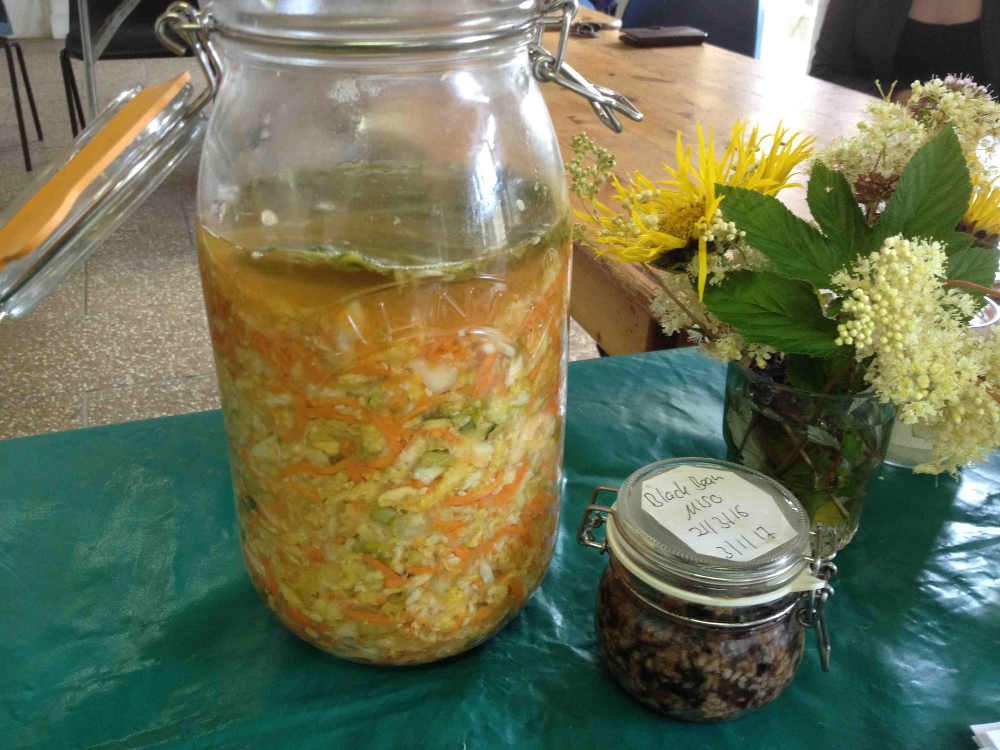
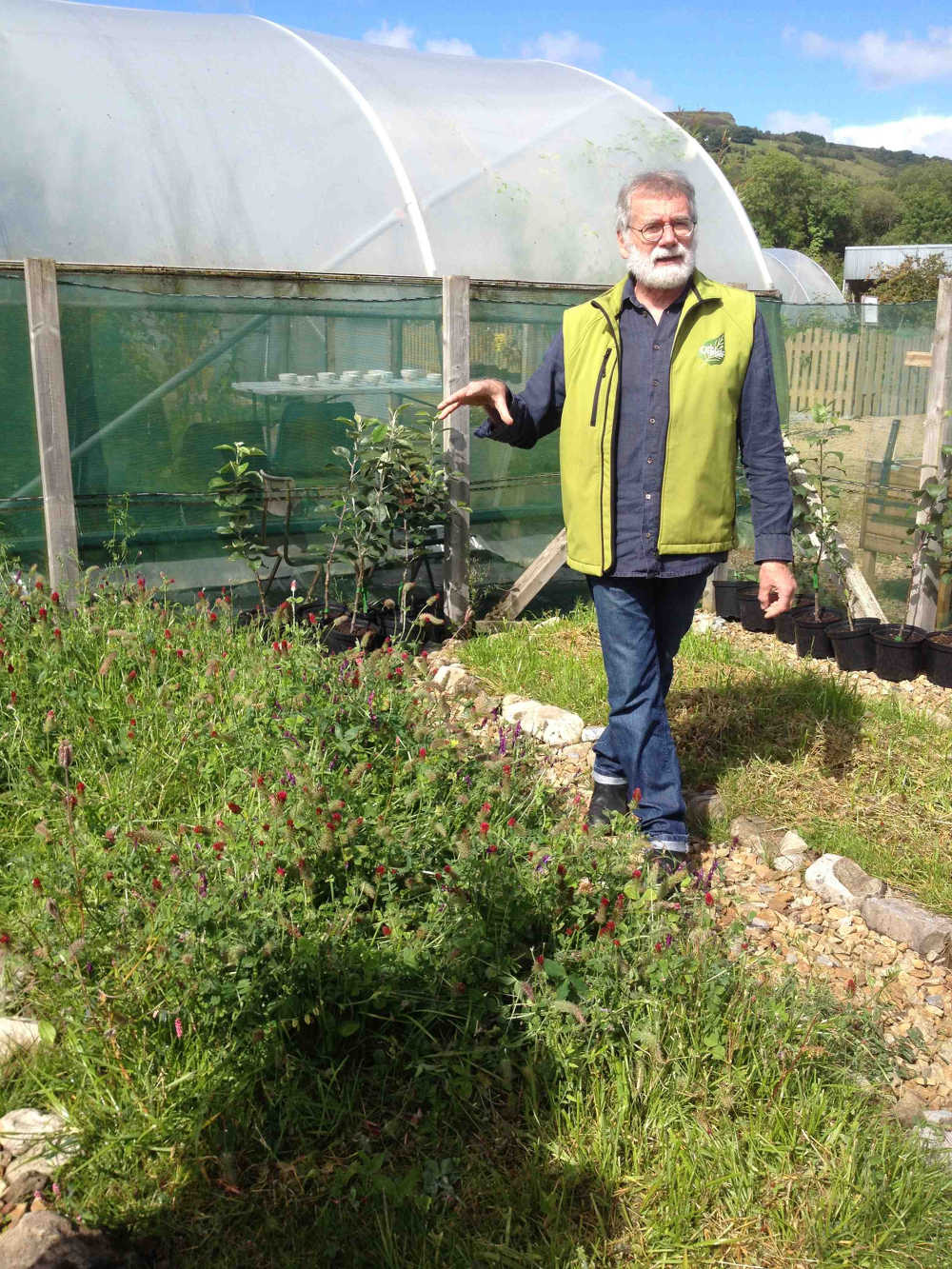
Georgina Campbell
In August, Irish Food Writers’ Guild members visited The Organic Centre in Rossinver, Co Leitrim, where Hans and Gaby Wieland showed us around the wonderful (and highly educational) gardens and treated us to one of the short courses that they hold regularly at the Centre.
August being such a prolific month, the focus was on preserving the season’s bounty for the winter months. Their simple guideline when it comes to choosing preservation methods is ‘Keep the nutrients in!’, and fermenting - which is easier than you might think - is one of their favourites.
Their next Organic Centre Fermentation Workshop is on Saturday 23rd September 10am-4pm, including a light lunch. It’s interesting to learn how the ancient food preserving technique of fermentation can create super nutritious and tasty dishes.
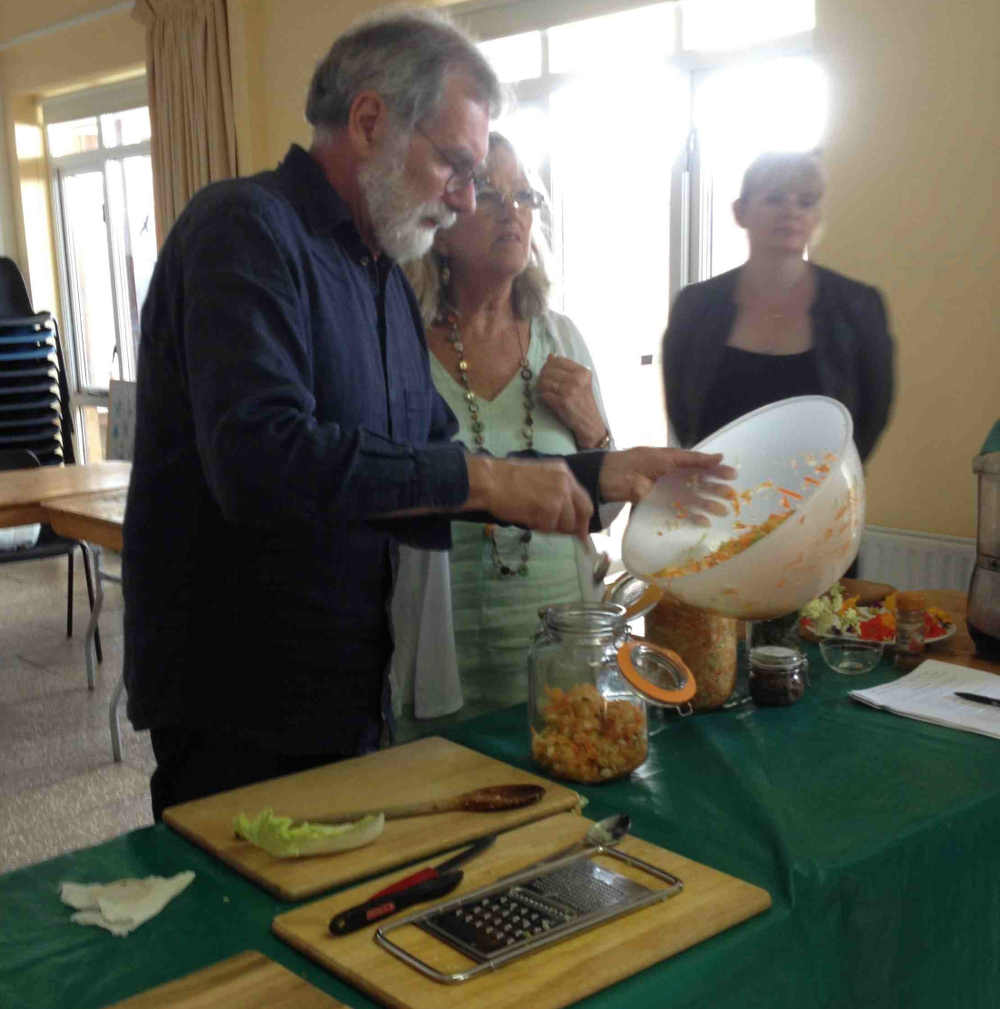
Gaby and Hans show how to ferment vegetables and explain recipes for making miso, daikon radish kimchi, fermented squash hummus and beet kvass eggs. Fermented drinks include kombucha, kefir and wild lemonades. Their workshops include practical sessions and demonstrations, finishing up with a taster plate.
The courses are interactive, useful and fun - good value at €70 and well worth attending.
RECIPE: Sweet and Spicy Kimchi
This is a traditional Korean dish that dates back 3000 years. It's a cultured vegetable dish that is spicy and rich in flavor. Kimchi is a fabulous healthy side dish, topping to a sandwich or eaten alone.
• 1 Napa/Chinese or Savoy cabbage, or white cabbage, finely shredded (We usually use Chinese cabbage or savoy cabbage)
• 3 Carrots, finely shredded
• 1 Cucumbers, de-seeded and finely shredded
• 1 Bunches scallions, thinly cut into diagonal pieces
• 1 Apple, finely shredded
• 2 Small oranges, peeled, sectioned and chopped into small pieces - optional
• 2 teaspoons, garlic minced
• 1/2 teaspoon, cayenne
• 2 tablespoons, sesame seeds
• 2 teaspoons sea salt or Himalayan pink salt
1. Keep one large outer leave of the cabbage.
2. Place the shredded cabbage in a large mixing bowl with salt and gently massage to release the cabbage juice. Do this several times; cabbage needs to be floating in its own juice.
3. Add the remaining ingredients and mix well.
4. Firmly pack the vegetable mixture with the juice into a gallon glass jar. Cut the large leave of cabbage into the shape of jar and cover the vegetable mixture. Place a pint size, water filled, and tightly covered glass jar on top of the veggies to keep them submerged in the liquid while fermenting.
5. Cover with a clean tea towel or muslin and store in a warm dry place for 2 days. After 2 days check flavor, and if it's to your fermented taste, you're done. If you like more tartness let it go for another day and check again.

Health benefits of Kimchi
Koreans eat so much of this super-spicy condiment that natives say “kimchi” instead of “cheese” when getting their pictures taken. Kimchi is loaded with vitamins A, B, and C, buts its biggest benefit may be in its “healthy bacteria called lactobacilli, found in fermented foods like kimchi, yogurt …
It will help digestion, plus it seems to help stop and even prevent yeast infections, according to a recent study. And some studies show fermented cabbage has compounds that may prevent the growth of cancer.
Tip
If you have no time to make your own, you might be able to pick it up in the refrigerated section of an Asian store, your local health food store or delicatessen shop, or Polish shops and serve with small bowls of the warm potato salad on the side.
In Season - Seville Oranges
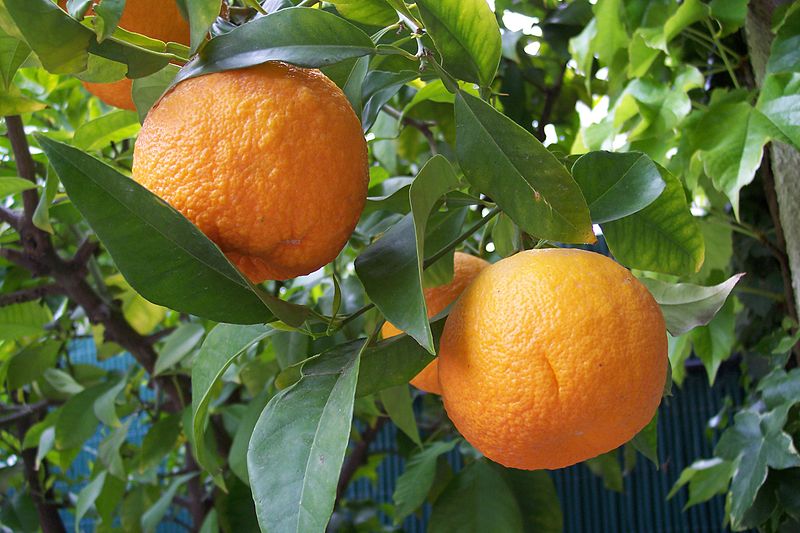
It's a happy coincidence that – although now available all year round – vitamin-packed citrus fruits are in their peak season in January and February, bringing the scents and flavours of sunnier climes just when we need them most.
A high proportion of the world’s citrus production is processed, mostly as frozen concentrated juice, but there is nothing to beat the flavour and texture of fresh fruit in the peak of its season – memorable if you have ever had the pleasure of enjoying fruit straight from the tree, even an ornamental tree grown in a tub at home in Ireland. (I have lemons ripening on a potted tree at the moment, which is something to look forward to soon.)

Unlike their juicy sweet-fleshed relations, which are so delicious used fresh and for juicing, bitter oranges are used mainly in cooking, and for their essential oil, which is used for its scent and flavour. Variously known as the Seville Orange (named after a major growing area), sour orange, bigarade orange, and marmalade orange, it is the fruit of a citrus tree, Citrus × aurantium.
Bitter oranges – for marmalade and, perhaps, sauces and accompaniments including variations on the traditional orange sauce ‘bigarade,’ for serving with duck – are in season for just a few short weeks, and it is well worth getting some now even if you are busy, as they freeze down well for use later in the year. (A 3 lb/1.5 kg batch is perfect for marmalade, see below).
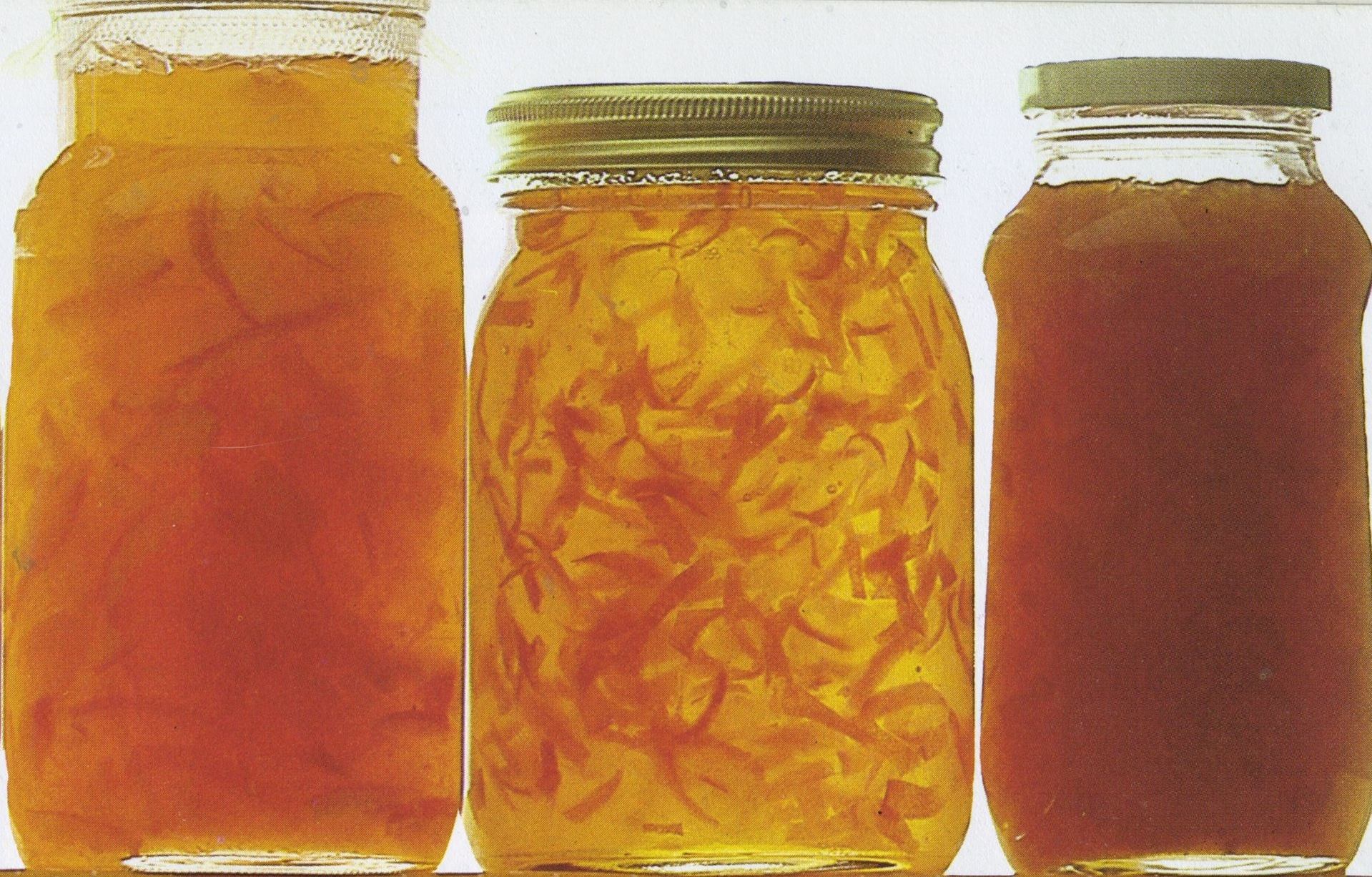 Favourite Mincer Marmalade
Favourite Mincer Marmalade
This was my father’s favourite marmalade recipe and it’s the one I normally use, as it is easy and convenient, whether made with fresh or frozen oranges. Quantities given make about 9 lb/4. kg marmalade, but it is handy to double them if you have a suitable pan.
2 large lemons
3 lb/1.4 kg Seville or other bitter oranges
5 pints/3 litres water
6 lb/2.7 kg granulated sugar
Squeeze the lemons and reserve the juice. Scrub the oranges and pick the discs off the stalk ends, then put the whole oranges and lemon peel into a large, heavy-based pan and cover with 4 pints/2.3 litres of the water. Cover, bring to the boil and simmer for about 1½ hours, or until the peel is quite soft.
Lift the oranges and lemon peel out with a slotted spoon, reserving the liquid. Halve the oranges as soon as they are cool enough to handle and scoop out the flesh and pips into a smallish pan. Add the remaining l pint/600ml of water, bring to the boil and simmer for 10 minutes to extract the pectin from the pith and pips. Cut up the softened peel as coarsely or as finely as you like, or put it through a mincer. (This looks messy at the time, but works out OK; you could also use a liquidiser/food processor but you have to be very careful not to purée the peel).
Put the prepared peel back into the pan containing the cooking liquid, then add the sugar, lemon juice and the strained juice from the pith and pips mixture. Stir over low heat until dissolved (this will be quicker if the sugar has been warmed in a low oven beforehand), bring to the boil and boil fast for about 15-20 minutes until setting point is reached.
Take the pan off the heat and allow to cool for 10-15 minutes, then stir well to distribute the fruit evenly and use a small jug to pour it into clean warm jars. Small waxed discs may be put on top of the marmalade immediately, but don't cover with cellophane or lids until absolutely cold, as this reduces the chance of condensation forming and consequently the risk of mould formation during storage. Label and store in a cool, dark place.
Hints for success:
- Cooking citrus fruit takes much longer than other fruits because of the thickness of the peel, so much more water is needed to allow for evaporation. By the end of the first cooking stage, the contents of the pan should be reduced by half and the peel must be very soft - once the sugar is added, the peel will not soften any more.
- Pectin and acid content is important to obtain a good set in all jam and marmalade making; lemon juice is added to Seville orange marmalade to supply the extra acid needed to get a good set and prevent crystallisation.
- When the sugar is added it must be dissolved over low heat before bringing the temperature up to the boil. Once dissolved, a fast rolling boil is needed to bring the marmalade up to boiling point. To allow for safe fast boiling, the reduced pulp should not come more than halfway up the pan. If you don't have a big heavy-based pan suitable for preserves, why not consider sharing one with friends? Alternatively, you can hire preserving pans or big heavy-duty Castle Brand saucepans from some speciality kitchen shops.
-The longer you boil, the darker the colour and more 'mature' the flavour, but over-boiling produces a half-set, syrupy preserve. If your marmalade has reached setting point and you prefer it darker, add a spoonful or two of treacle instead of boiling longer.
- Setting point is reached when a sugar thermometer reaches 221ºF, 105ºC, or when a little jam cooled on a cold saucer wrinkles when pushed with a finger or spoon.
- To keep well, the marmalade must be poured into jars which are clean, dry and warm, then left until completely cold before covering. Store in a cool, dark place.
- Even if you don’t have time to make marmalade at the time, get the oranges as the season is very short and they freeze well - just make sure that you choose a recipe which involves cooking the oranges whole and freeze them in weighed batches. If they're likely to be in the freezer for a long time, add an extra orange or two per batch to allow for any loss of pectin during storage - or add a couple of sweet oranges or grapefruit at the time if you leave them longer than anticipated.
In Season - Autumn Fruits & Foraging

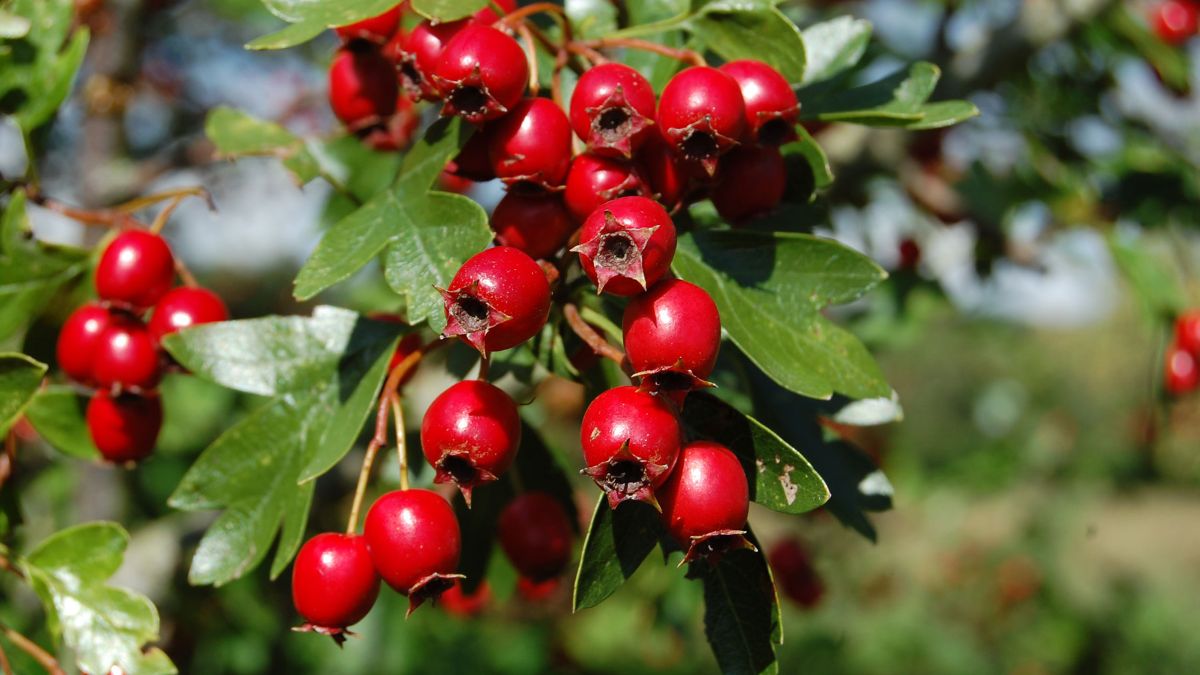
One of the regular highlights in our Inbox here at ireland-guide.com is the monthly newsletter from Neantóg, Gaby and Hans Wieland’s organic Garden, Kitchen & School at Cliffony, Co Sligo. Always brimming with good cheer, good ideas and good sense, it’s a real tonic. And Neantóg is the Irish word for nettle which, far from being ‘just a weed’, is as they say on their website, ‘nourishing, healing and energising -and these qualities inspire our teaching on our courses in organic gardening, plant-based cooking, sourdough baking, fermenting and foraging’. This month’s Neantóg newsletter is a corker, with contents including the results of their 2023 Pepper and Chilli trial, a piece about green manures for soil fertility, Community Garden News, recipes for seasonal produce (notably apples at the moment) - and their Plant of the month, which is the often overlooked Hawthorn (Whitethorn - Crataegus ocyacanthoides).
Hawthorn belongs to the Rose family. It grows in hedgerows, scrub and woodland margins. The thorny shrubs or small trees have clusters of white or pink flowers in spring followed by deep red berries in autumn. It survives poor soils and high winds. Now is the time to harvest the red berries of hawthorn and either dry them, make a tincture or use them in the kitchen (see chutney recipe below). You can also make hawthorn berry elixir, hawthorn berry leather to use as a snack, chutney or ketchup.
Rich in antioxidants and best known for its relation to the heart, Hawthorn has been used as a herbal remedy for hundreds of years, notably as a circulatory tonic which is said to protect and strengthen the heart muscle and its blood supply. NB: If you have any warning signs relating to the heart, you should always get a check-up with your doctor first, and if you are on medication it is best to arrange a consultation with a herbalist.
Bearing that caution in mind, hawthorn can be used for:
• Mild to moderate hypertension
• Rapid heartbeat and thrombosis
• It is a very safe herb and can be taken long term
• It has calming qualities and can help to reduce anxiety and mood swings
• It also helps to lower cholesterol
• It is also used for treating digestive problems
RECIPE:
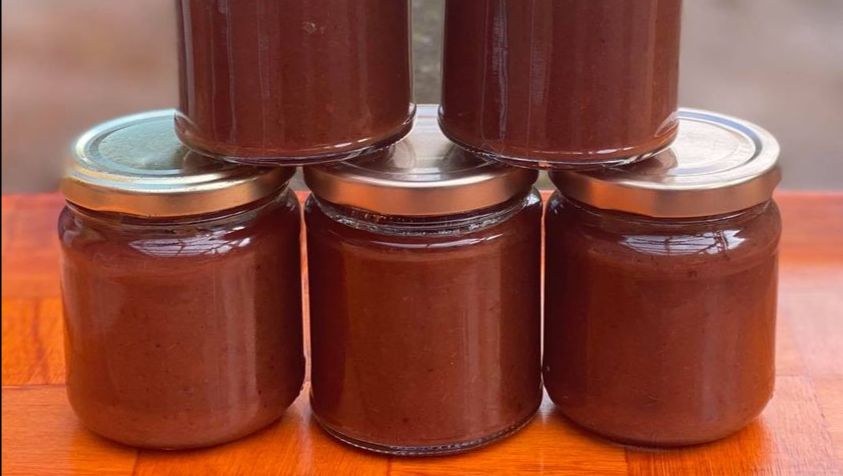 Hawthorn Berry Chutney
Hawthorn Berry Chutney
Hawthorn berries are normally abundant in September, you just have to find the right spots. This recipe is a fun way to add interesting new flavours to your dishes with its tart, tangy taste. (NB: If you are new to foraging, use a guide book for identification.)
Ingredients:
1kg Hawthorn berries
500ml cider vinegar
350g brown sugar
1 tsp ground ginger
½ tsp ground nutmeg
¼ tsp ground allspice berries
1 tsp sea salt or Himalayan salt
black pepper
Small handful of thyme - optional
Method:
1. Remove the stalks from the hawthorn berries.
2. Wash the berries and place in a large saucepan.
3. Add the cider vinegar and salt and bring to the boil.
4. Once boiling, reduce the heat to a simmer and cover and cook for one hour.
5. Pass the contents of the saucepan through a metal sieve or food mill and be sure to remove all the pulp from beneath the sieve or food mill.
6. Return to a clean saucepan.
7. There will be around 1 pint / 600ml of pulp.
8. Remove the leaves of the thyme sprigs and chop finely.
9. Add the spices, sugar and some black pepper to the pulp and cook, stirring continuously, for 5-10 minutes.
10. Stir in the thyme leaves, if using, at the end of the process.
11. Fill into sterilised hot jars, seal tightly, turn upside down for a minute and back again. Cover with a kitchen cloth until cooled down.
12. Let it mature for 2-4 weeks before use.
Note: The yield will be around 5 x 200g jars. You can easily double the recipe to make a lovely stock of presents for your friends and neighbours
Show me all Article


